Amazon has renewed Fallout for a second season. I’ve been watching this with my son and we’ve been enjoying it so far.



This site is made possible by member support. 💞
Big thanks to Arcustech for hosting the site and offering amazing tech support.
When you buy through links on kottke.org, I may earn an affiliate commission. Thanks for supporting the site!
kottke.org. home of fine hypertext products since 1998.
Entries for April 2024
Mike Masnick shares how he uses AI to help write Techdirt. “No, it’s not to write articles. It’s basically to help me brainstorm, critique my articles, and make suggestions on how to improve them.”
Art Celebrity Doppelgängers

Whenever Beauford Delaney’s Portrait of Howard Swanson (1967) pops up in MoMA’s New Tab extension in Chrome, I’m like, “Jerry Seinfeld?!”
There are a number of celebrities who have art doppelgängers — the Robert De Niro and John Krasinski ones are particularly good. Have you noticed any of these?
A lovely profile of Daniel Radcliffe. “If there’s a sweet spot to be found between deeply fucking weird and strange and almost unsettling, and kind of wholesome and earnest and very sincere, then that’s the stuff I really love doing.”
The JWST recently captured the Horsehead Nebula in “unprecedented detail”.
The AP is reporting that the DEA will reclassify marijuana as a Schedule III drug in a “historic shift”.
AI Image Feedback Loop
Data artist Robert Hodgin recently created a feedback loop between Midjourney and ChatGPT-4 — he prompted MJ to create an image of an old man in a messy room wearing a VR headset, asked ChatGPT to describe the image, then fed that description back into MJ to generate another image, and did that 10 times. Here was the first image:

And here’s one of the last images:

Recursive art like this has a long history — see Alvin Lucier’s I Am Sitting in a Room from 1969 — but Hodgin’s project also hints at the challenges facing AI companies seeking to keep their training data free of material created by AI. Ted Chiang has encouraged us to “think of ChatGPT as a blurry jpeg of all the text on the Web”:
It retains much of the information on the Web, in the same way that a jpeg retains much of the information of a higher-resolution image, but, if you’re looking for an exact sequence of bits, you won’t find it; all you will ever get is an approximation. But, because the approximation is presented in the form of grammatical text, which ChatGPT excels at creating, it’s usually acceptable. You’re still looking at a blurry jpeg, but the blurriness occurs in a way that doesn’t make the picture as a whole look less sharp.
And we already know what you get if you recursively save JPEGs…
See also La Demoiselle d’Instagram, I Am Sitting in a Room (with a video camera), Google Image Search Recursion, and Dueling Carls.
Super cool photos from this story about a nuclear-powered submarine. Interesting detail: “Day 31 is sometimes the lowest morale day while underway. App downloads expire: Spotify, Netflix, etc.”
I love watching these genetic algorithm thingies. “The program uses a simple genetic algorithm to evolve random two-wheeled shapes into cars over generations.”
Check In On Those Around You
This is a powerful public service announcement about mental health from Norwich City FC and Samaritans (note the content warning at the start of the video). That’s all I’m going to say about it — just watch it.
“It’s clear to me that sharing our shortcomings and weaknesses with each other is our greatest strength. Our salvation.” I was very moved by this By the Book interview with former NFL player Steve Gleason. His book is out today.
A live-action, 1950s version of The Simpsons, imagined by AI. From the same person who did 50s Futurama and Harry Potter by Balenciaga.
“Letter to the Person Who Carved His Initials into the Oldest Living Longleaf Pine in North America”

That’s the title of a poem by Matthew Olzmann. It begins:
Tell me what it’s like to live without
curiosity, without awe. To sail
on clear water, rolling your eyes
at the kelp reefs swaying
beneath you, ignoring the flicker
of mermaid scales in the mist,
looking at the world and feeling
only boredom.
You can read the rest at Tin House.
From Lacy M. Johnson in Orion Magazine, The Brutal Legacy of the Longleaf Pine:
The oldest longleaf pine tree in the world, I remember, is a nameless tree in Weymouth Woods in North Carolina. It is roughly 474 years old, taking root around the time Michelangelo took over construction of the dome of St. Peter’s Basilica, fifty-nine years before European colonizers arrived at Jamestown. In 2016, when the tree turned 468, visitors to the North Carolina State Parks system held a “Party for the Pine.” They celebrated by hiking to the tree, cutting cake, singing it “Happy Birthday.”
Illustration above of a longleaf pine by Edith Zimmerman.
From 1994, a collection of segments from a screening of The Grinch hosted by Phil Hartman. Seuss’s widow drives a Cadillac with customized “GRINCH” license plates called the Grinchmobile!
With MovieCart, you can create Atari 2600 cartridges that will play full-length movies. “Joystick controls brightness, volume, and shuttle position. Console switches control b/w, ten second rewind and full rewind.”
Drawing Media, an Interview With Zaria Forman

Edith here. For the latest installment of my newish illustrated column, I interviewed my friend and neighbor, the artist and climate activist Zaria Forman. Zaria makes pastel drawings of ice, among other things, and her solo show “Fellsfjara, Iceland” is currently on exhibition at Winston Wächter gallery in New York until May 4. (I’ve rendered a miniature version of some of it right below these words, but definitely click here for the actual images.) Zaria is also on Instagram.


Zaria, have you read, watched, listened to, or otherwise experienced anything good recently?
Poor Things. It was so visually stimulating and imaginative — more than anything I’ve seen in a while.

Possibly more interesting: the ice storm a few weekends ago! I’d never seen an ice storm before moving to upstate New York, and although the storms are destructive, they’re so beautiful. It was the most spectacular one I’ve ever experienced.
Seen anything bad?
Mr. and Mrs. Smith, the new version. I thought it was poorly cast and just plain dumb. OR: All the mud, now that the ice has melted ;)
What’s something you’ve read or seen that changed your life?
Seeing glaciers and icebergs for the first time absolutely changed my life. But if we’re sticking to books, etc., one that changed my way of thinking was Love Between Equals: Relationship as a Spiritual Path, by Polly Young-Eisendrath.
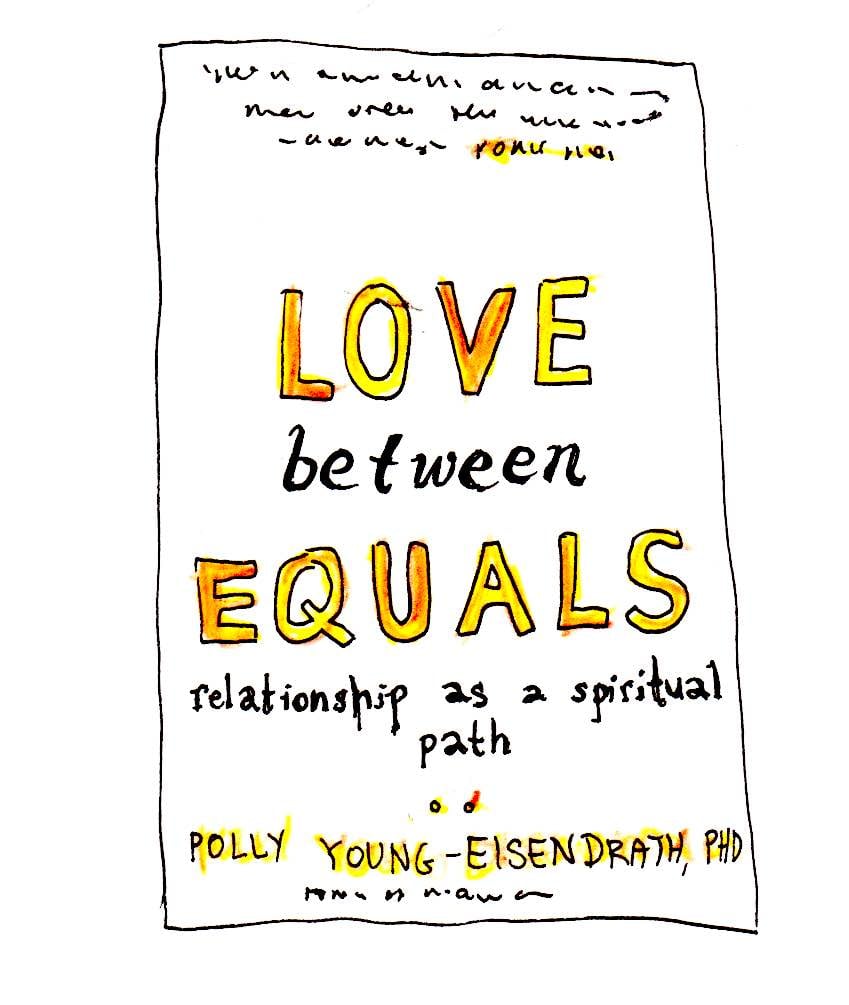
She’s a psychologist and couples therapist, and the book just kind of reframed the idea of relationships in my mind — of how you relate to someone you’re in a long-term relationship with, and how you can grow with them. And how, like, love is.
She talks about radical acceptance, fully accepting someone for who they are, learning how to do the same for yourself, and then figuring out how all of that can work together.
Another one that changed my way of thinking was Sex at Dawn: How We Mate, Why We Stray, and What It Means for Modern Relationships, by Christopher Ryan and Calcida Jetha.
Does anything make you laugh online?
Memes on Instagram!
What’s a recent one?
I just forwarded you the last one I sent to [my husband] this morning.

Are there any cultural moments you currently think about unusually often? Like are you haunted by a moment from a TV show, or anything like that?
More “inspired” than “haunted,” but the artists Ray and Charles Eames made a 10-minute documentary in 1977 called “Powers of 10” that made a big impact on me. The Tang Teaching Museum in Saratoga Springs exhibited the film in a show during my years at Skidmore College, and it’s probably the one film I think about more than any other.
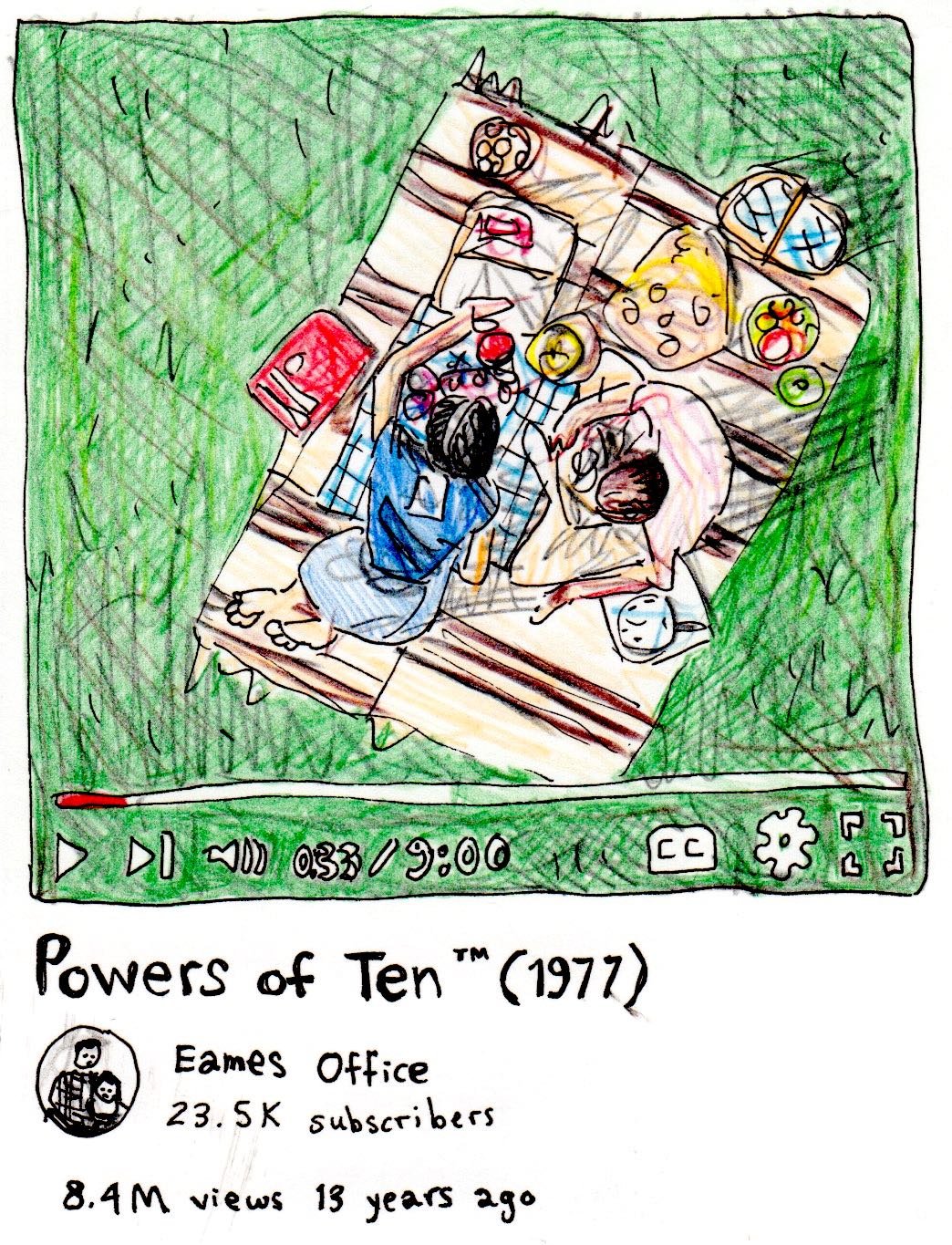
What’s it about?
It starts with a couple on a blanket having a picnic by a lake in Chicago. And then from one of their hands, the camera zooms back 10 meters. And then it continues zooming back by powers of ten. And so you see these squares get smaller and smaller, and it keeps going into the atmosphere, and the solar system, and it’s just mind-boggling how it keeps going.
And then it then zooms back down to the picnic and goes into their skin and all the way down to, like, a molecule inside the body. And it’s crazy to see the similarities between the two.
It’s on YouTube, if you want to watch — I highly recommend!
What were you really into when you were 12?
My So-Called Life, singing along to Alanis Morissette, and a boy named Ben.

Is there a book/movie/whatever you’d like to experience again for the first time?
Burning Man. There’s just no way to really know what it’s like until you’re there, in the middle of it. And when you know what to expect, it’s not as thrilling. But as a climate activist, it doesn’t feel right to continue attending over and over.
What’s a funny or weird way people have described your art?
As “finger painting.” It was a term used first (I think) in the Daily Mail, and then almost every writer used it to describe my work for several years. I wince at a line I say in my TedTalk: “I cringe when people call me a finger painter,” or something like that — my tone just sounds so snobby, I hate it — but I was attempting to detach my work from the term, and it did finally work. It pops up every now and then, but rarely.
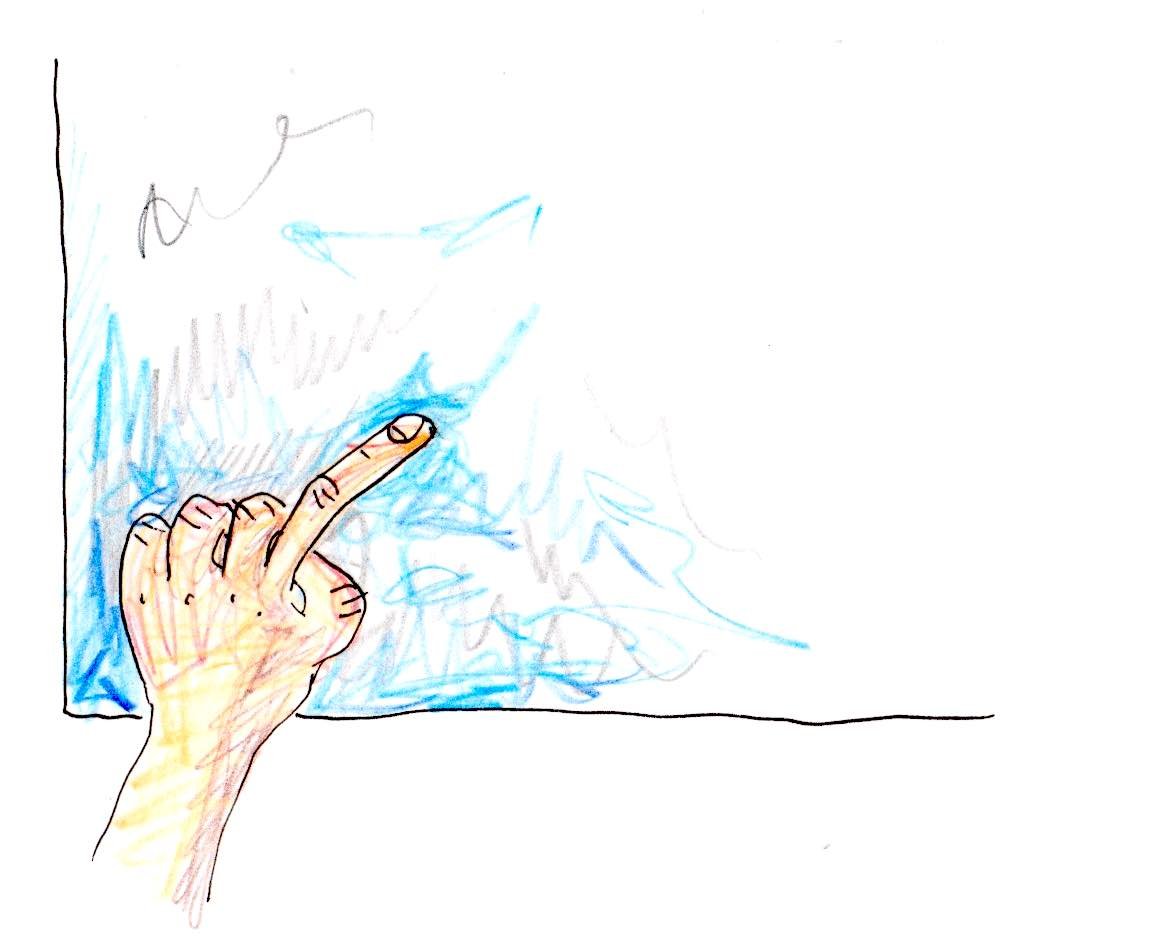
Please tell me something silly that you love.
Naked Attraction, the dating show where people are naked.
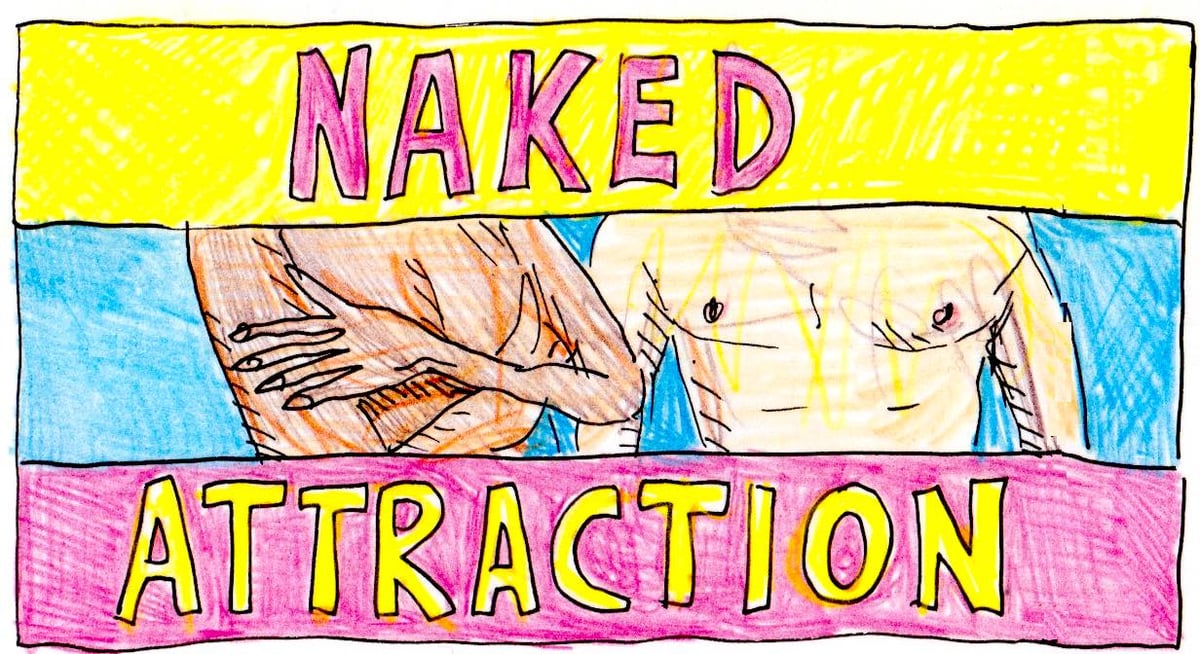
Thanks, Zaria!
Zaria’s work can be found here. And past installments of Drawing Media can be found here.
Murdle: Volume 1, a book of “100 original murder mystery logic puzzles” from the creator of the daily mystery puzzle site of the same name. One reviewer: “a high-speed game of Clue that tortures your brain in the most enjoyable way”.
“I blame Facebook for January 6.” Aaron Sorkin is writing a sequel to The Social Network. “There’s supposed to be a constant tension at Facebook between growth and integrity. There isn’t. It’s just growth.”
We’re in the Golden Age of Mid TV
TV critic James Poniewozik writing for the NY Times:
Mid TV, on the other hand, almost can’t be bad for some of the same reasons that keep it from being great. It’s often an echo of the last generation of breakthrough TV (so the highs and lows of “Game of Thrones” are succeeded by the faithful adequacy of “House of the Dragon”). Or it’s made by professionals who know how to make TV too well, and therefore miss a prerequisite of making great art, which is training yourself to forget how the thing was ever done and thus coming up with your own way of doing it.
Mid is not a strict genre with a universal definition. But it’s what you get when you raise TV’s production values and lower its ambitions. It reminds you a little of something you once liked a lot. It substitutes great casting for great ideas. (You really liked the star in that other thing! You can’t believe they got Meryl Streep!)
Mid is based on a well-known book or movie or murder. Mid looks great on a big screen. (Though for some reason everything looks blue.) Mid was shot on location in multiple countries. Mid probably could have been a couple episodes shorter. Mid is fine, though. It’s good enough.
Above all, Mid is easy. It’s not dumb easy — it shows evidence that its writers have read books. But the story beats are familiar. Plot points and themes are repeated. You don’t have to immerse yourself single-mindedly the way you might have with, say, “The Wire.” It is prestige TV that you can fold laundry to.
Bullseye. Although I also agree with this caveat from Alan Sepinwall:
I’d only take issue with this excellent Poniewozik essay in the sense that not all Mid TV is created equal. Poker Face and Mr. & Mrs. Smith are great examples of the kinds of shows they want to be. I’d rather have those than all these wild swings by people who don’t understand how to make TV.
For me, the problem with Mid TV is differentiating it from actual good TV…finding shows that you actually don’t want to fold laundry to. I’ve gotten burned a few times on shows that I thought were going to be challenging & interesting — Constellation, 1899, and Mrs. Davis come to mind — but were just sort of aggressively fine (so much so that it turned me off).
Two more thoughts, from the comments section of Poniewozik’s piece. I love this re: specificity:
Shogun is by far the best show released this year, and it has an enormous amount to do with its *specificity* of artistic vision. All of the “mid” shows otherwise referenced here are trying to achieve too many things at once or appeal to too many demographics to have much of an impact. They are content, not art.
It’s a contradictory truth that if you want to create something that really connects with people (even a lot of people), you gotta make it specific or personal (or both). Shōgun is right at the top of my to-watch list (after I finish the five shows I’m stinge watching).
Writer of TV here. I won awards for an iconic HBO show. I can tell you that 95 percent of the blame here lies with the executives who are now so scared to lose their jobs that they just go right down the middle — to the mid, if you will. It’s easier to say yes to a show they have seen before than take a risk on something outside the box.
And yes, they are using AI to give us “notes”. I feel very lucky to have worked in this medium when it still rewarded real creativity.
Sounds about right.
How crappy federal legislation has encouraged US automakers to build & sell bigger cars, trucks, and SUVs, which are more dangerous and worse for the climate.
The Louvre wants to put the Mona Lisa in its own room to improve visitor experience. Here’s my suggestion: two rooms, 1 w/ the Mona Lisa (timed entry, no photos) and 1 w/ a fake (free-for-all, selfies, usies, etc.)
Lydia Polgreen: The Student-Led Protests Aren’t Perfect. That Doesn’t Mean They’re Not Right. “These young people seek a worthy cause: to end what may be the most brutal military operation for civilians in the 21st century.”
Yo-Yo Ma Performs Bach in Alaska for Earth Day
This is a nice thing to end the week on: Yo-Yo Ma playing “Bach’s Prélude from Suite No. 2, amidst the melting permafrost on Lower Tanana Dene lands in Fairbanks, Alaska.” He was brought to this birch forest by Princess Daazhraii Johnson, a member of the Neets’aii Gwich’in people, who wrote:
Our relationship to our birch relatives, our salmon relatives, and all the beings of Alaska are sacred. Our traditional stories tell us that at one point we all spoke the same language … we still do. If we find the time to truly listen, we might recognize ourselves in the melting permafrost or the fallen birch, but we might also recognize ourselves in the songs of the birds or the freshness of the Arctic breeze. There is still hope when we experience life. We should all fall in love with the places we live and let this love drive our determination to protect the waters, the salmon, the caribou, and all our plant relatives so that future generations may also experience such joy and sustenance.
Have a good weekend, everyone.
Yesss, Run Lola Run is returning to theaters for its 25th anniversary. A 4K digital restoration will start showing on June 7. I loved this movie — saw it in the theater when it came out but haven’t seen it in many years.
The first episode of the podcast featuring astrophysicist Katie Mack explaining the universe to John Green is up! It’s about the first two minutes of the universe. “We are not just made of stardust; we are also made of Big Bang stuff.”
Adam Roberts and his partner dined at Noma (aka “The Best Restaurant in the World”) and he was thwarted by some pre-meal queasiness & the challenging cuisine. “You don’t seem like yourself. You look haunted.”
The Man Who Killed Google Search, i.e. how “growth-hungry managerial types” from Google’s ad business chased out the old search team “to make Google worse to make the company more money”.
Watch Chuck Jones Draw Bugs Bunny, Daffy Duck, and Porky Pig
This is great: a 25-minute interview with legendary animator Chuck Jones as he sits and draws some of his iconic characters (Bugs Bunny, Porky Pig, Daffy Duck). He told this anecdote about how Steven Spielberg and George Lucas were both influenced by a particular space-themed cartoon of his:
Porky was just a kind of a little third-string Boy Scout and was not very interesting to me. And then when I put him in a picture called Duck Dodgers in the 24th and a Half Century. Spielberg used that picture in Close Encounters the Third Kind - when his kids were watching television in the picture, they were watching Duck Dodgers in the 24th and a Half Century. And Lucas told me that he saw that picture when he was 12 years old and when when he opened Star Wars in San Francisco he told them they couldn’t have Star Wars in San Francisco unless they ran Duck Dodgers in the 24th and a Half Century.
Christopher Slayton built a bunch of iconic cosmic structures in Minecraft, including the Sun, the Pillars of Creation, galaxies, a supermassive black hole, and galaxies.
An experimental data sonification of what a “decentralized, digitized, decarbonized electricity grid” would sound like. “Should we be dramatic, Hans-Zimmer-style ‘bahhhhhhhhnnnnn’ sounds? Or more ambient?”
Sounds like The Onion has been rescued from an agonizing death by private equity by an acquisition by people who actually care about it. “The Onion is just an institution. It should be preserved and it should be great.”
Just a Beautiful Drawing of Bluebells

…By the artist Skevoulla Gordon. (Prints are available, too, and she’s a good follow on Instagram!)
Life-Ruining Mistakes?
The other day, the novelist Robin Sloan mentioned in his newsletter that he really liked the Financial Times. It seems everyone’s talking up the Financial Times lately, so I went and followed them on Instagram.
The first post in their feed was for an essay by Janan Ganesh, about how although the American self-help industry makes it seems like most mistakes can be salvaged, many are in fact unsalvageable and life-destroying. An excerpt:
The surprise of middle age, and the terror of it, is how much of a person’s fate can boil down to one misjudgement.
Such as? What in particular should the young know? If you marry badly — or marry at all, when it isn’t for you — don’t assume the damage is recoverable. If you make the wrong career choice, and realise it as early as age 30, don’t count on a way back. … A big [mistake], or just an early one, can foreclose all hope of the life you wanted.
At first I found it oddly cheering (if I can’t fix my mistakes, I might as well relax and accept my circumstances), but then I found it sad. (Does my husband feel like he made a life-destroying mistake by marrying me? LMAO.) Now I’m more like ¯\_(ツ)_/¯ because things can only ever go the way they go. Anyway, I’m not yet a FT subscriber, but it was a nudge.
The Feeling That the Time for Doing Something Has Passed
Here is a pleasantly painful trailer for a new movie from the filmmaker Joanna Arnow. It opens this Friday, April 26, at IFC and Lincoln Center in NYC. I don’t know if I’m going to watch it, but I couldn’t really look away.
Arnow also stars as…
an emotionally detached young Brooklynite drifting through unremarkable days and nights. Neither her on-again-off-again BDSM relationship with a mildly disinterested older dom, nor her nondescript corporate job, appear to bring her any satisfaction.
And yet “she finds a core of poignant truth about the ways people search for … emotional happiness and sexual gratification” (per the Lincoln Center summary). It’s currently at a 100% on Rotten Tomatoes, FWIW. (This bit also made me laugh out loud.)
Size XXXS, Miniature Sweaters
Oh my gosh — this video about making the teeny-tiny sweaters seen in the movie Coraline! Says artist Althea Crome:
I think knitters are often fascinated by the fact that I use such tiny needles. Some of the needles are almost the dimension of a human hair.
Sublimely absurd, perfection. More info in Reactor. [Thanks, Tobias!]
And here’s another pic, grabbed from Crome’s website:

I don’t know about you, but this makes me want to drop everything and disappear into the process of knitting a microscopic sweater for the next six months. Like her Starry Night one.
Actually, the Starry Night sweater should just be its whole own post:

“I love the paradox of creating an object that takes the form of something you can wear,” Crome writes, “yet is impossible to wear.”
(Her work is also for sale.)
“I have no training for this work. I got the job by bringing in my posters to be framed … and asking the frame shop guy—my boss—if he needed an assistant.” I loved this essay about working in a frame shop (and beyond). “My life has gone off the map, it seems.”
Diary Comics, Dec. 15 & 16
Hello! Here are a few more journal comics from last December, these are a bit cheerier than the ones from last week.


A Huge Collaborative Flipbook Animation
I love this: The Pudding ran an online experiment where they started with a shape (like a straight line or circle) and asked people to trace, as best they could, the tracing of the person before them. This resulted in a series of “flipbook” animation of how the shapes evolved over time — invariably, a squiggle.
One thing I noticed right away was how all the squiggles ended up squished over on the right side of the screen. The Pudding team had a theory on why that happened (the 3:20 mark in this video):
I found this study from like 35 years ago - they were trying to figure out why people kept missing their targets on touch screens. They found people tended to touch below their target and people tended to touch closer to the edges of the screen. And so I figure if it’s like right-handers who are missing, you’re going to be missing to the right. We probably had about half the users on mobile and 90% of the those half are probably going to be right-handed so it would make sense that it would gradually go to the right.
Go read the rest of the post — they also did an experiment about people’s inclination to draw penises on “any free-form drawing project on the internet”. (via waxy)
Kelly Hayes: the double standards of conservatism (i.e. “there must be in-groups whom the law protects but does not bind…”) are about hierarchy (or caste, if you will). “They are outlining the world they want, including who should be victimized at will.”
The Biden administration is imposing new regulations on coal burning power plants. “Taken together, the regulations could deliver a death blow in the United States to coal, the fuel that…has caused global environmental damage.”
What Bird Is That?
As someone who is interested in birds but doesn’t know a whole lot about them, this new animated video series from Will Rose is right up my alley. What Bird Is That? is a beginners guide to birding. The second episode, embedded above, is all about how to identify birds from their calls.
What’s that bird that sounds like Star Wars singing on my roof? What bird sings it’s own name? What’s that laughing sound you heard in the woods?
Right now, I “cheat” by using Cornell Lab of Ornithology’s eBird app, which allows you to record a bit of birdsong and it’ll ID the bird for you. (via the kid should see this)
How teens benefit from having the choice to read “disturbing” books. They reported being more empathetic, thoughtful, happier, and better readers. I read a lot of “age-inappropriate” stuff as a preteen & teen (Stephen King, etc.) and it was fine.
A Message from the Chancellor on the Recent Student Protest. “But this recent protest is different. These students will never inspire change. Fifty years from now, we will definitely not pretend that we agreed with them the whole time.”
What does it mean to “be a serious person”? I don’t know if I am one.
Can I Lick It? (Yes, You Can?!)

Is the periodic table yummy? Well, it depends on the element. But if you’ve ever wondered if a little taste of xenon or iridium would do you any harm, this periodic table is for you.
See also What If You Swallowed All Elements of the Periodic Table?. (via @anewplacetohide)
“What would you consider as the most recognizable bitmap fonts in tech history?” Atari font, Chicago, Commodore 64 font, Minecraft font, London Underground digital marquee font, etc.
The novelist R.O. Kwon: The Parents Who Regret Having Children. “It’s possible to have strong, lasting regrets about a life choice while ferociously loving — and caring for — the fruit of that decision.”
Bizarre Traveling Flame Discovery
Steve Mould’s videos are always entertaining and informative but this one is also a little bit mind-blowing. If you build a circular trough with just the right dimensions and fill it with lighter fluid, a flame will travel around it. And other shapes will do other things — the effect created by the star/octopus shape is especially cool. The effect is an example of an excitable medium:
An excitable medium is a nonlinear dynamical system which has the capacity to propagate a wave of some description, and which cannot support the passing of another wave until a certain amount of time has passed (known as the refractory time).
A forest is an example of an excitable medium: if a wildfire burns through the forest, no fire can return to a burnt spot until the vegetation has gone through its refractory period and regrown.
Other examples:
Normal and pathological activities in the heart and brain can be modelled as excitable media. A group of spectators at a sporting event are an excitable medium, as can be observed in a Mexican wave (so-called from its initial appearance in the 1986 World Cup in Mexico).
(via waxy)
A Day in Tokyo: A 1968 Film Captures a City Reborn 23 Years After Its Destruction. “Bullet trains, high-speed expressways, and color television broadcasts were spreading throughout the land.”
Vintage Japanese Train Tickets









Oh, these old Japanese train tickets, sourced from this collector, are wonderful. So much design inspiration. You can find more at Present and Correct.
See also Vintage Weekly Bus Passes.
Two men swapped at birth – one Indigenous, one white – finally get apology. “To have the core understanding of who you are — and who your parents were and who your siblings were — taken away from you, is a shattering experience.”
Designer/creative Connell McCarthy: “I got married and over-engineered everything.” He obviously designed everything — invites, website (using AWS!), signage — but also made custom candles and an iPad jukebox app using the Spotify API.
Cool Art: Naja Tepe’s Pottery

In the spirit of recommending things I truly love, I wanted to highlight the pottery of Northern California artist Naja Tepe. I’ve ordered from her twice now, and her work is fabulous. I love her strawberry-themed items, but the crescent moon on the plate in her most recent Instagram post (upper right in the composite above) made me want to have everything it appears on, too. Great for gifts. I don’t think my mom reads this site, so I will therefore reveal that I got her a Naja Tepe item for her birthday this year.
Okay, here’s a toy car for actually cleaning floors. You load it up with paper towels and set the kids loose. It’s probably not something I need, but the reviews are strangely compelling.
Music for Programming, a collection of “the most compelling music for sustained concentration”. I love the interface.
Fascinated by this “WTF Notebook” post because 1) it’s a really good listening/note-taking idea for new team members 2) applied for weirdly Machiavellian ends, e.g. wanting ppl to think they’re helpful rather than wanting to be helpful.
Mountain Bike Advice?

Ok mountain bike nerds, I need your advice. Here’s my situation: I’ve been riding for 3.5 years now on a Kona Honzo hardtail (which I really love) and am pondering a full-suspension bike purchase. They are $$$, but I want to do more riding this summer & fall — including some downhilling on some local lift-serviced trails here in VT (Bolton, Killington, Sugarbush, Burke) — and it feels like it’s the right time to invest in an upgrade.
I would say I’m an intermediate rider (but more towards the beginner end of the spectrum than the expert end). I love flowy trails and can do small jumps and such, but I’m not super fast and am still learning how to turn properly in the berms. I’m never going to be a super aggressive rider but I’d like to progress. A lot of the stuff I ride is up and down, so I need something that climbs well (not looking for a downhill bike). I’m 6’ and 155# if that matters. My Honzo is a large and has 29” wheels, which I like. I’ve ridden a Kona Process 153 29 and that felt good, although maybe a little squishy (but maybe everything feels squishy after a hardtail).
There are good bike shops around here and I’m definitely going to talk to them about what I’m looking for, but I’m wondering if anyone out there has thoughts about brands (particularly those that are known for quality (and ones that aren’t)), what to look for, what to stay away from, etc. Should I buy used? If so, good places to buy used? (I know about Pinkbike.) Any help or advice is appreciated, either in the comments below or via email. Thanks!
Scientists have repurposed a 50-year-old drug to revolutionize bone marrow transplants. “Today, agonizing searches for a matched donor are largely a thing of the past” and “the drug cut rates of acute and severe complications by upwards of 80%”.
Happy to announce that thanks to folks buying The Process Tee, we’ve donated a total of more than $4,700 to the National Network of Abortion Funds to aid them in their goal of “abortion access for all”.
Sharks: “the scary triangles of the sea”. (What are the scary triangles of other places?)
What Are you Starting Right Now?
The NY Times Style Magazine recently published an entire issue dedicated to “what it means start an artistic life”. I have only scratched the surface of this multi-article package, but I locked into this one immediately: We asked 80 artists and other creative people to tell us what they’re starting right now or hope to very soon.
Filmmaker Boots Riley:
I’m getting ready to start filming a feature I wrote about a group of professional female shoplifters who find a device called a situational accelerator that heightens the conflict of anything they shoot it at. I also have a sci-fi adventure: a janky, lo-fi epic space funk opera. My dream is to use the same crew and shoot the two movies back to back in Oakland, Calif. [where I live]. That’s one thing about being 53 — I want to be able to spend more time with my kids.
Writer Alice McDermott:
There are three kinds of novels I’ve never taken to heart: science fiction, murder mysteries and novels about novelists. So I’ve decided to try my hand at each. If I fail, they’re probably not books I’d want to read anyway.
Cartoonist Daniel Clowes:
I’ve always had the desire to do fakes of artworks I admire — to figure out how they were done, and so I could have otherwise unaffordable artwork hanging in my living room. Painting [with oil] is as frustrating and exhilarating as I remember it being when I was in art school 43 years ago, and my paintings look alarmingly not unlike the ones I did at 19.
Artist and writer Nell Irvin Painter:
I’m way too old to be a beginner. I’m 81 and have already written and published a million (OK, 10) books. But a very different kind of project’s been tugging at me: something like an autobiographical Photoshop document with layers from different phases of my life in the 1960s and ’70s — spent in France, Ghana, the American South. I’d have to be myself at different ages.
Artist Christine Sun Kim:
I have a bit of an adverse reaction to people doing American Sign Language interpretations of popular songs on social media - they’re usually based entirely on the lyrics in English, when rhyming works differently in ASL. So I’ve been wanting to make a fully native ASL “music” video. One day.
Artist Eric Mack:
I’m starting to recharge in order to begin my next body of work. I journal, read, explore the Criterion Channel and get deep-tissue massages. I keep wishing I’d organize the fabrics in my studio.
I love that: Mack shared not what he’s working on next but that he’s using the time to recharge the batteries, a step that’s often neglected, either out of sheer economic necessity, obsession, or fear (I was *terrified* to take time off from the site for years). And I want to see both of those films by Boots Riley — “a situational accelerator”?!
So. What are you starting right now or hope to very soon?
Why earthquakes on the East Coast are felt farther away than ones on the West Coast. It’s the age of the rock and the faults.
Denis Villeneuve’s Four Favorite Films
Letterboxd asked Dune director Denis Villeneuve what his four favorite films were and he cheated and listed five (including 2001 and Blade Runner).
First of all, who knows how long Blade Runner has been on his top 5 (or even 10 or 20 list) but getting to do a sequel of one of your favorite films has to be unbelievably rewarding as a director.1
And I’m going to cheat as well here and list a number of other films that Villeneuve has publicly praised, courtesy of this piece from IndieWire: Vertigo, Children of Men, Downsizing (?), There Will Be Blood, Seven Samurai, The Beguiled, Jaws, and three Nolan films (Dunkirk, Inception, Tenet).
They fixed it: NASA is able to talk to Voyager I again. “For the first time since November, NASA’s Voyager 1 spacecraft is returning usable data about the health and status of its onboard engineering systems.”
A Little Comments Check-In
Hey there everyone. As I quickly touched on over the weekend, I launched a few new tweaks/features for the comments here on kottke.org:
1. Ability to edit comments. After you post a new comment, you’ve got 10 minutes to edit it — to fix any typos, formatting slip-ups, or quick extra thoughts. After 10 minutes, the comment is locked. Edited comments are denoted by some text (“Edited”) next to the timestamp of the comment and you can click on it to see the comment’s original text.
2. A (hopefully) less confusing posting interface. I still haven’t totally dialed this in, but the inline reply box wasn’t working, particularly when you tried replying to the last comment in a thread and then you had Dueling Comment Textareas but only one was the One True Textarea — chaos. Now everything (posting, replying, editing) is in a popup modal. We’ll see how that works.
3. There’s been a list of recently active comment threads on the front of the site for a couple of months now. One of the biggest feature requests I’ve gotten is a way for people to follow threads that they’ve participated in, to see if others have replied to them, etc. There are lots of potential ways to tackle this problem, but for right now, I’ve added a tab to the front page comment widget that lists threads that you’ve commented in that have new comments. It’s not perfect, but neither is turning the whole site into Reddit or a social media site. Navigating that middle path is going to be tricky — I don’t want to end up in a place where several things about the site half-work — but hey it’s fun to be out here experimenting.
Given this refresh, this seems like a good moment to check in on how comments are going overall. Here’s what I wrote when they launched back in October:
“Always good, often great, and occasionally sublime” describes a lot of the feedback I get via email and social media — kottke.org readers are a super-interesting bunch and very often share things that are more interesting than whatever thing I posted that prompted them to write in. Reader comments become more valuable to everyone who reads the site when they’re relocated from my inbox and from disparate threads on various social sites to the site itself. Some days, my inbox is the best thing on the internet and I want to bring that vibe to the site.
The timing feels right. Twitter has imploded and social sites/services like Threads, Bluesky, and Mastodon are jockeying to replace it (for various definitions of “replace”). People are re-thinking what they want out of social media on the internet and I believe there’s an opportunity for sites like kottke.org to provide a different and perhaps even better experience for sharing and discussing information. Shit, maybe I’m wrong but it’s definitely worth a try.
I have been very happy with how the comments have gone over the past 6 months. Borrowing Michael Pollan’s formulation, I feel like we’ve largely stuck to the unstated maxim of “Post comments. Not too much. Mostly interesting.” Every day on the site, there’s are 2-3 active threads going and I learn something new from or am moved (to feel, to action) by a comment or a discussion, but it’s not so much that you can’t keep up with it all. There are a lot of posts without comments and that’s great too. Thank you to everyone for taking the time to participate and adding to the vibe here.
Moderation has been extremely easy — having commenting open only to active members has resulted in aligned incentives for everyone and we’ve all committed to the bit, i.e. tried to follow the guidelines to help create something meaningful together.
How about some stats? Around 850 unique commenters have left more than 4300 comments on ~650 posts (mean: 6.5 comments/post, median: 3 comments/post). The most popular post is Who Are the People in the Neighborhood? (350 comments) and more than two dozen threads have 30 comments or more. Only 4 comments have started with the word “actually”. 🙃
Comments are open on almost every post now, and that’s been going well. The very few comments I’ve had to hide have either been off-topic, out of place in a community setting, or of the “fighting about opinions” variety. Nothing that I can recall has been mean-spirited or in bad faith. All of the hidden comments would not be out of place on social media at all, but we’re trying something slightly different here.
The last time we checked in on the comments, I shared a few threads that I thought were particularly good for whatever reason and I’d like to do that again here:
- The job board comments thread is an obvious place to start — in the months since I’ve heard of a couple of people who found work bc of it. I’ll try doing this again in a few weeks.
- Why Weather Forecasts Have Gotten So Good. Not a huge thread but almost every comment is substantive. And Jeffrey Shrader, whose paper was cited in the link I posted, made a comment and took the time to answer questions from other readers. The thread made the whole post so much better.
- Knitting Anything? A perfect Friday post about something that a lot of people are into. This was one of the most active threads and the most enthusiastic. I don’t knit and am not super interested in it, but I checked back on this one through the weekend because everyone was so excited to share and learn. And now I want to learn how to knit a little?
- I asked Edith about her favorite threads and she replied with two: this short thread about an interview with Marilynne Robinson (she keeps thinking back on the comments here) and the recommendations in this thread for Middlemarch (“changed my life!”)
- Where Do You Call Home? Maybe my favorite thread on the site…just so many people sharing personal stories and thoughts about what and where they think of as home and why.
- I loved Aaron’s question and the resulting thread: What Did You Learn How To Do This Year? Again, lots of sharing and camaraderie around interests.
- And finally, a short thread about something goofy with folks in the comments sharing related goofy things. One commenter even came back more than a month later to follow up on a recommendation made by another reader (“Recommend! And thanks Elsa!”)
What threads and/or comments have you particularly liked? Maybe I’ll collect some of them under a tag of some sort so we can all keep track of them. Also, please let me know if you’ve got feedback or other thoughts about the comments — I’ve got a list of future improvements I’d like to do, but would love to hear of any features you’d like to see or pain points you’re having a hard time with.
A database of useful biological numbers, including the duration of an eye blink, the surface area of human skin, the diameter of a water molecule, and the mass of a male fruit fly.
Hold the Line is a “piece of sound art generated by data from Canada’s 2023 wildfire season”, an data sonification if you will. Clicks represent fires (Zippo “tings” for human-started fires) and rumbles for forest area burned.
For All Mankind has been renewed for a fifth season and the show is getting a Apple TV+ spin-off called Star City, which will follow the same alt-timeline as FAM but from the Soviet perspective.
The Lost Mixtape From The Hood Internet
This weekend I was doing some programming work (comments, another small project) and listening to some old-school electronica (DJ-Kicks by Kruder & Dorfmeister anyone?). When I write, I tend to listen to chill stuff so I can concentrate — classical, vaporwave, soundtracks, Jon Hopkins, Sigur Rós, Tycho, Boards of Canada, things like that — but when designing or programming, I need something faster with a beat to spur me onwards.
So anyway, I was about to switch from electronica to something by kottke.org favorites The Hood Internet when I thought to check their website to see if they’d released any new mixtapes. And lo — they had (sorta). The Lost Mixtape is a 45-minute mix of music from circa 2005-2009, discovered on some dusty old hard drive and recently finished up & released for our listening pleasure.
The bit at around 16:00 where they mix Milkshake and So Electric is just superb. You can find streaming options and a downloadable MP3 on their website.
This had me cackling in laughter this morning: Kevin Del Aguila hamming it up in the wings off-stage while the show, Some Like It Hot, goes on. How on Earth did the actors not completely break during all of that?
A bot that pairs the clichéd “I hope this email finds you” with snippets from books beginning with “finds you…” E.g.: “I hope this email finds you wherever you go, and lands right in the center of your brain.”
This looks promising: an RNA-based vaccine effective against any strain of a virus and works for those with weakened immune system (babies, immunocompromised). “This could be the universal vaccine that we have been looking for.”
Once again, it is cheaper to decarbonize our world now than to pay for the costs of climate damage in the future. “Climate damages by 2050 will be 6 times the cost of limiting warming to 2°.”
Quick site notes: 1. you can now edit comments for 10 min after posting, 2. there’s a new comment posting interface that’s hopefully less confusing, 3. the front page comment widget shows threads you’ve posted in. Come try it out!
Green’s Dictionary of Slang is “is the largest historical dictionary of English slang” that contains “nearly 100,000 entries supported by over 400,000 citations from c. ad 1000 to the present day”.
Writ Small: A Newsletter Recommending Kids’ Media

My daughter is home sick from daycare, and I’m letting her watch my phone unlimitedly. She’s absorbed in it but made an exception to look up and point at the above picture, from an entry in Chadwick Matlin’s newsletter Writ Small, about the book Today, by Julie Morstad. The newsletter highlights kids’ media — “think Bluey, but stuff that isn’t Bluey” — and so far the worst part is that I want to buy everything it recommends.
I also learned a lot from this installment on a song from the 2021 My Little Pony movie. (thx, Gillian!)
From Kevin Kelly on the occasion of his 73rd birthday, 101 bits of additional life advice. “Most arguments are not really about the argument, so most arguments can’t be won by arguing.”
“my therapist just told me that the NYT word games app is becoming a problem for many of her patients, including me … she asked me how long i spent every day doing them and i LIED”
The re-release of Interstellar in 70mm IMAX on my birthday? Don’t mind if I do! “Interstellar will fly back into theaters on Sept. 27, 2024. It will be shown in 70mm Imax prints (Nolan’s preferred format), as well as on digital screens.”
“R men ok?????” Boy Room is a new video series that features tours of the “squalid” bedrooms of young men.
Black Twitter: A People’s History is a three-part Hulu documentary series directed by Prentice Penny (Insecure) premiering in May. It’s based on Jason Parham’s Wired article of the same name.
Feathers Are One of Evolution’s Best Inventions
Really fascinating piece by Michael Habib in Scientific American about how amazing feathers are: they come in so many different shapes and sizes and do so many things (insulate, keep dry, flying, noise dampening, etc. etc. etc.) And I loved the opening anecdote:
In October 2022 a bird with the code name B6 set a new world record that few people outside the field of ornithology noticed. Over the course of 11 days, B6, a young Bar-tailed Godwit, flew from its hatching ground in Alaska to its wintering ground in Tasmania, covering 8,425 miles without taking a single break. For comparison, there is only one commercial aircraft that can fly that far nonstop, a Boeing 777 with a 213-foot wingspan and one of the most powerful jet engines in the world. During its journey, B6-an animal that could perch comfortably on your shoulder-did not land, did not eat, did not drink and did not stop flapping, sustaining an average ground speed of 30 miles per hour 24 hours a day as it winged its way to the other end of the world.
Many factors contributed to this astonishing feat of athleticism-muscle power, a high metabolic rate and a physiological tolerance for elevated cortisol levels, among other things. B6’s odyssey is also a triumph of the remarkable mechanical properties of some of the most easily recognized yet enigmatic structures in the biological world: feathers. Feathers kept B6 warm overnight while it flew above the Pacific Ocean. Feathers repelled rain along the way. Feathers formed the flight surfaces of the wings that kept B6 aloft and drove the bird forward for nearly 250 hours without failing.
A bar chart race visualization of the most popular desktop operating systems from 1985 to the present. Just overwhelming dominance by Microsoft — but an impressive comeback from Apple in the 2010s.
The hidden potential of bicycles. “Bicycles have been used for so long as children’s toys and exercise equipment that we forget what useful technology they represent. They multiply our bodies’ speed and efficiency many times over.”
The Fruitluck

I’m really interested in fruit, especially ones I’ve never tried, and I’ve loved following Florida Fruit Geek, aka Craig Hepworth, on Instagram, where he posts photos and info about the unusual fruits he grows (in Gainesville). Hepworth recently hosted a “fruitluck,” where gatherers shared…
…half a dozen varieties of loquat, four kinds of mulberry, carambola/starfruit, sweet oranges, Seville oranges, grapefruit, jackfruit, guava, grapes, apples, sweet tamarind, dried jujube, strawberries, blueberries, Mysore bananas, Rajapuri bananas, Cavendish bananas, green coconuts, homegrown pineapple, dried carambola, tangerine, dried sweet cherries, pomelo and more.
I’d love to have a fruitluck! Maybe I need to make a trip to Florida.
“Onboard the Nautilus, Things Were Not as They Seemed…”
[Voiceover]: The Nautilus had no heat or insulation — nothing but bare metal separated them from the frigid Arctic waters. The crew were constantly sickened with food poisoning and dosed with lead from the soldering in the submarine’s pipes. Attempting the pole this late in the season would be extremely dangerous, and without exception everyone wanted to turn around and head home. Everyone except Wilkins.
I “enjoyed” this stressful mini-documentary, from the Mustard Channel, about the ill-fated (but — spoiler? — not THAT ill-fated) 1931 attempt to reach the North Pole by submarine. [via The Browser]
If you’re looking for more newsletters to read, here’s One Newsletter I Always Make Time to Read from Inbox Collective. OTOH, what I really want is a list along the lines of One Newsletter I’m Glad I No Longer Read.
I Just Wasn’t Very Good
I’ve been thinking about something I posted last week — in an excerpt from his new book The Work of Art, former New York magazine editor Adam Moss described the art he makes as bad: “When I left my job, I began to paint more seriously,” he wrote. “That was the beginning of my torment: I just wasn’t very good.” Or as he put it to The New Yorker: “I kind of just wasn’t any good.” Or to Vanity Fair: “I really wanted to be a good painter. What a fucking idiot I was.” Or on NPR, “I really wanted to be good, and it made the act of making art so frustrating for me.”
The book is mostly about how other artists make their work, but I’m currently more interested in what Moss has to say about himself and his art.
Later in the VF and NPR interviews, Moss says that the main lesson he learned from making the book is that with art, it’s the journey not the destination — or, “the making, not the made” (“It’s the most banal observation”) — but of course I still went looking for his paintings online. I want to see them! I didn’t find anything (per the VF article, he hasn’t shared anything publicly yet), but to Moss I say: Show them! Maybe it doesn’t matter if they’re not good. Maybe the worse, the better.
TFW you find a Neanderthal jaw in your parents’ new travertine tile…
Diary Comics, Dec. 11-13
Here are some more journal comics from this past December when I was guest-editing the site.
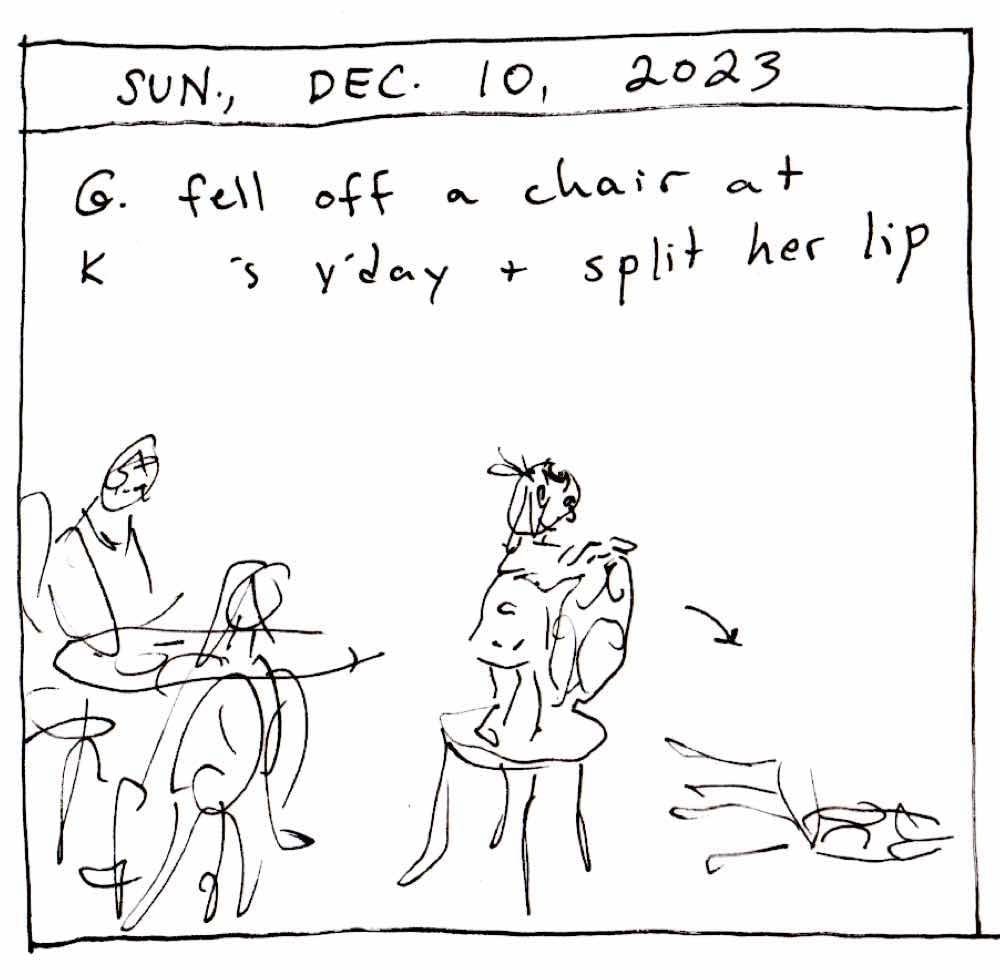


This Beaver Dam is So Huge, You Can See It from Space
A family of beavers in Canada has built a dam that’s twice as wide as the Hoover Dam. This huge dam is kind of a click-baity promotion (it worked!) but the essence of the video is how beavers can help make landscapes more resilient to effects of climate change.
It’s so big it can be seen from outer space. But that’s not the only reason NASA is interested in this architecturally minded species… Increasing diversity and resilience, not to mention creating wetlands, are just some of the impacts beavers can have on their surroundings. What does this mean for the wider environment? And how can we humans learn from it?
See also Unleashing Beaver to Restore Ecosystems and Combat the Climate Crisis.
“You still don’t see the link? It’s right there on the bottom of the Slack thread from yesterday about which shared drive folders link to Dropbox folders that contain all the shared PDFs.” (This is why I work, primarily, alone.)
The strange and turbulent global world of ant geopolitics. “There are roughly 200,000 times more ants on our planet than the 100 billion stars in the Milky Way.” And they are amazingly talented at spreading.
Helsinki Bus Station Theory of Creativity
Several years ago in the Guardian, Oliver Burkeman wrote a piece called This column will change your life: Helsinki Bus Station Theory. It’s about how difficult it can be as a creative person to find your way to making work that feels like it’s uniquely yours.
There are two dozen platforms, Minkkinen explains, from each of which several different bus lines depart. Thereafter, for a kilometre or more, all the lines leaving from any one platform take the same route out of the city, making identical stops. “Each bus stop represents one year in the life of a photographer,” Minkkinen says. You pick a career direction — maybe you focus on making platinum prints of nudes — and set off. Three stops later, you’ve got a nascent body of work. “You take those three years of work on the nude to [a gallery], and the curator asks if you are familiar with the nudes of Irving Penn.” Penn’s bus, it turns out, was on the same route. Annoyed to have been following someone else’s path, “you hop off the bus, grab a cab… and head straight back to the bus station, looking for another platform”. Three years later, something similar happens. “This goes on all your creative life: always showing new work, always being compared to others.” What’s the answer? “It’s simple. Stay on the bus. Stay on the fucking bus.”
(via phil gyford)
Wired’s Steven Levy on how 8 Google Employees Invented Modern AI. (They developed the pivotal “transformer” idea…you know, the “T” in “GPT”.)
Letter from the editors of Scientific American: We Need to Make Cities Less Car-Dependent. “We can design or redesign streets to make people drive more slowly or to discourage driving altogether. We can invest in better public transit…”
CCTV Footage Cross-Stitch
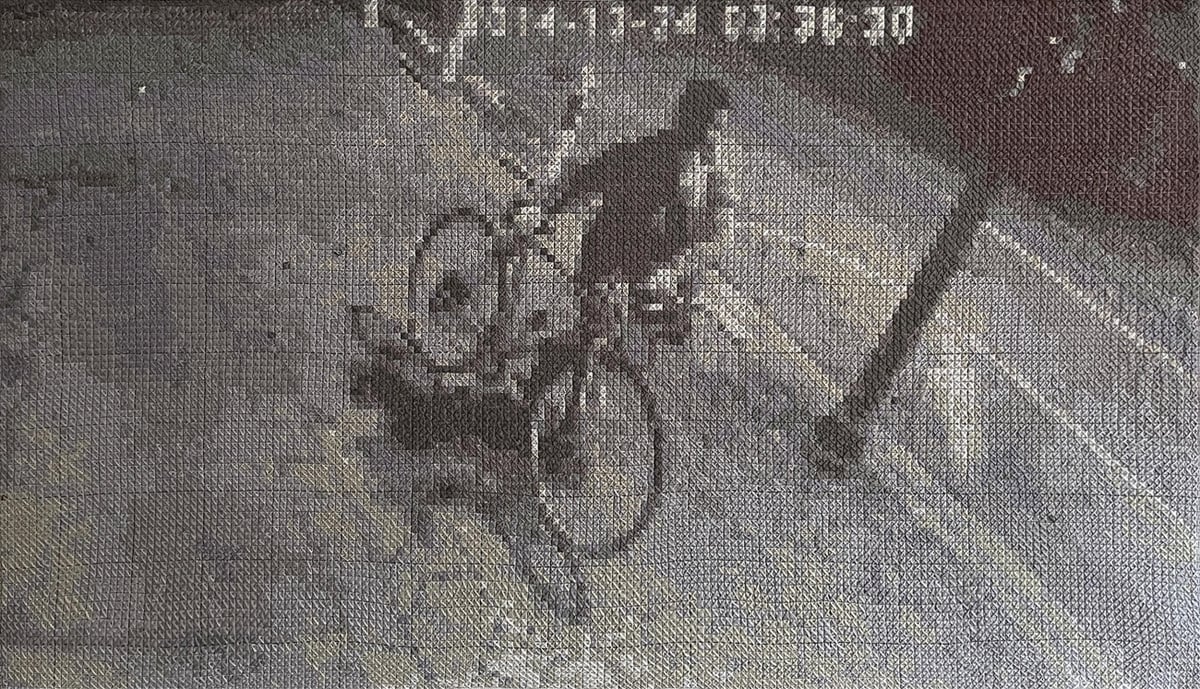
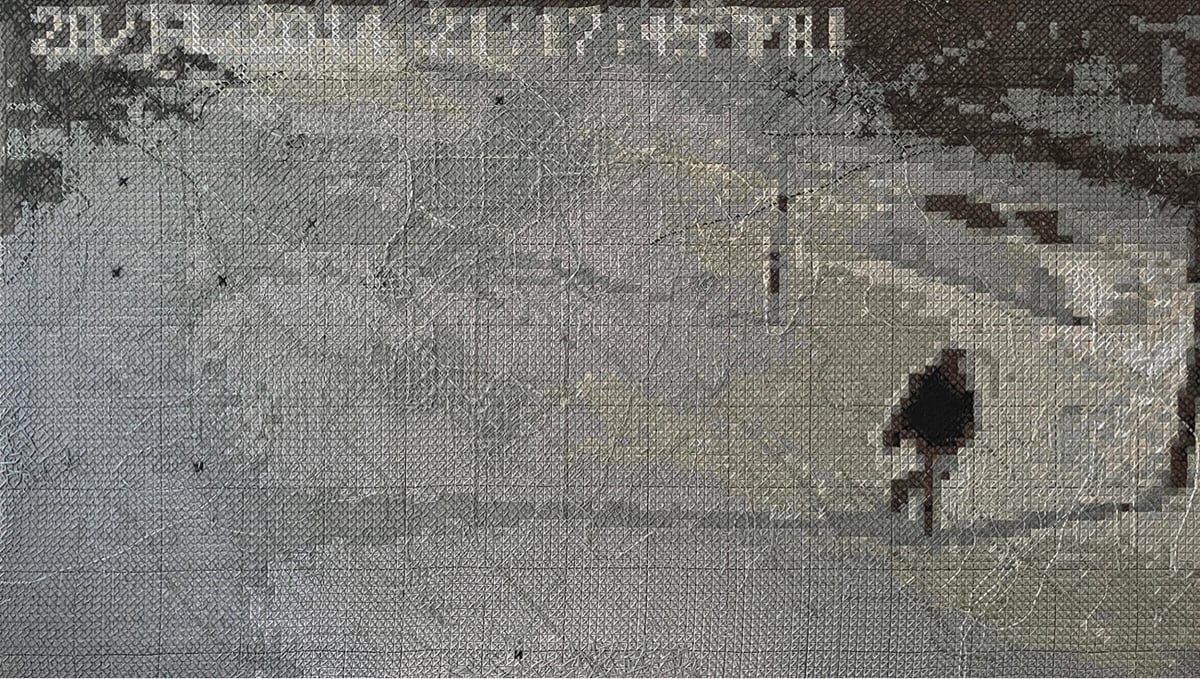
Oh man, I don’t think this could be any more in my wheelhouse: cross-stitch embroideries of CCTV camera images by Francine LeClercq. I’ve always had a soft spot for cross-stitch — it’s the ur-pixel art — and to see low-res, compressed, B&W security camera footage done in embroidery is just a real treat. There’s not much on LeClercq’s site about the work, but check out these posts at Colossal and designboom for more information and photos.
PodcastAP allows you to follow podcasts and music feeds in the fediverse. (So when Ezra Klein or On Being drops a new episode, you’ll get it right in your Mastodon feed.)
I don’t really know how to describe this but here goes: Tavi Gevinson wrote a 76-page zine called Fan Fiction: A Satire about her relationship with & to Taylor Swift and her work.
This sounds really good: astrophysicist Katie Mack and curious person John Green collaborate on A Podcast About The Entire History Of The Universe.
Drawing Media, an Interview With Nick Catucci

Edith here. For the next installment of my newish illustrated column here on Kottke dot org, I talked to my friend Nick Catucci. Nick edits the excellent newsletter Embedded, which partially inspired me to start this column. (Specifically, Embedded has an interview series called My Internet that I’ve always loved.) Nick is also site director at GQ. And about 13 years ago the two of us worked at Vulture together.
Hey Nick! Have you read (watched, listened to, or otherwise experienced) anything good recently?
I think I speak for my demographic when I say that the new Waxahatchee album, Tigers Blood, is a dream. My friends at Pitchfork published a great profile of Katie by Andy Cush where she’s really insightful about how, being sober, she’s drawing from a different well than heroes of hers like Townes Van Zandt and Jason Molina. (One of the neat things about the album is that the harmonies with MJ Lenderman, her new collaborator, sort of dramatize this tension.)

There’s one other thing that gives me serenity the way that Waxahatchee does right now, and that is this couple on TikTok who are renovating a hoarder house in Washington state. I have never watched HGTV and the concept of house-flipping nauseates me, but I’ve grown so attached to the process of these two people (who do flip houses, but plan to move into this one) racing to make this once-grand place livable before their six-month loan runs out that I’m dreading the day that they’re able to refinance.
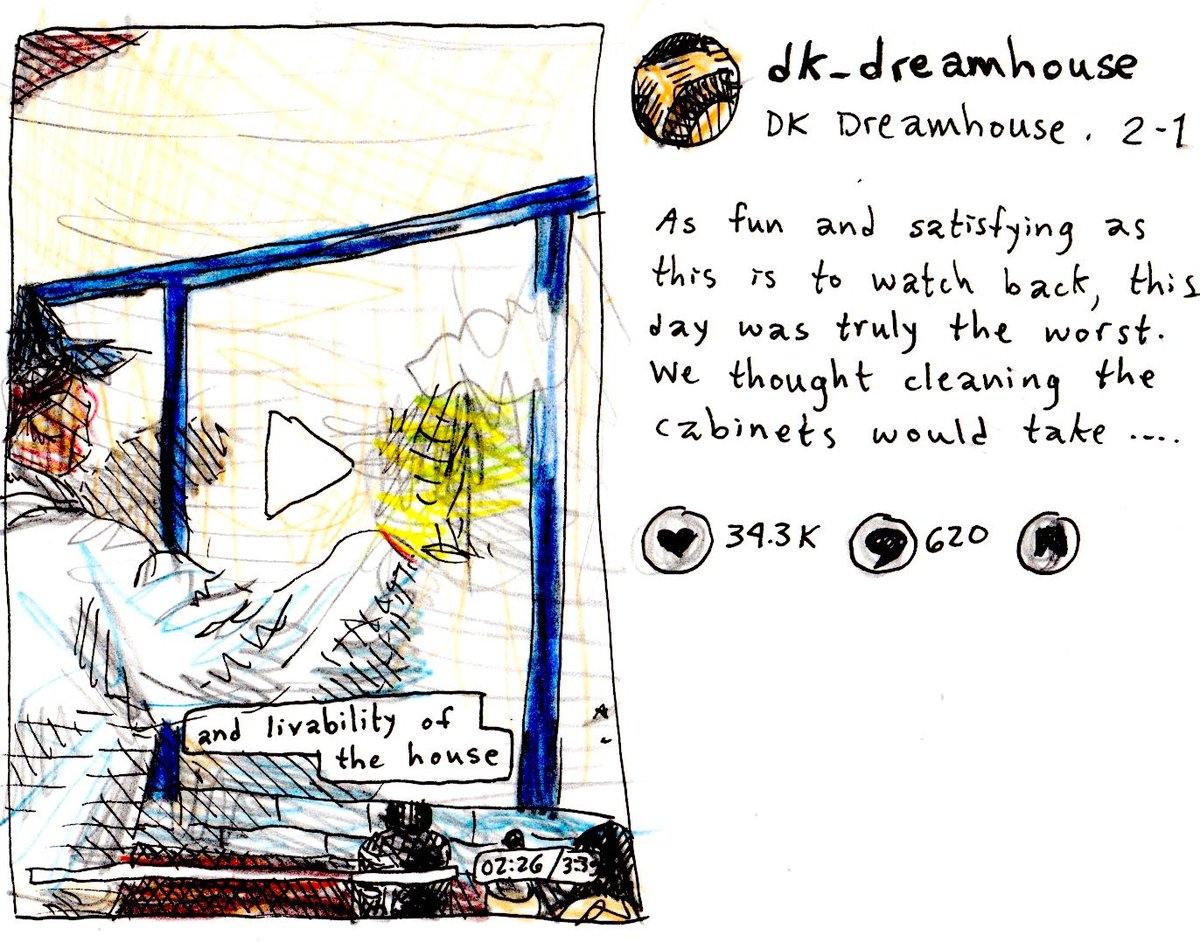
Anything bad?
Basically everything that goes super viral on Twitter now, like The Willy Wonka Experience and “flush ponytail.” The recycled jokes, race for interviews with random people involved, “imagine explaining this to someone who isn’t chronically online”—the whole cycle seems more childish and desperate than ever. It’s as if everyone is doing their own Millennial meme marketing of themselves.
What’s something you’ve read or seen that changed your life?
My wife published a memoir, Down City, in 2017, and reading the transcript for the first time completely opened up my perspective—on this woman that I cherish, this sometimes corrupt place where we both grew up, and love within families.
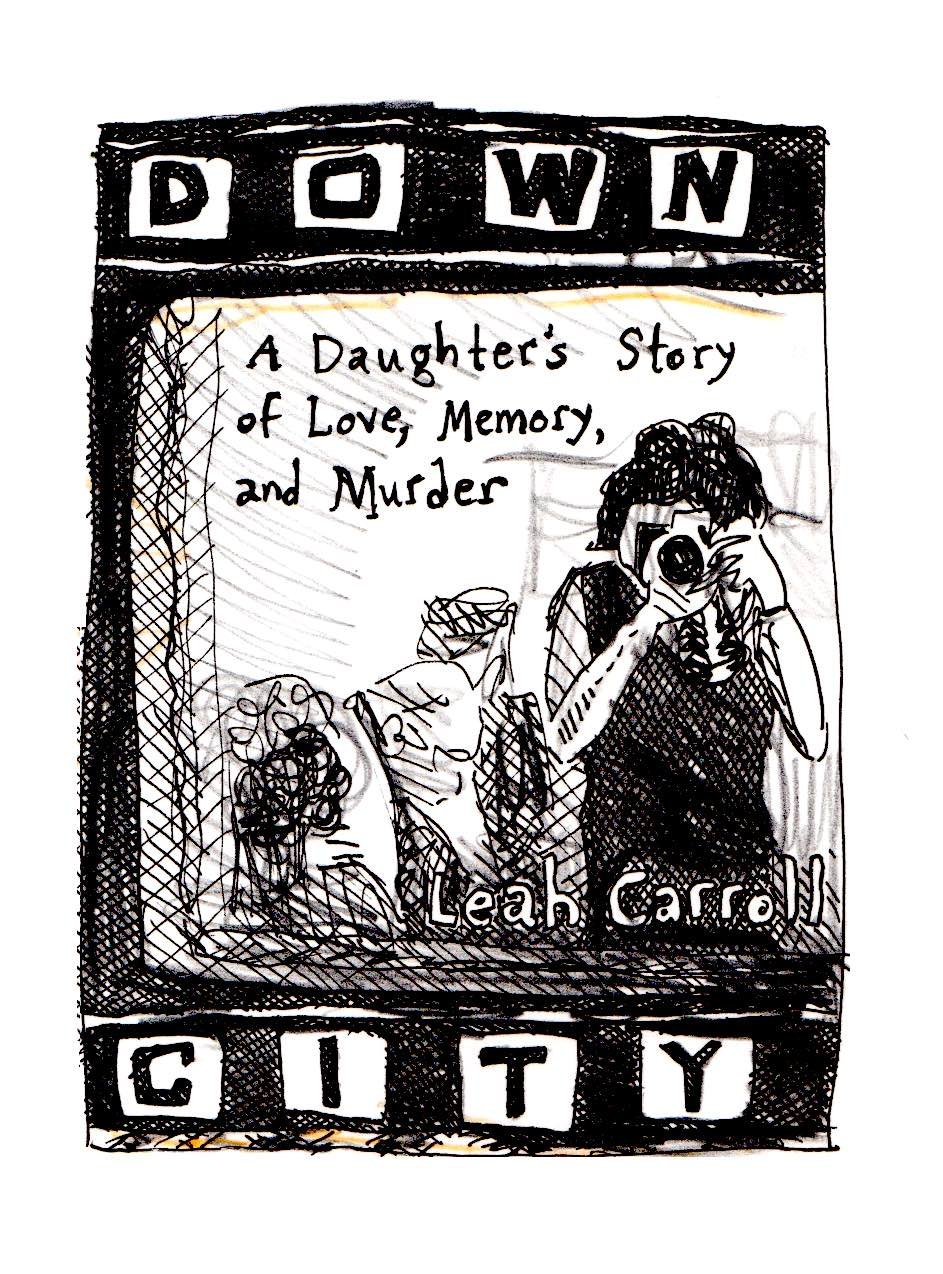
Bonus answer: Two editors I was talking to about a staff writer job early in my career asked me what music changed my life, and the answer that popped into my head was Ice-T’s metal band, Body Count, which I would play at eardrum-damaging volume on big headphones when my mother would drive me to middle school. One of my older brothers owned an early cassette version of their first album, when it still included “Cop Killer.” The editors found that response really funny.
Do you subscribe to anything you don’t read? (Or otherwise consume?)
I’m sure that there are nice little communities in the Discords that some newsletters host for subscribers, but I can’t imagine ever logging on to any of them. Separately, I resent that my costly subscription to The New York Times is justified in part by games that I don’t play.
Read anything you don’t subscribe to?
Technically I have access to everything I read in Apple News and the publishers see some revenue for that, but clicking on “The truth about weed and your brain” and “She’s a sociopath. Here’s what she wishes people knew” is not the same as subscribing to National Geographic or The Wall Street Journal.

What’s something you’ve lied about reading or watching? Or felt tempted to lie about?
I don’t lie. I just allow my friends to think that I must have read their books or listened to their podcasts (which of course I sometimes do, so they can never be sure).
Does anything make you laugh online?
All the time. The For You page was a tremendous innovation for people like me who are powerless not to engage with stupid content. TikTok serves me lots of very funny videos, and I agreed, as I usually do, with my worldly and straight-shooting columnist Chris Black when he wrote in July 2023 that the introduction of Twitter’s For You feed “polarized my timeline but has consistently exposed me to some of the most hilarious stuff I have seen on the app in years.”
Are there any cultural moments you currently think about unusually often? Like are you haunted by a moment from a TV show, or anything like that?
I may be taking “haunted” too literally, but I do think about the Richard Ford protagonist Frank Bascombe, who, in my view, makes a valiant effort to truly live after the death of his young son. I wonder if his life is tragic, or a triumph. (Please don’t email me if you wrote a graduate thesis about this and know the answer.)
What were you really into when you were 12?
I turned 12 in 1991, and at that time, my older brother owned an 18-plus dance club in Providence, RI. He booked DJs like Kid Capri and live shows with painfully early-‘90s rap acts like Das EFX and Fu-Schnickens, and I would sometimes serve sodas at the bar. I witnessed 800 kids pogoing to “The Choice Is Yours (Revisited)” when Black Sheep came through around the height of that song’s popularity, and remember that on the night that Del the Funky Homosapien rolled in, the buzz was that his cousin Ice Cube was on the bus and might jump on stage with him (he was not on the bus). I got to meet most of these guys, and they were impossibly cool, floating through the club’s back rooms on clouds of blunt smoke, but also pretty nice to this nerdy kid asking for their autographs.

Obviously this all left a massive imprint on my soft adolescent brain. To this day, one of my greatest style inspirations remains Grand Puba. The press photo he signed for me shows him, as I remember, immaculately turned out in a baggy striped polo shirt (Ralph Lauren or Tommy Hilfiger, presumably), dark Girbaud denim shorts, and those Timberland boat shoes with the lug soles.

Is there a book/movie/whatever you wish you could experience again for the first time?
Inception in the theater. I saw Fugazi play in Providence as a high schooler and would like to do that again, if possible.
Please tell me something silly that you love.
Speaking in my dog’s voice (breathless young female resistance Democrat) to threaten myself in the meanest, most violent terms possible when I do something mildly annoying around my wife.

Has anyone ever described you in a way you felt was really accurate?
When I’m with my almost-five-year-old daughter and her friends at the playground or waiting for the bus, she’s sometimes tells them, “That’s my dad—he’s so funny.” And in those moments, I know that I am funny, to her.
Previously: Jason Kottke, Jim Behrle
Matthew Haughey: Embrace the Weird. “Who cares? Just make weird shit.” I often fail or am unengaged when I start with goals — picking an interesting direction has always been more fulfilling for me.
An appreciation of Calvin and Hobbes and its creator Bill Watterson by Colin Marshall at Open Culture: “It took no time at all to master Garfield, but when I started getting Calvin and Hobbes, I knew I was making progress…”
Are the Kids Alright When They Grow Up?
This is a teenager is an interactive data visualization by Alvin Chang about a group of American teenagers that have been tracked in a longitudinal study since 1997 (they are around 40 years old now). The video version of the visualization is embedded above.
A year from now, in 1998, a researcher named Vincent Felitti will publish a paper that drastically changes the way we think about these kids — and their childhood.
The research will show that these childhood stressors and traumas — called Adverse Childhood Experiences — have a lifelong effect on our health, relationships, happiness, financial security, and pretty much everything else that we value. It will kickstart decades of research that shows that our childhood experiences shape our adulthood far more than we ever thought.
This is a good companion to a recent post, End-Stage Poverty Is Killing People in Safety Net-Free America.
The Flooding Will Come “No Matter What”, an excerpt from Abrahm Lustgarten’s book about climate migration in the US. People have already begun to move due to floods, fires, and heat — and that number will continue to grow.
🎵 “We get ‘em from the earth, and they’re our friends.” Someone at the American Museum of Natural History’s Instagram account is getting weird, and I’m here for it, as they say!!! 🕶️
The homicide rate continues to plummet in major American cities. “The nation is on track to see one of the lowest levels of violent crimes and homicides since President Obama was in office.”
How Candles Are Made
From Factory Monster (great name), a video of how candles are made in a South Korean candle factory. I like that there’s no music or voiceover, so you can hear the sounds of the production. I also enjoyed the charmingly janky English subtitles:
Blah blah powder for hardness. Yellow powder for pure white color. Irony, huh?!
Can someone who knows something about making candles tell me why that hole is made in each of the candles with the metal rods? It was unclear from the video what its purpose is.
If you’d like to ruin/enhance the rest of your day, Factory Monster has a trove of making-of videos shot in Korean factories and workshops: retreading old tires, distressed jeans, chain link fences, customized Vans sneakers, and making a knife from an old motorcycle chain. (via the kid should see this)
Apparently you can teach rats to drive tiny cars? Chef Gusteau: “Anyone can drive!”
E-bike subsidies should be more widespread, following the lead of Colorado ($450 back on a bike purchase). “More than half of all trips taken by Americans are less than three miles. E-bikes open up these kinds of trips to a greater diversity of cyclists.”
Eric Topol interviews Jennifer Doudna on the bright future of genome editing therapy in curing disease (Apple Podcasts). There’s an FDA-approved CRISPR therapy for sickle cell disease out now with others to come.
The Longest Total Solar Eclipse Ever (73 Minutes!)
Ok, I said no more eclipse posts (maybe) and then posted like two or three more, but really this is the last one — maybe! In 1973, a group of scientists witnessed the longest ever total solar eclipse by flying in the shadow (umbra) of the moon in a Concorde prototype for 74 minutes over the Sahara desert. From the abstract of a paper in Nature about the flight:
On June 30, 1973, Concorde 001 intercepted the path of a solar eclipse over North Africa, Flying at Mach 2.05 the aircraft provided seven observers from France, Britain and the United States with 74 min of totality bounded by extended second (7 min) and third (12 min) contacts. The former permitted searches for time variations of much longer period than previously possible and the latter provided an opportunity for chromospheric observations of improved height resolution. The altitude, which varied between 16,200 and 17,700 m, freed the observations from the usual weather problems and greatly reduced atmospheric absorption and sky noise in regions of the infrared.
Mach 2.05 = 1573 mph = 2531 km/h. 17,700 m = 58,000 ft. They added portholes to the roof of the plane for better viewing and data gathering. This page on Xavier Jubier’s site contains lots of amazing details about the flight, including a map of the flight’s path compared to the umbra, photos of the retrofitted plane, and a graph of the umbra’s velocity across the surface of the Earth (which shows that for at least part of the eclipse, the Concorde was actually outrunning the moon’s shadow).
By flying inside the umbral shadow cone of the Moon at the same speed, the Concorde was going to stay in the darkness for nearly 74 minutes, the time for astronomers and physicists on board to do all the experiences they could imagine to complete during this incredible period of black Sun. They were able to achieve in one hour and fifteen minutes what would have taken decades by observing fifteen total solar eclipses from places that would have not necessarily gotten clear skies.
And finally, here’s a 30-minute French documentary from 1973 about the eclipse flight.
So. Cool!
A brief history of the LAN party. In the 90s, if you wanted to play computer games with your friends, you all had to haul your huge computers and bulky monitors over to their house to all be on the same network.
So, I saw Civil War last night and while it’s well-made with good performances, I don’t quite know what to think of it. Have you seen any good reviews that might help me make sense of what, if anything, the movie was trying to say?
Today’s Work Music: Philip Glass Solo
I’d missed that Philip Glass Solo (previously) came out in January, but I’ve been listening to it while I work this morning and it’s just lovely. He recorded the album in his home on his piano. Here’s a short video of Glass playing on that very piano:
This is my piano, the instrument on which most of the music was written. It’s also the same room where I have worked for decades in the middle of the energy which New York City itself has brought to me. The listener may hear the quiet hum of New York in the background or feel the influence of time and memory that this space affords. To the degree possible, I made this record to invite the listener in.
And here’s a video of him playing the album’s opening piece on his 87th birthday:
You can stream the album on Spotify, Apple Music, or Bandcamp.
You can buy the album at Bandcamp or on vinyl at Amazon.
I do not think people should keep octopuses as pets, but I did enjoy the phrase “it’s expensive, wet chaos”.
Lessons from a First Time EV Owner. This jibes with my experience. Home charging is key, cold weather is tough to deal with, and long-range trips can be challenging. But you get used to it and I don’t ever want to own an ICE car again.
90 Women Photographers Celebrate Jane Goodall’s 90th Birthday

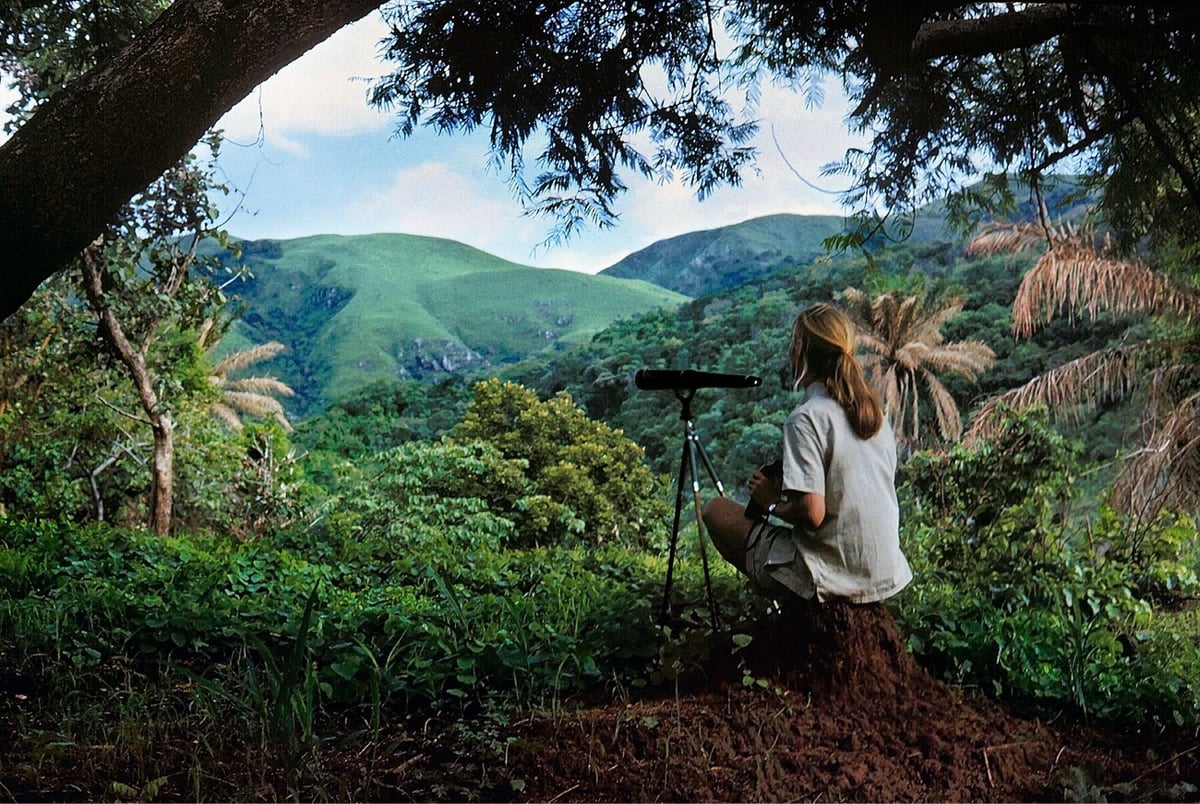
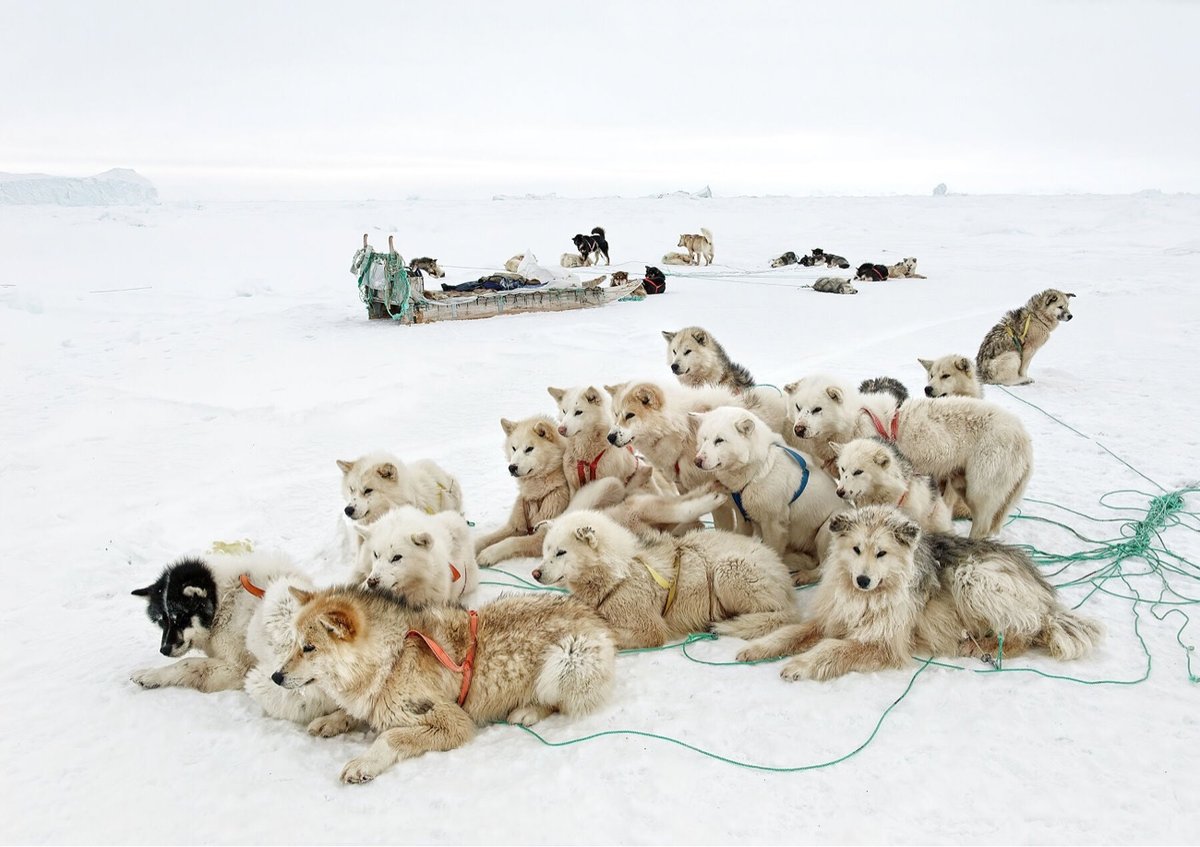

In honor of Jane Goodall’s 90th birthday, Vital Impacts organized a fundraiser selling 90 prints from 90 women photographers. The collection includes some of Goodall’s own work and 60% of the proceeds to the Jane Goodall Institute.
I’ve selected a few of my favorites above — photos by (from top to bottom) Hannah Le Leu, Jane Goodall, Tiina Itkonen, and Luisa Dörr (see also Female Bolivian Skateboarders Shred in Traditional Dress). (via colossal)
New favorite vocabulary word: wankpanzer (basically, “tank for jerks”). “A pointlessly large and overpowered 4x4 vehicle, usually purchased as a boost to driver’s ego who is likely to have some kind of inferiority complex.” Like the Cybertruck.
“May thy knife chop and shatter.” A quick update on Choppke’s (my chopped sandwich restaurant chain): a new ad that features one of our snazzy looking hoodies.
High-Diving Penguin Chicks
When emperor penguin chicks go for their first swim, they usually jump a few feet into the sea. The group of chicks in the video National Geographic video above decided to leap off of a 50-foot ice cliff for their first trip out.
It’s not unusual for emperor penguin chicks to march toward the ocean at a young age, even when they’re just 6 months old. They jump just 2 feet off the ice to take their first swim, according to National Geographic.
Others have jumped from a much a higher altitude, heading to “sheer ice cliffs” knowingly to make the first jump. Satellites have recorded the death-defying jumps since 2009, but what happens next has remained a mystery until now.
Having watched the video, “leap” and “jump” are charitable descriptions of what the penguins are doing here. “Flop”, “plop”, and “fall” might be better…penguins are all kinds of cool, but no one has ever accused them of being graceful out of the water.
Love this Letterboxd movie list title: “Definitely there was love, oh but the circumstances”. Films include Portrait of a Lady on Fire, Past Lives, Normal People, Brokeback Mountain, Titanic, and Lost in Translation.
US courts & legislatures are giving women the curse of time travel into the past. “Can you hear ragtime music? Can you see the stars without satellite interference? / No, everything is the same, except, for some reason, the laws governing my body.”
End-Stage Poverty Is Killing People in Safety Net-Free America
Many Patients Don’t Survive End-Stage Poverty by Dr. Lindsay Ryan is a great/upsetting piece about how the poverty many Americans are subjected to in America is killing them. Many people die here in the world’s richest country not because they are sick but because they are poor and our systems of government, justice, business, and health care don’t do enough to help them (or, more cynically and perhaps truthfully, actively work against helping them).
This is one of those pieces where I want to quote every single paragraph, but I’ll start with this one (bold mine):
Safety-net hospitals and clinics care for a population heavily skewed toward the poor, recent immigrants and people of color. The budgets of these places are forever tight. And anyone who works in them could tell you that illness in our patients isn’t just a biological phenomenon. It’s the manifestation of social inequality in people’s bodies.
I have not been able to stop thinking about this phrase since I read it: “Illness in our patients isn’t just a biological phenomenon. It’s the manifestation of social inequality in people’s bodies.”
Medical textbooks usually don’t discuss fixing your patient’s housing. They seldom include making sure your patient has enough food and some way to get to a clinic. But textbooks miss what my med students don’t: that people die for lack of these basics.
People struggle to keep wounds clean. Their medications get stolen. They sicken from poor diet, undervaccination and repeated psychological trauma. Forced to focus on short-term survival and often lacking cellphones, they miss appointments for everything from Pap smears to chemotherapy. They fall ill in myriad ways — and fall through the cracks in just as many.
You should read the whole thing yourself (NY Times gift link). Her argument about the need to expand/shift the definition of what healthcare is (e.g. housing is healthcare) reminds me of this more progressive idea of freedom.
Always a good day to read Daniel Radcliffe’s open letter to J.K. Rowling on her anti-trans nonsense. “It’s clear that we need to do more to support transgender and nonbinary people, not invalidate their identities, and not cause further harm.”
A Pareto analysis of the best driver/kart build you can drive in Mario Kart 8. “The Pareto efficiency is an objective criteria to filter out suboptimal choices, but you still need to make up your final decision.”
As optical illusions go, this is pretty good.
Papyrus 2: A Bold New Look for Avatar
Ryan Gosling was on Saturday Night Live this weekend and they did a sequel to one of my favorite SNL sketches (which is completely dorky in a design nerd sort of way) ever: Papyrus. Behold, Papyrus 2:
Avatar spawned worlds, right? Every little leaf of every little flower, every little eyelash of every little creature: thoroughly thought out. But the logo: it’s Papyrus, in bold. Nobody cares. Does James Cameron care? I don’t think so.
So kottke[dot]org had some significant downtime this weekend but it seems to be humming along nicely now. In celebration, we’re not planning on having any significant downtime today! 🤞
Proudly Second Best!



A clever ad campaign by an Ikea franchisee highlights how their products for kids can’t quite replace the support and comfort offered by their caregivers. (via @gray)
Starting in 1978, a high school science teacher told his students that he was throwing a viewing party for the 2024 solar eclipse. More than 100 of them showed up.
Liam Neeson is starring in a Naked Gun reboot? Why? Is it because his name sounds like Leslie Nielsen’s? (Nielsen? Neeson. Neeson? Nielsen.)
Mount Etna Volcano Blowing Perfect Smoke Rings
My current natural obsession is Mount Etna, a volcano in Sicily that blows perfect smoke rings like it’s frickin’ Gandalf with a pipe-full of Old Toby or something.
It is a relatively rare phenomenon caused by a constant release of vapours and gases. The gaseous mass ascends rapidly through the central part of the conduit, promoting the formation of rings by wrapping the gas upon itself in a vortex motion.
Puff on, Etna, puff on.
Why don’t we have solar eclipses every month? Because we don’t deserve them! (Ok no, it’s that the orbital planes of the Earth and moon are skewed slightly relative to each other.)
Jamelle Bouie on the inappropriate use of the presumed intent of the long-dead framers of the Constitution to determine how we live today. “They cannot justify the choices we make while we navigate our world.”
20 Minutes of Charles Schulz Drawing Peanuts Comics
This is wonderful: a collection of video clips of Charles Schulz drawing his iconic Peanuts comic strip — “everything I could find of Charles Schulz drawing his Peanuts characters” in the words of the compiler.
Unfortunately, I’m not highly educated. I’m merely a high school graduate. I studied art in a correspondence course because I was afraid to go to art school. I couldn’t see myself sitting in a room where everyone else in the room could draw much better than I and this way I was protected by drawing at home and simply mailing my drawings in and having them criticized.
I wish I had a better education but I think that my entire background made me well-suited for what I do. If I could write better than I can, perhaps I would have tried to become a novelist and I might have become a failure. If I could draw better than I can, I might have tried to become an illustrator or an artist and would have failed there. But my entire being seems to be just right for being a cartoonist.
Charles Schulz: Unbothered. Moisturized. Happy. In his lane. Focused. Flourishing.
See also a 90-minute compilation of cartoonists working (from the same YT channel) and Chuck Jones demonstrating how to draw Bugs Bunny and other characters. (via open culture)
Moira Donegan: “OJ Simpson died the comfortable death in old age that Nicole Brown should have had.” He abused, stalked, terrorized, and then killed Nicole Brown & Ronald Goldman. Finally, a truthful obit of OJ.
This “overexposed” photo of the total eclipse by Randy Olson is just all kinds of wonderful. “I didn’t realize the overexposed frames had this much detail.”
The UN’s climate chief says governments, business leaders and development banks have two years to take decisive action on climate change. “Yet last year, the world’s energy-related CO2 emissions increased to a record high.”
Viral Videos I Missed: Is This Available? (Attorney General)
I missed this when it first came out — way back in 2021 — but my friend shared it in a group chat the other day, and it made me laugh out loud. It has 9 million views; where have I been?? But in the spirit of “sharing stuff I love, even if it’s old,” I post it here anyway. The 15,000-pound horse one is also great. Even … catchy? Creator Lubalin is a “regular” musician, too. (Thanks, Lucy!)
(To make sure Jason hadn’t already blogged about this, I searched the site for “attorney general,” lol. There were posts. But not about this.)
Take a Letter Maria, the Live Audience Music Video
R.B. Greaves’ 1969 hit “Take a Letter Maria” has been in my head for weeks now, and while this might be too much of a stretch, I’m realizing it shares something with “Jolene” — both are odd, wonderful songs sung to an initially unromantic female character. Maybe? Anyway, I was pleased to discover this live-audience version on YouTube. Also, is “Maria” due for a cover, or an update? Take a letter, Alexa…
What’s Happening Now That Might Only Make Sense in 1,200 Years?

This morning I mentioned to Jason that I was still thinking about the Mayan calendar/Julian calendar overlap thing — did both cultures really record the same solar eclipse?! — and how mind-blowing it is to even contemplate. We then talked about how crazy it must have been to live back then (in 790 AD) and see the sun just casually disappear, etc.
And then I was wondering: What’s happening now that people living in the year 3200 will pity us for not understanding? “Wow, can you imagine living back then and not knowing exactly how [viruses appear/cancer strikes/the Voynich Manuscript came into existence]? Or precisely what happened at Dyatlov Pass, or on board the Mary Celeste?” (Okay now I’m just googling “mysteries.”) Anyway, I’m not high, I swear. But please chime in if anything comes to mind. “It must have been so weird to not know what dogs were saying.”
It’s National Card & Letter Writing Month (🎉), and Metafilter just drew my attention to the American Library Association’s letter-themed games list, from which I learned of the upcoming Curios: Albrecht Manor: “an epistolary horror mystery experience”!
Diary Comics, Dec. 6-8
It’s another Thursday Afternoon With Edith, and here are a few more journal comics from back in December, when I was guest-editing this site and gearing up to have a baby!
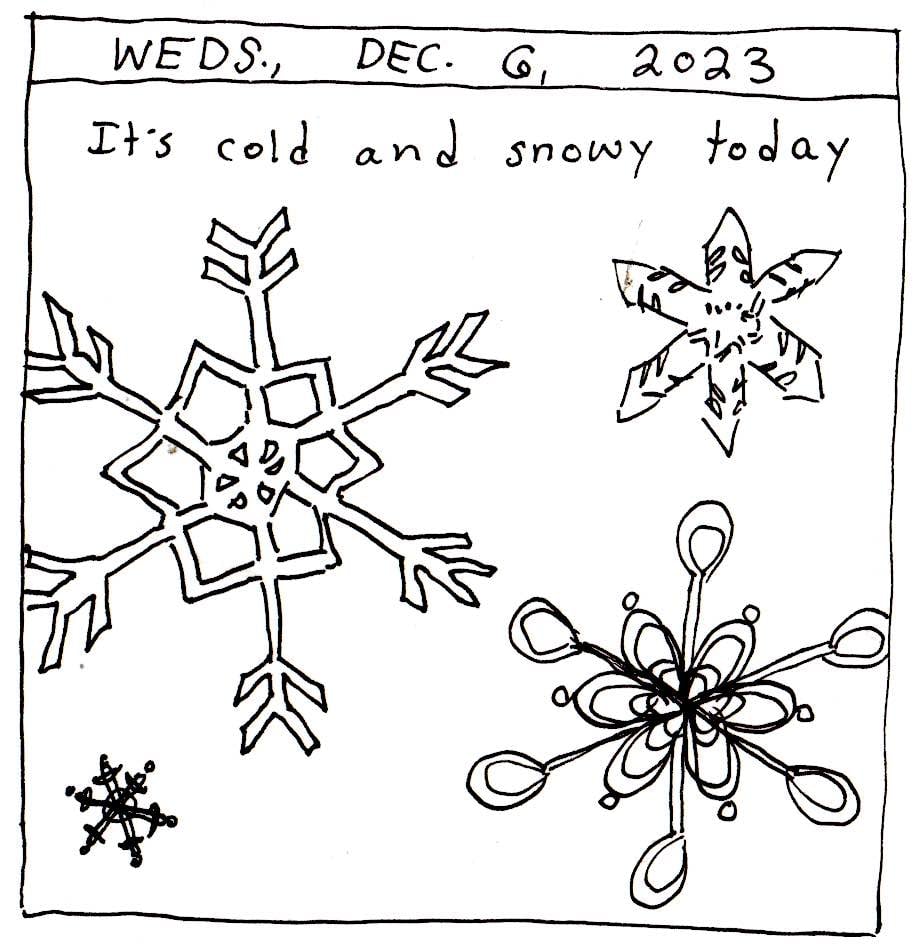



What Are the Odds?
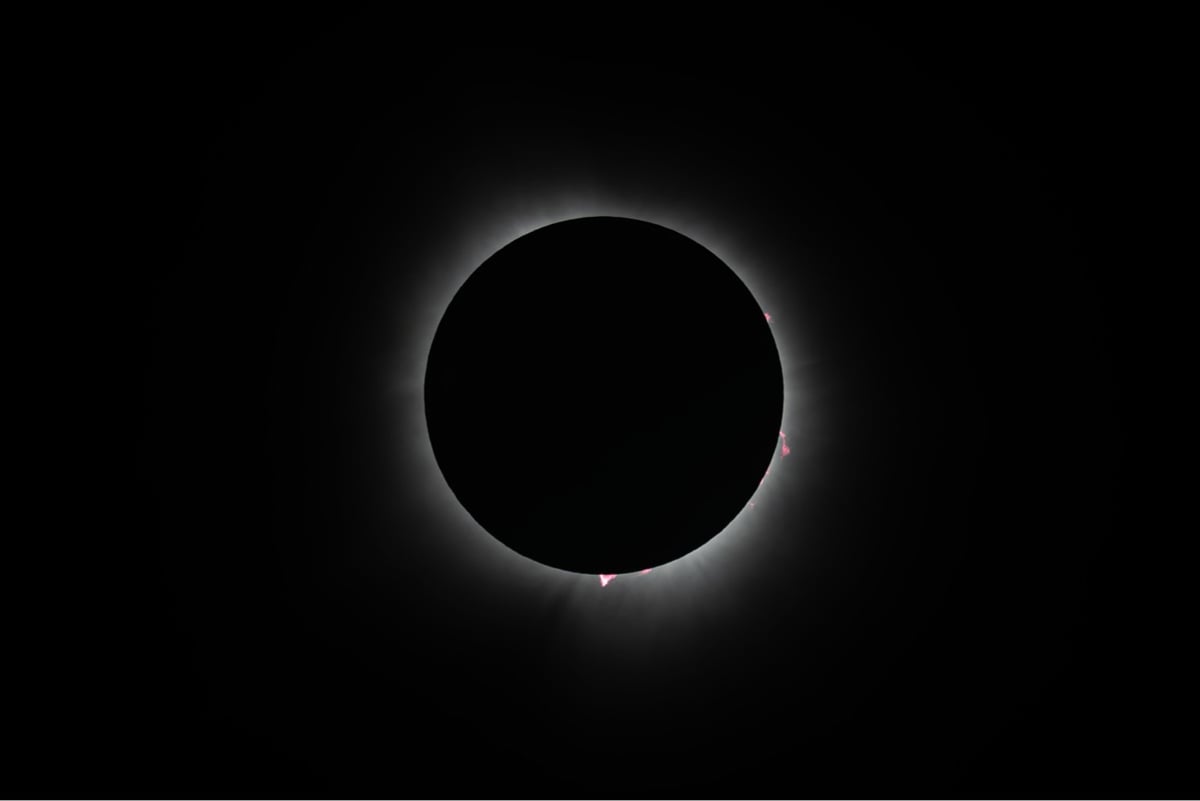
Ok, one last post about the total solar eclipse and then I’m done talking about it. (Maybe.)
There are so many mind-blowing things about eclipses but the one I can’t stop thinking about is the nearly impossible coincidence that the sun and the moon are the same relative size in the sky. If the moon were a little bit smaller or farther away, we wouldn’t have total eclipses where you can look directly at the sun, see the corona, the sky goes dark, you see a sunset effect all around the horizon, etc. That is some spooky magical shit. Ted Underwood put it this way:
Random accident that the moon and sun are the same apparent size here. If we had interstellar tourism, this is the One Thing that everyone would know about the Earth, and when they visited they wouldn’t want to see anything else. “We also have museums?” we’d say.
The moon is slowly drifting away from the Earth and total eclipses will gradually get rarer and rarer until, hundreds of millions of years from now, they will stop completely.1 That we’re all here right now, getting to experience this magical thing? Like, what?! If a science fiction writer made this up for a story, we’d say it’s too much.
And yet, for me at least, the coincidences don’t stop there.
When I saw my first total eclipse in 2017, we had to drive for 3.5 hours through three different rainstorms to find some clear skies. When we finally stopped, 40 minutes before totality, it was in a town so small that it’s not even called a town anymore: Rayville, Missouri. Yep, we found the sun in Rayville. What are the odds?
And then this year, on April 8th, the path of totality went right over my house in Vermont. In the past 70 years in Vermont prior to 2024, it’s been overcast about 50% of the time and only mostly sunny in 13 of those years. This year? Not a cloud in the sky when I woke up Monday morning.
I watched with a group of people in a big field in Colchester, including my friend Caroline and her dog, Stella (a name derived from the Latin word for star). There were a bunch of other groups watching in the field too and after totality had thrilled us all, they trickled back to their cars and homes. Our group stayed and I watched the last little bit of the moon slip past the sun through my telescope — it was officially over.
A large nearby group of folks with a couple of dogs left shortly after that. One of the dogs came over for a sniff and one of our party asked the guy what the dog’s name was. “Luna.”
And then Luna departed.
Seriously, what are the odds?
Eclipse photo above taken by my friend Mouser, with whom I witnessed the 2017 eclipse. It’s worth looking at large.
- I am sure, hundreds of millions of years ago, when the moon was closer to the Earth, total eclipses were a whole other level of whoaaaaa — lasting for 10-20 minutes at a time, completely blocking out any light from the sun, total darkness all around, etc.↩
It works! Three men stranded on a tiny Pacific island for more than a week were rescued after the Coast Guard spotted “HELP” written out on the beach in palm leaves. (A similar rescue from the same island happened in 2020 — “SOS” that time.)
How to Be a Climate Activist Even Though You’re Too Shy to Interrupt Anything. “You want to add your voice to the movement, make ‘good trouble,’ and stand for something for once in your goddamn life, but, unfortunately, you’re an introvert.”
I’m the Draft List at This Brewery and No, You Can’t Have a Light Beer. “Sure, we made a ‘normal’ IPA once. But then we were like, why make a beer that’s enjoyable to drink when we could make a beer that’s not?”
The Pyramids of Giza, Shrouded in Mist



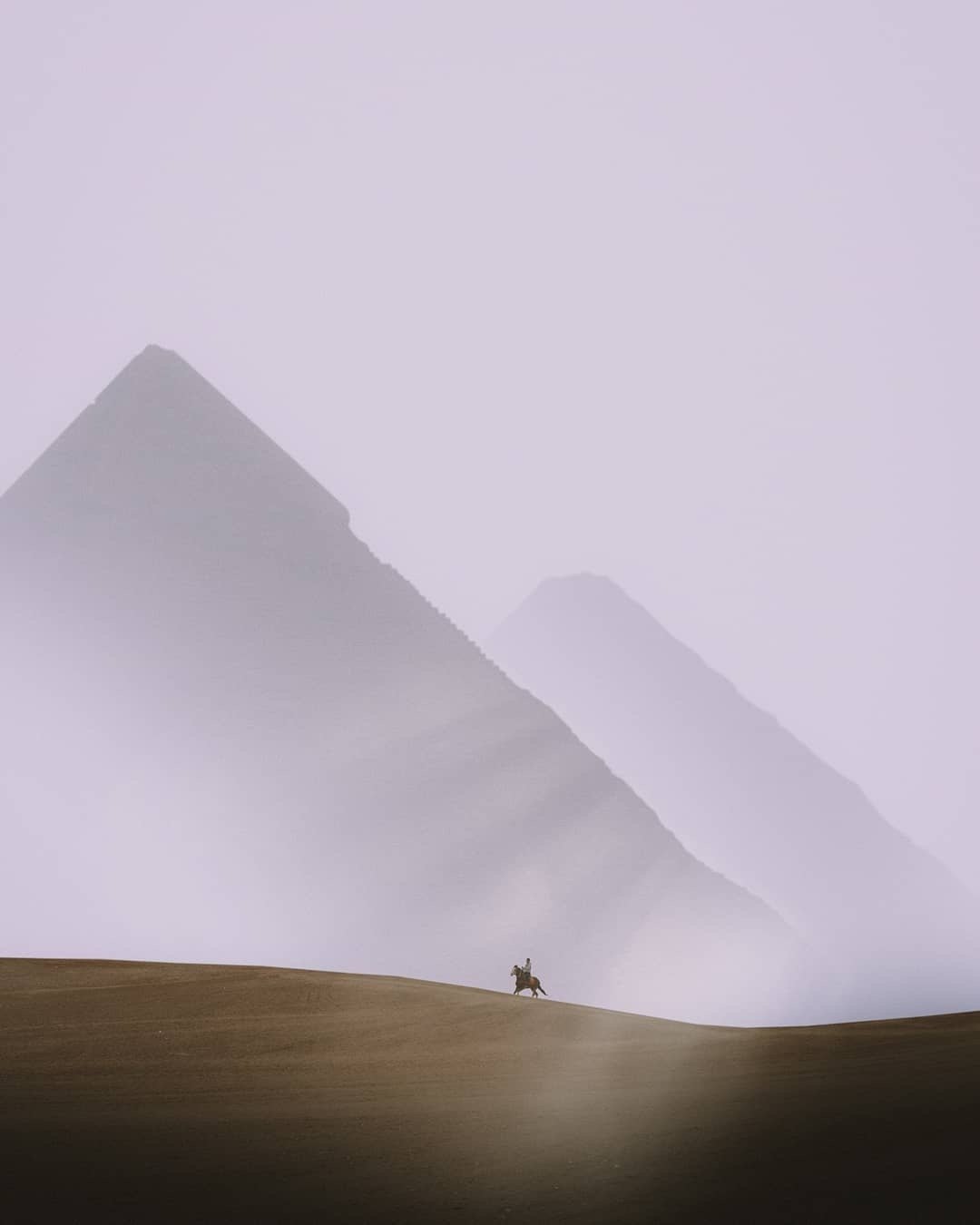
Wonderful shots of the pyramids of Giza by Egyptian photographer Karim Amr. From a caption on one of his photos three years ago:
I’m a 21 years old photographer you can see a lot of photos I share at the pyramids cause I just live near the pyramids so it’s easy for me to go and shoot there. I started doing photography to share my thoughts with others it’s how I express my feelings it’s also my escape from life. Life is tough and not easy for some of us and you got to find your place in this world.
Prints of his photos are available and you can follow his work on Instagram.
Capricious social media algorithms are modern-day Greek gods: “Oh my crops failed and my daughter died so that means Athena is angry — maybe??! … Just let us see posts from people we follow instead of telling us we’re praying to the wrong god.”
“Men who say they are pro-life and want to reduce or eliminate abortion are lying. They don’t care about abortion at all, they simply want to control women.” (BTW, I got a vasectomy, it’s great, would recommend, A+.)
The Function of Colour in Factories, Schools & Hospitals (1930)
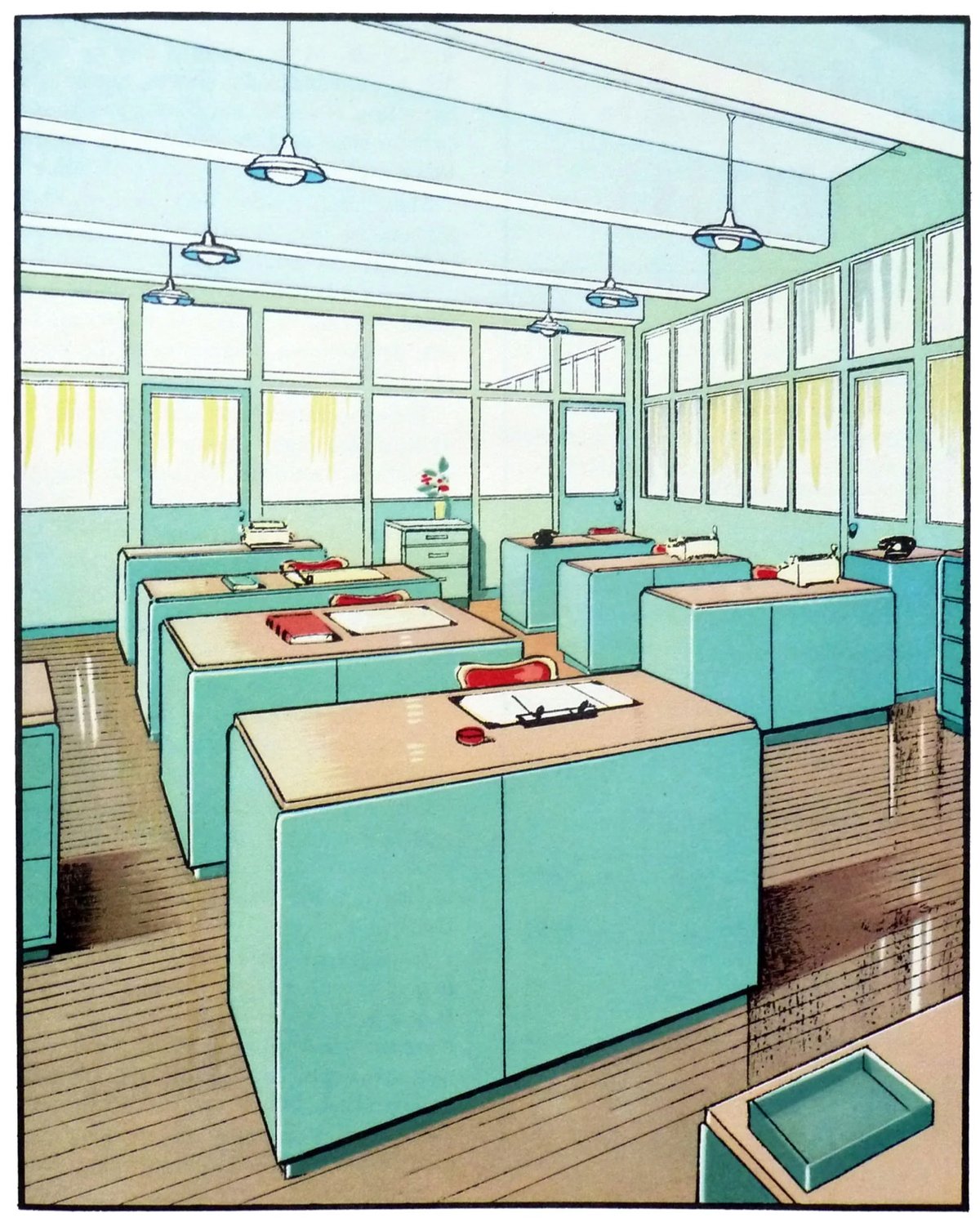
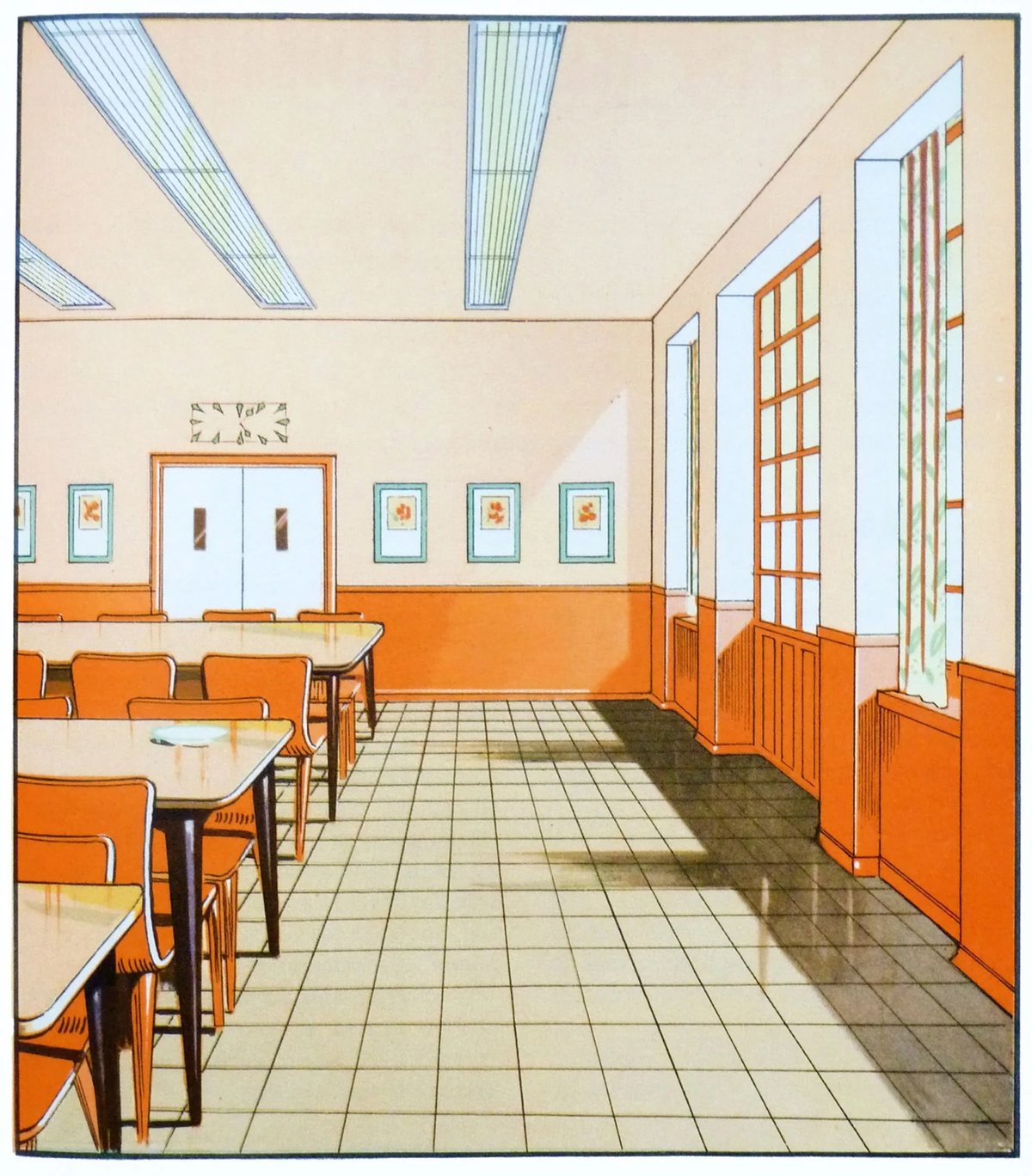


If you’re looking for some color palette inspiration, check out these scans from The Function of Colour in Factories, Schools & Hospitals (1930). Which is presumably a book? Whatever…the precision and colors of these illustrations are marvelous.
Adam Moss and the Creative Process
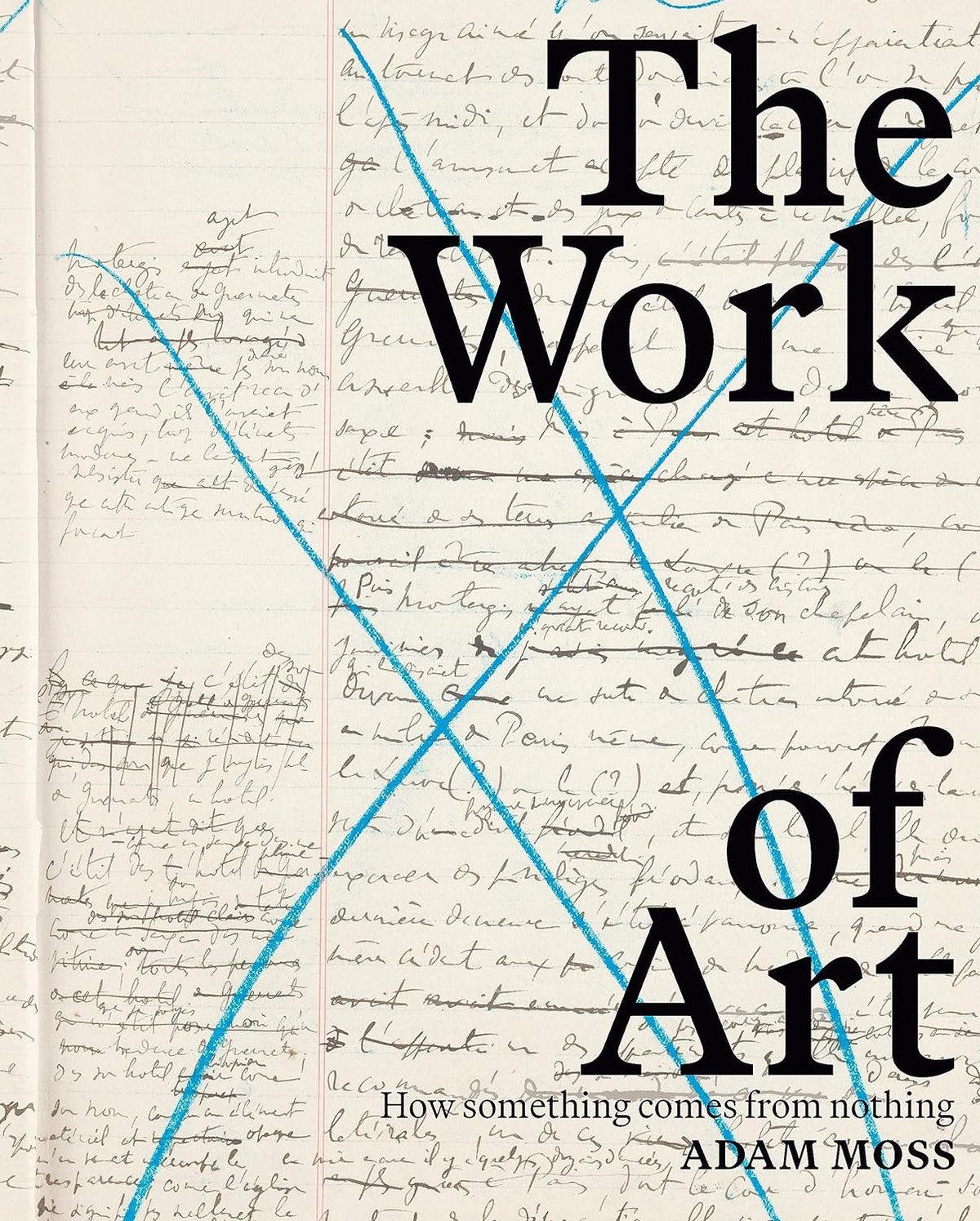
When I quit my magazine job, I decided to try my hand as an artist. … I got frustrated easily and gave up easily, never knowing when to persevere or surrender. …
My curiosity is earthbound: Where do [artists] begin, and what do they do next, and when do they know they are finished? And more crucially: What do they do when they lose faith? Do they lose faith?
In an adaptation from his new book, The Work of Art: How Something Comes From Nothing, former New York magazine editor Adam Moss shares his interviews with Kara Walker, Louise Glück, and Cheryl Pope, about their respective creative processes [Vulture]. My favorite part is the intro, though, where he talks about his own process (“that was the beginning of my torment”).
I’m hoping the answer to the “persevere or surrender” question is in there very explicitly, by the way!
A map of the “foreign” origins of our global diet. “You cannot walk on water or raise the dead. But you can do something that Jesus never did: eat a banana.” (Or tomatoes, potatoes, or chocolate.)
The saga of the Coyote vs. Acme movie and what it says about today’s overly complex media landscape. “Millions of dollars and thousands of hours went into creating something that could simply vanish into accounting.”
I loved reading through this social history of restaurants in NYC — basically who ate where and when. “The restaurants here were great not because of what they were but because of who we were and who we became while we were there.”
What Happens If We Do Nothing About the Climate Crisis?
Let’s say the countries of the world most responsible for the changing climate continue to drag their feet on doing something about it. What is the world going to look like in 20 or 30 or 80 years? This TED-Ed video describes that bleak potential future.
Reports on heatwaves and wildfires regularly fill the evening news. Summer days exceed 40 degrees in London and 45 degrees in Delhi, as extreme heat waves are now 8 to 9 times more common. These high temperatures prompt widespread blackouts, as power grids struggle to keep up with the energy demands needed to properly cool homes. Ambulance sirens blare through the night, carrying patients suffering from heatstroke, dehydration, and exhaustion. The southwestern United States, southern Africa, and eastern Australia experience longer, more frequent, and more severe droughts.
Meanwhile, the Philippines, Indonesia, and Japan face more frequent heavy rainfall as rising temperatures cause water to evaporate faster, and trap more water in the atmosphere. As the weather becomes more erratic, some communities are unable to keep pace with rebuilding what’s constantly destroyed.
(via open culture)
A new “less competitive” version of Scrabble is coming soon. “Younger people, Gen Z people…want a game where you can simply enjoy language, words, being together and having fun creating words.”
New Japanese anger management technique just dropped: “Writing down your reaction to a negative incident on a piece of paper and then shredding it, or scrunching it into a ball and throwing it in the bin, gets rid of anger.”
Eclipse COMPLAINTS?

Okay, yes, the eclipse was pretty cool, but we weren’t in the path of totality (we were at like 96%), so I didn’t have the Transcendent Experience that some have described. I mean, it was definitely neat. And we did get cute pictures. And it does sort of feel like a little gremlin has been set loose in my soul. But my neck was also sore the day after. Worth it???
The Climate Charts Are Not Okay. “The charts are hilariously underpowered attempts to depict just how out-of-balance we have rendered the world.”
Sherwood has a really interesting & bloggy front page for a news site. Punchy & heavy on images like social media. I feel like this sort of thing rhymes with what I’m trying to do with the ol’ dot org.
The Design of Books: An Explainer for Authors, Editors, Agents, and Other Curious Readers. That’s me! I am curious about the design of books! (Seriously tho, this looks great.)
David Lynch: Depression Kills Creativity
David Lynch is not having any of that “you need to struggle or be tortured in order to be creative” stuff. In this video compilation, the director talks about how poor mental health inhibits art & creativity.
It stands to reason: the more you suffer, the less you want to create. If you’re truly depressed, they say you can’t even get out of bed, let alone create. It occupies the whole brain, poisons the artist, poisons the environment; little room for creativity.
Open Culture has more on how Lynch uses transcendental meditation to improve his mental health…and a great anecdote about the one time Lynch tried therapy:
In one Charlie Rose interview, a clip from which appears in the video, he even tells of the time he went to therapy. The beginning of this story makes it in, but not the end: Lynch asked his new therapist “straight out, right up front, ‘Could this process that we’re going to go through affect creativity?’ And he said, ‘David, I have to be honest with you, it could” — whereupon Lynch shook the man’s hand and walked right back out the door.
Finally: an answer to Aaron’s question about the confusing freezer knob: do you turn it clockwise or counterclockwise for colder? “The knob’s designer should feel bad!”
Hank Green lost his hair during chemotherapy and it grew back curly. Turns out this is a thing that happens to many people: chemo curls!
Amanda, There Is No Audience

The writer Amanda Fortini tweeted something a couple weeks ago that I haven’t stopped thinking about:
Years ago, when I was in my 20s, a bold and artistically daring older friend who has since passed on gave me what I often think was the best advice I have ever gotten. I was worrying what ‘people would think’ of a decision I had made, and she said, “Amanda, There is no audience.”
The tweet went viral, so this probably isn’t news to a lot of readers. But I’ve been saying it to myself ever since: Amanda, there is no audience. Somehow, for a few seconds at a time, it makes sense to me on a very deep level. The “Amanda” part seems essential, too, for whatever reason.
“Buying a soccer club is probably one of the worst investments you can make.” A group of 140 Americans bought a third-tier Danish football club called Akademisk Boldklub. Niels Bohr was the club’s keeper back in the day!
As food service in US prisons gets outsourced, quantity and quality is sacrificed in the name of profit. “It’s not uncommon for a day’s worth of food to be a one bologna sandwich, one cheese sandwich and a few crackers.”
The Best Photos and Videos of the 2024 Solar Eclipse
Well, the total solar eclipse was once again completely awesome. I didn’t have to go chasing all over tarnation this time, the telescope worked out amazingly well, and I got to share it with a bunch of first-timers, both in-person and via text. I’m going to share some thoughts, photos, and videos from others around the internet in an even bloggier fashion than usual. Here we go.
My pal Noah Kalina got one of my favorite shots of the day (see also + prints are available):

Gobsmacking shot from Rami Ammoun…it’s a blend of multiple exposures so you can see the sun and moon at the same time. Love this shot.
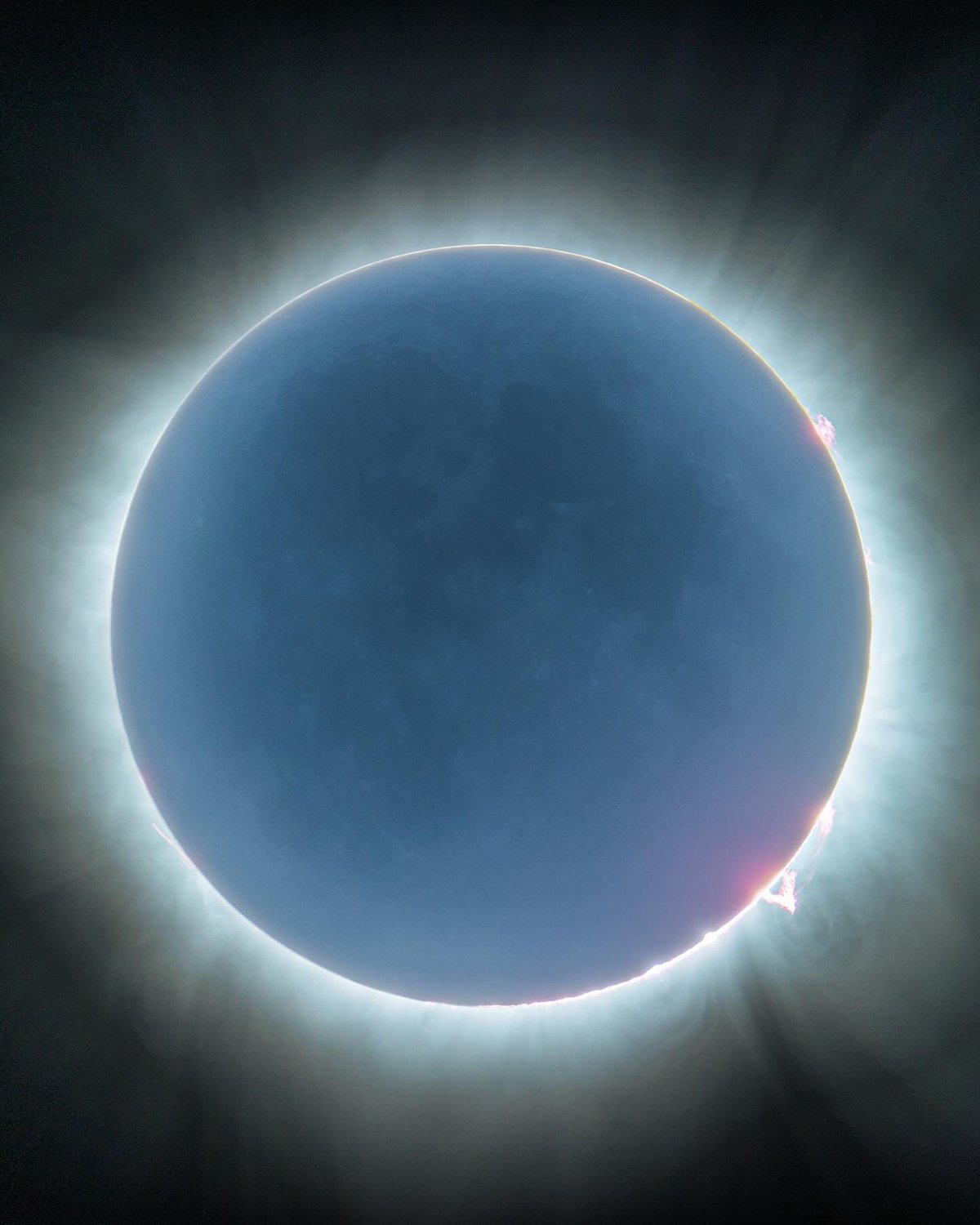
And another stunner from Andrew McCarthy:
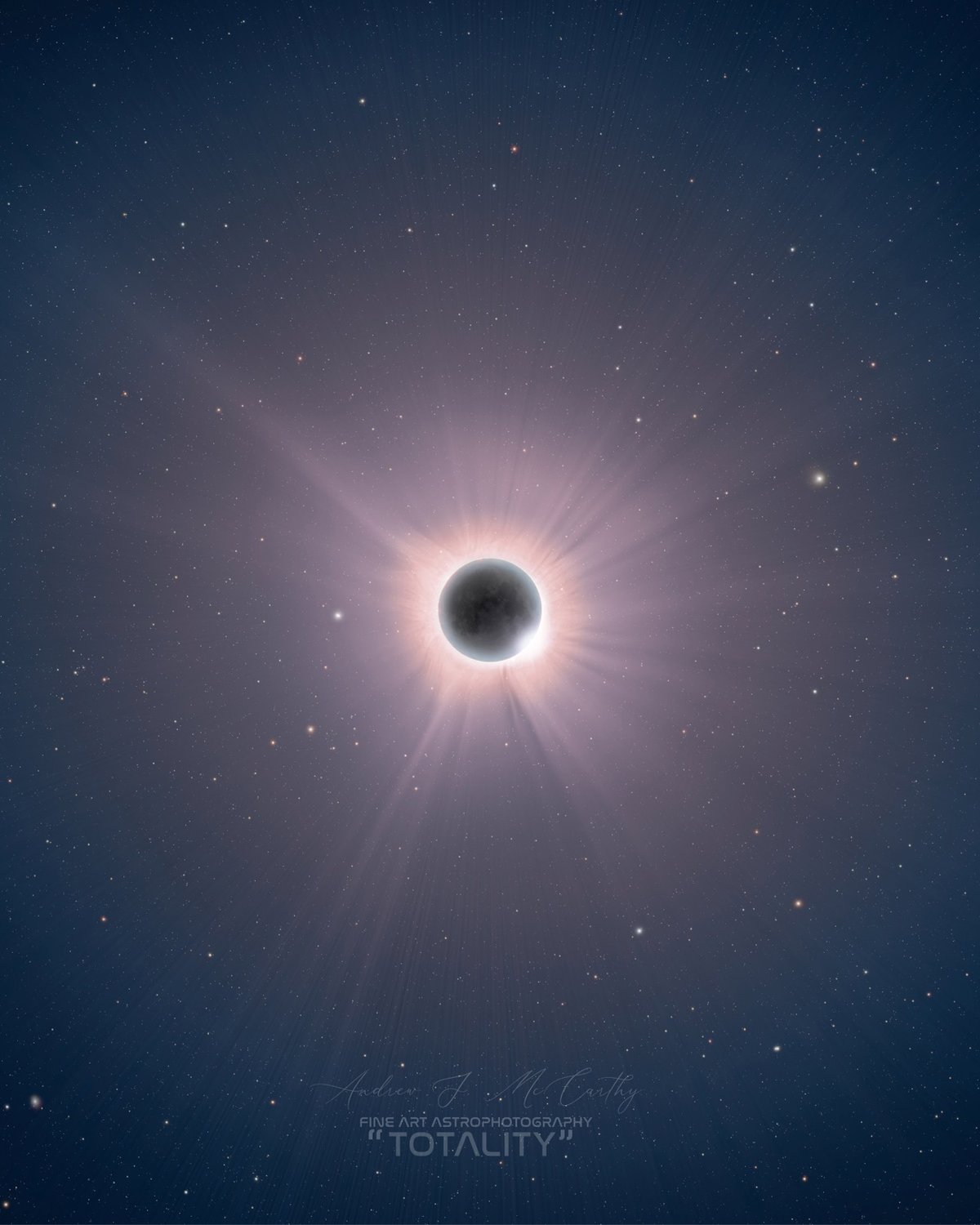
Ryan Cox got some great shots of the solar prominences during totality.
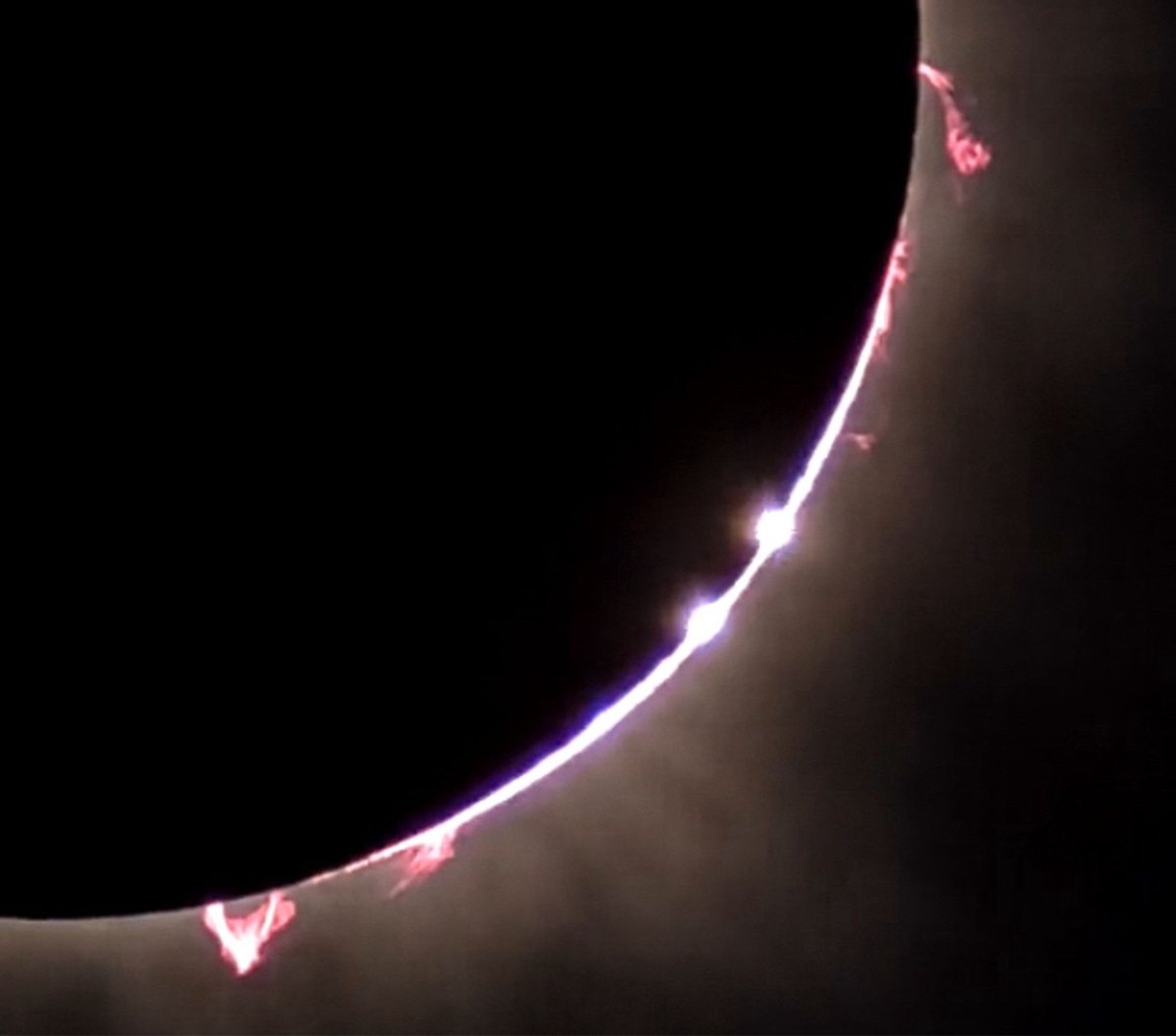
Quick solar prominence explainer interlude: if you had a clear look at totality, you may have noticed some orange bits poking out around the moon. NASA: What is a solar prominence?
A solar prominence (also known as a filament when viewed against the solar disk) is a large, bright feature extending outward from the Sun’s surface. Prominences are anchored to the Sun’s surface in the photosphere, and extend outwards into the Sun’s hot outer atmosphere, called the corona. A prominence forms over timescales of about a day, and stable prominences may persist in the corona for several months, looping hundreds of thousands of miles into space. Scientists are still researching how and why prominences are formed.
The red-glowing looped material is plasma, a hot gas comprised of electrically charged hydrogen and helium. The prominence plasma flows along a tangled and twisted structure of magnetic fields generated by the sun’s internal dynamo. An erupting prominence occurs when such a structure becomes unstable and bursts outward, releasing the plasma.
A timelapse video of totality from Scientific American:
Thomas Fuchs caught some sunspots through his telescope during the partial eclipse. (We saw these through our ‘scope as well.)
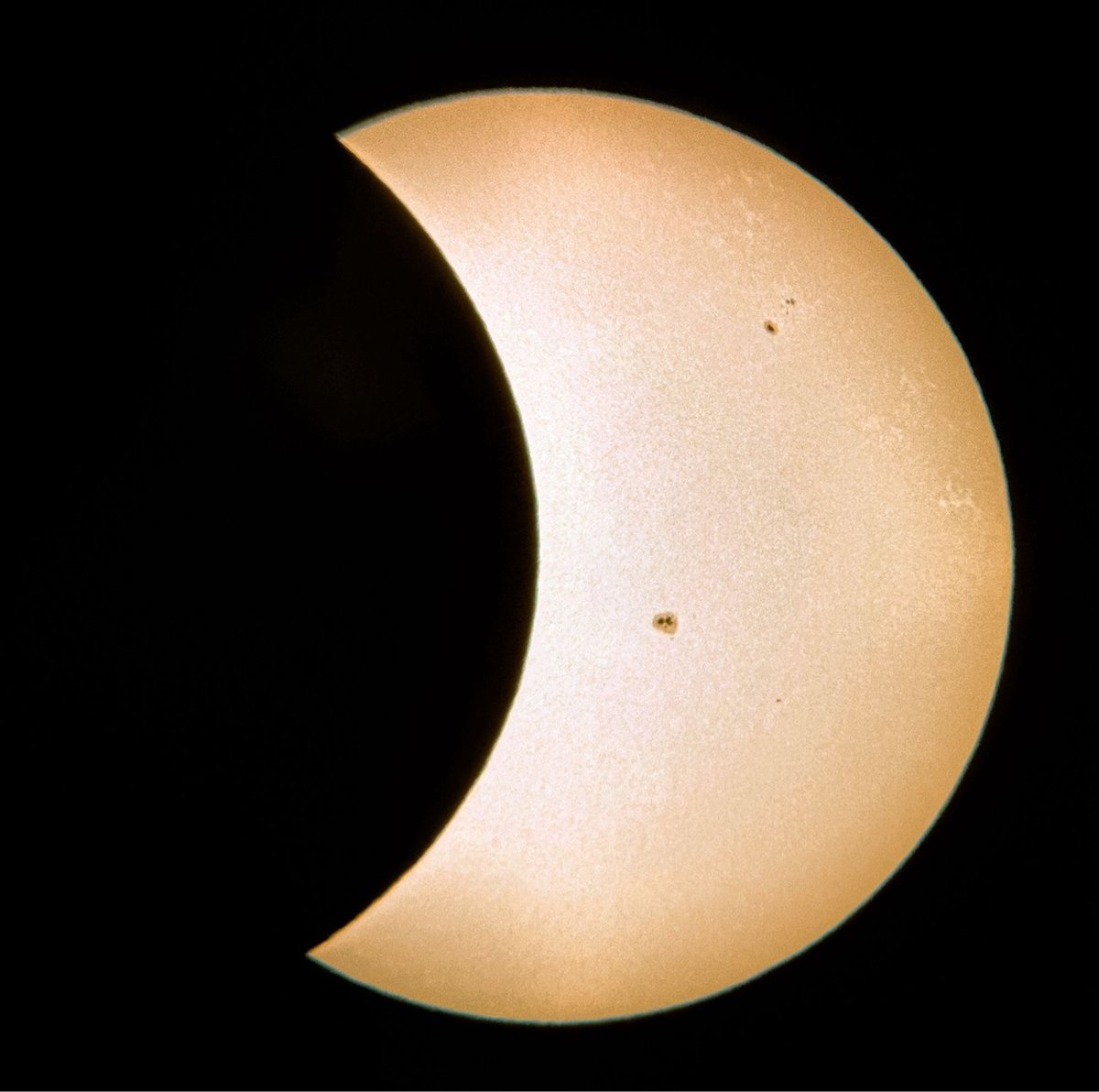
Quick sunspot explainer interlude. NASA: What exactly is a sunspot?
A sunspot is simply a region on the surface of the sun-called the photosphere-that is temporarily cool and dark compared to surrounding regions. Solar measurements reveal that the average surface temperature of the sun is 6000° Celsius and that sunspots are about 1500° Celsius cooler than the area surrounding them (still very hot), and can last anywhere from a few hours to a few months. Sunspots expand and contract as they move across the surface of the sun and can be as large as 80,000 km in diameter.
Sunspots are magnetic regions on the sun with magnetic field strengths thousands of times stronger than the Earth’s magnetic field, and often appear in pairs that are aligned in an east-west direction. One set will have a positive or north magnetic field while the other set will have a negative or south magnetic field. The field is strongest in the darker parts of the sunspots — called the umbra. The field is weaker and more horizontal in the lighter part-the penumbra. Overall, sunspots have a magnetic field that is about 1000 times stronger than the surrounding photosphere.
This Instagram account has a lovingly assembled collection of solar eclipse stamps from around the world (Aruba, Bhutan, Chile, Romania, Kenya, and even North Korea).

A NY Times timelapse: See the Total Solar Eclipse’s Shadow From Space (assembled from NASA and NOAA satellite imagery).
Great solar prominences on this shot from Notorious RBMK. Wow:

A timelapse video from Ariel Waldman of totality in Mazatlán. You really get a sense of the eclipse as a passing shadow from this.
Incredible “tiny planet” panorama timelapse by Matt Biddulph. Here’s a still frame during totality:
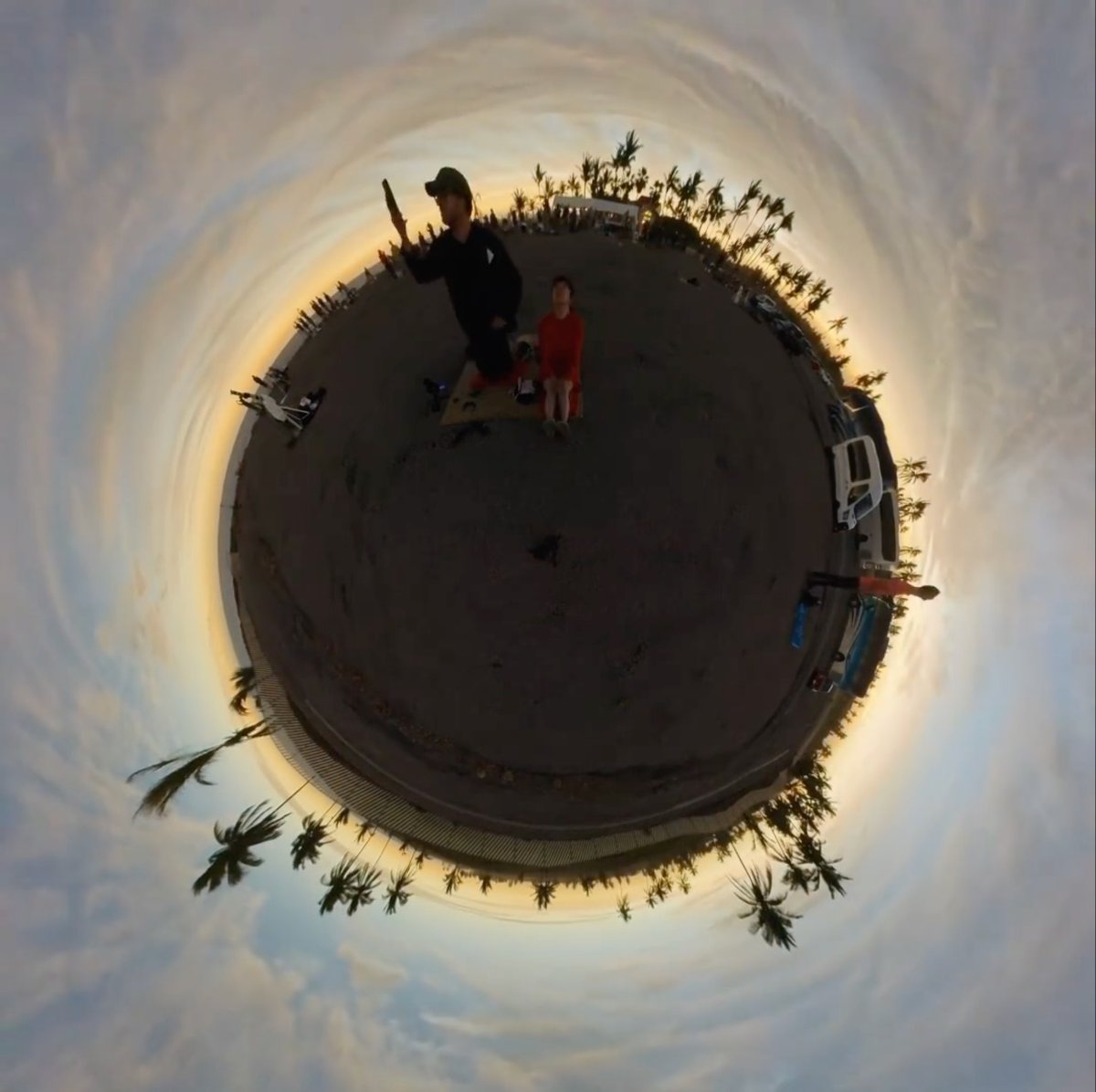
The 8 types of eclipse photo from XKCD.
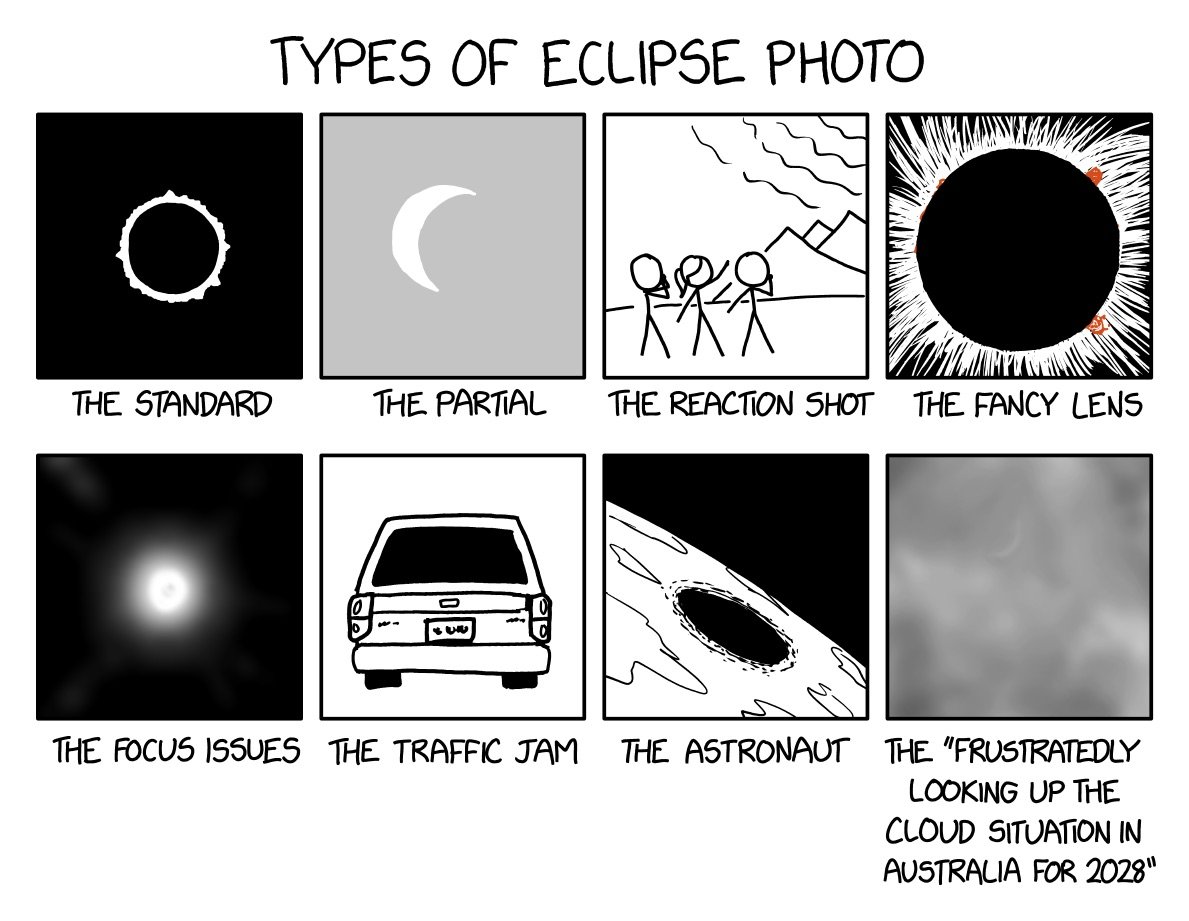
The view of the eclipse from the International Space Station.
More photos from The Dammich, fotoelliott, max GORDON, good thread of photos, and photo round-ups from PetaPixel, New Scientist, BBC Science Focus, Mashable, Associated Press, and Wired.
Video from Nate Luebbe of the moment of totality, with Baily’s beads and solar prominences.
This is a fake. Super super cool looking, but a fake. (Update: not quite a fake, just a really badly enhanced version of this composite HDR photo.) And I’m not sure I entirely trust the veracity of the trending search results for “why do my eyes hurt” but here it is anyway.
Earth Will Have Its Last Total Solar Eclipse in About 600 Million Years:
Total solar eclipses occur because the moon and the sun have the same apparent size in Earth’s sky — the sun is about 400 times wider than the moon, but the moon is about 400 times closer.
But the moon is slowly moving away from Earth by about 1-1/2 inches (4 centimeters) per year, according to the NASA statement. As a result, total solar eclipses will cease to exist in the very distant future, because the apparent size of the moon in Earth’s sky will be too small to cover the sun completely.
“Over time, the number and frequency of total solar eclipses will decrease,” Vondrak said in the statement. “About 600 million years from now, Earth will experience the beauty and drama of a total solar eclipse for the last time.”
If you want to get a headstart on trip planning, the next eclipse is going to be in Greenland, Iceland, and Spain on August 12, 2026. Cloud cover looks most favorable in Spain.
Ok, that’s all for now. Depending on what else I come across, I might update this post periodically throughout the day. I know some of you who were lucky enough to see the total eclipse shared your experiences in the comments of yesterday’s post but feel free to do so here as well.
It’s Eclipse Day!
Hey, gang. Today is the solar eclipse, it’s supposed to be mostly sunny here in Colchester, VT, we’ve got 3 minutes and 16 seconds of totality to enjoy, and I built a solar filter for my telescope (and binoculars!), so kottke.org is going to take the day off. Edith and I will see you back here tomorrow.
In the meantime, are you doing anything for the eclipse? Anyone got any crazy camera/telescope setups? Do you think Instagram is going to crash this afternoon? Will I completely lose my mind if a cloud drifts in front of the sun today at 3:26pm ET? Is it a coincidence or a miracle that we happen to be alive during the relatively brief period of time when the moon almost exactly covers the sun, resulting in total solar eclipses? Could you imagine if the eclipse somehow doesn’t happen today??!
A total solar eclipse that occurred on July 16, 790 was recorded in hieroglyphs on a Mayan monument (eclipse map). “This find has frequently been proposed as a way to establish a correlation between the Maya Calendar and the Julian Calendar.”
Vintage Eclipse Glasses From the 1932 Eclipse

From the Center for Research on Vermont at UVM, a pair of eclipse glasses from 1932. I found a product listing for these — they were marketed as the Eclipse-O-Scope and sold for 10¢.
VPR’s Nina Keck recently interviewed Floyd Van Alstyne, who is currently 104 but was 12 years old during the 1932 eclipse:
KECK: It was in the middle of the depression, he reminds me. And while he learned about the eclipse in his one-room schoolhouse, he doesn’t recall too much hoopla surrounding it.
F VAN ALSTYNE: I don’t know. We didn’t think much about general things in those days like they do now. Or we thought about minding their own business, I guess.
(thx, caroline)
What is everyone using for eclipse maps? I’ve been using this one from the National Solar Observatory. There’s also the NASA map, this one, and NYT’s cloud cover map.
I used Shadowmap to help a friend find a good viewing spot for the eclipse — it shows the sun’s position in the sky on a 3D map.
Fiction-Inspired Travel?
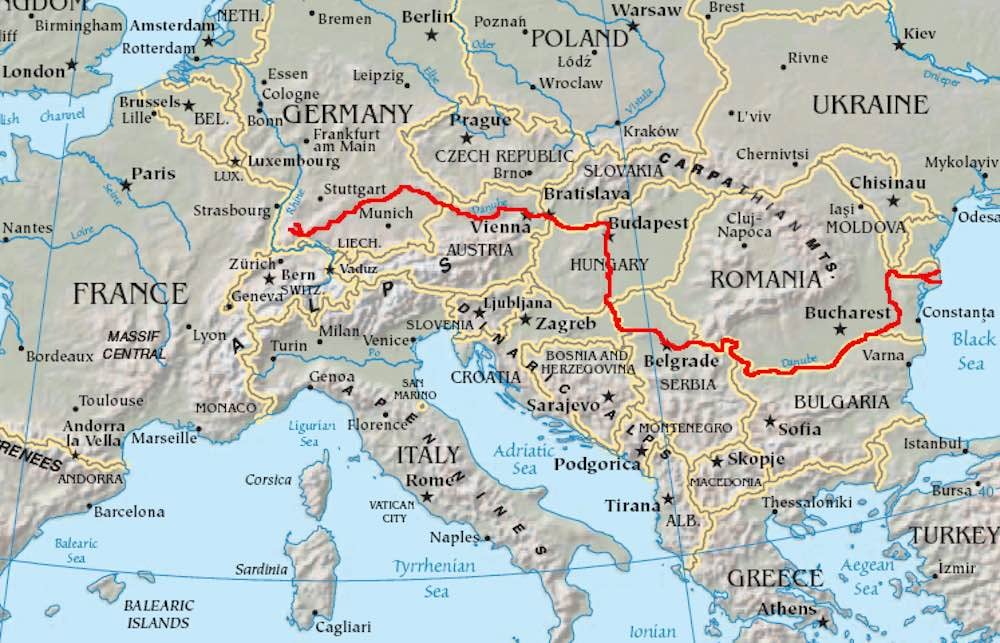
Has a novel ever made you desperate to travel somewhere? I’m reading The Historian, and I’m now dying to visit Eastern Europe. I want to see the Danube, visit Istanbul, and spend weeks in Dubrovnik. And, okay, maybe visit the monastery on an island in the middle of Lake Snagov! (Map of the Danube via wikivoyage.) Anyone else?
A Japanese economics professor asserts that if a law requiring spouses to have the same surname isn’t changed, every Japanese person will have a surname of “Sato” by 2531. (Hunch: this needs some factchecking.)
Film Footage of a Total Solar Eclipse from 1900
In 1900, celebrated magician (and astronomy enthusiast) Nevil Maskelyne travelled to North Carolina to film a solar eclipse on May 28, 1900. The Royal Astronomical Society and the British Film Institute reckon this is “the first surviving astronomical film in the world”.
In 1898 he travelled to India to photograph an eclipse. He succeeded but the film can was stolen on his return journey home.
It was not an easy feat to film. Maskelyne had to make a special telescopic adapter for his camera to capture the event. This is the only film by Maskelyne that we know to have survived.
The original film fragment held in The Royal Astronomical Society’s archive has been painstakingly scanned and restored in 4K by conservation experts at the BFI National Archive, who have reassembled and retimed the film frame by frame. The film is part of BFI Player’s recently released Victorian Film collection, viewers are now able to experience this first film of a solar eclipse since the event was originally captured over a century ago.
(via boing boing)
Crazy finish to the Chelsea / Man United match yesterday. “Cold” Palmer tied and then won it deep into added time…after some Chelsea fans had, perhaps understandably, already left. Always stay — there might be an end credits scene!
A magnitude 4.8 earthquake rattled New Jersey this morning around 10:23am. I felt it up here in Vermont too — just a little shimmy that lasted for maybe 8-9 seconds. April blizzard, earthquake, eclipse…all perfectly normal stuff going on here.
I was waiting for this: Tressie McMillan Cottom on Beyoncé’s genre-busting Cowboy Carter. “The only honest answer is that country music is everything she sings about minus the Black woman singing it.”
The Sound of Knitting
The above comes across as almost a parody of itself — halfway through, I thought This could be an SNL sketch! — but it’s also delightful. It’s a trailer for The Sound of Knitting, “an evening where classical music and knitting merge.” The popular designers and podcasters Arne & Carlos teamed up with the Norwegian string instrument group (heh) Trondheimsolistene to make a concert/tutorial/behind-the-scenes knitting video, available for purchase. In addition to featuring knitting-friendly music, the video includes a tour of the Norwegian municipality of Selbu, famous for its gorgeous mittens, as well as a virtual class on how to knit those mittens. It all seems lovely, although I confess I was slightly disappointed that “the sound of knitting” wasn’t an ASMR video of needles clicking, although I’m sure that’s out there, too. I mean, I know it is because I’ve seen it.
Plus, as a recent NY Times story outlined, handwork is good for the brain.
New Jolene Lyrics
I’ve always been intrigued by the “Jolene” lyrics (are they mature or are they insane?), so I was excited to hear Beyoncé’s version. Ultimately those lyrics didn’t really speak to me, but then I came across novelist Sonora Jha’s twist on the “Jolene” lyrics on Instagram, and I felt an itch had been scratched. I’ve transcribed those lyrics below — her original post is here.
(With apologies to Dolly and Beyoncé)
Jolene Jolene Jolene Jolene
I’m watchin’ you move in on my man
Jolene Jolene Jolene Jolene
I’m sayin you should say “I think I can”
You’re beautiful beyond compare
I hope you’ll pardon while I stare
Just wonderin’ what moisturizer you wear, Jolene
But good for you, oh good for you
You can have my man and my children too
Jolene
Don’t get me wrong, I love my man I love those kids as hard I can
But some days I could just, you know what I mean
Jolene
And if my man’s that easy to take
You can have him and also eat your cake Jolene
Jolene Jolene Jolene Jolene
I’m livin’ my best life and wish the same for you
Jolene
You freed up my every other weekend
For me to spend with my supercool friends
I love how you stepmom my kids, Jolene
I hope he’s showerin’ love on you
The way I tried to teach him to
You’re welcome, you’re welcome, you Queen Jolene
You say you don’t want him no more
But please don’t leave him at my door
Just tell me where to Venmo you, Jolene
Jolene Jolene Jolene Jolene
You could have your choice of men
And I’m wonderin’ if I’ll bother to love again
So l’II do me and you do you Jolene
Jolene Jolene Jolene Jolene
The kids are grown and happy too
I love how you found a better boo
Let’s all just move on, okay, please, Jolene
Diary Comics, Dec. 3-5
Here are some more comics from when I was guest-blogging here last fall! (Previously.) Should I be sharing these in a newsletter again? I don’t know, maybe so!
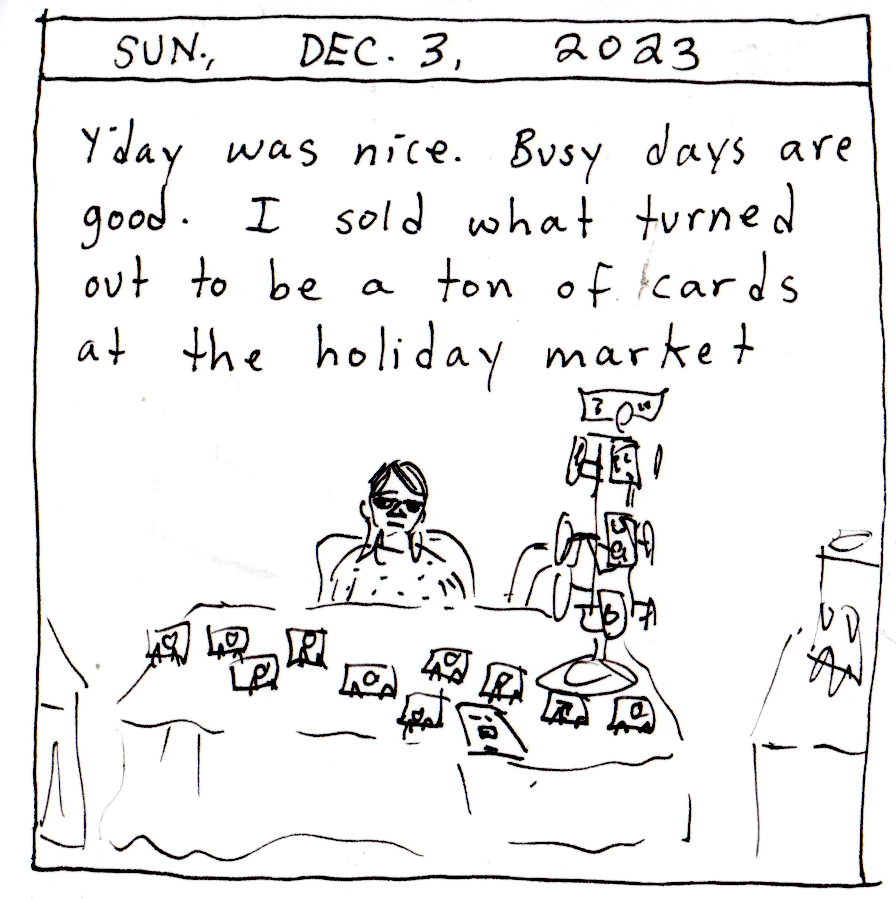
Entrepreneurial note: I sell cards on Etsy!



Bad news about beloved Trader Joe’s: The company “outsources inspiration for new products by targeting emerging brands under the guise of recruiting them to manufacture private-label items.” More like Pirate Joe’s, amirite?
The instructor of a course for nervous flyers recommends a “breathe and squeeze” technique for battling flight anxiety. “It’s perfectly normal. Let’s all make a conscious decision to squeeze our buttocks.”
Scientists have created the largest 3D map of our universe to date and there are “tantalizing hints” in the data that suggest that dark matter may not be constant after all.
Total Eclipse of the Heart, Literal Video Version
This video is more than 10 years old, but I hadn’t seen it before: a version of Bonnie Tyler’s music video for Total Eclipse of the Heart where the lyrics describe what we literally see.
Pan the room
Random use of candles, empty bottles, and cloth,
and can you see me through this fan?Slo-mo dove
Creepy doll, a window, and what looks like a bathrobe.
Then, a dim-lit shot of dangling balls.Metaphooor?
(via aaron)
This Woman Deconstructs 100-Year-Old Books To Restore Them
Sophia Bogle is an expert at restoring old books and I was riveted by this video of her taking viewers through the deconstruction and restoration process, including a tour of her workshop and some of the tools she uses (e.g. a repair knife she designed herself to resemble a fingertip).
But reader, I gasped when she signed her work…I don’t think I could do that! (via boing boing)
Farm Animal Family Photos
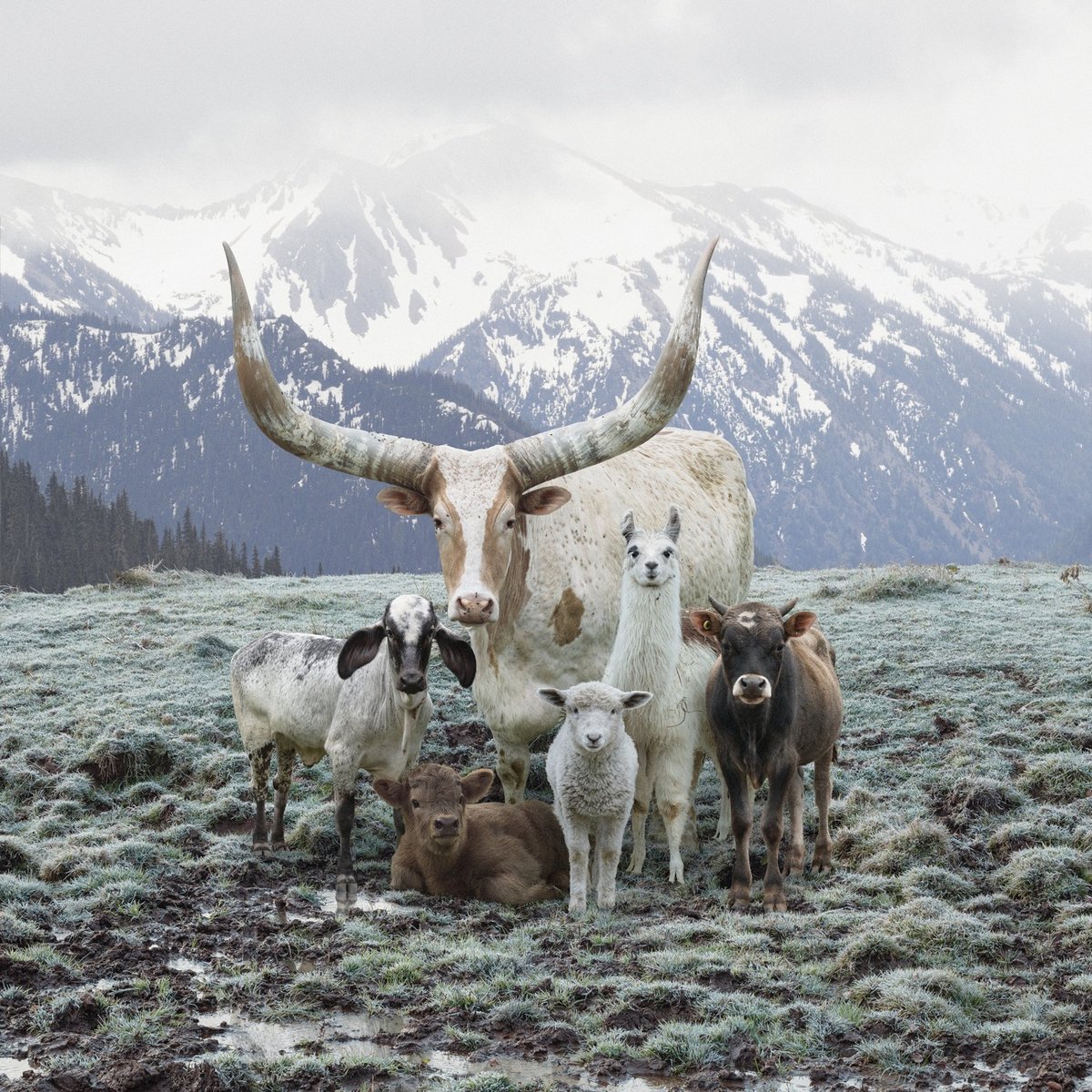

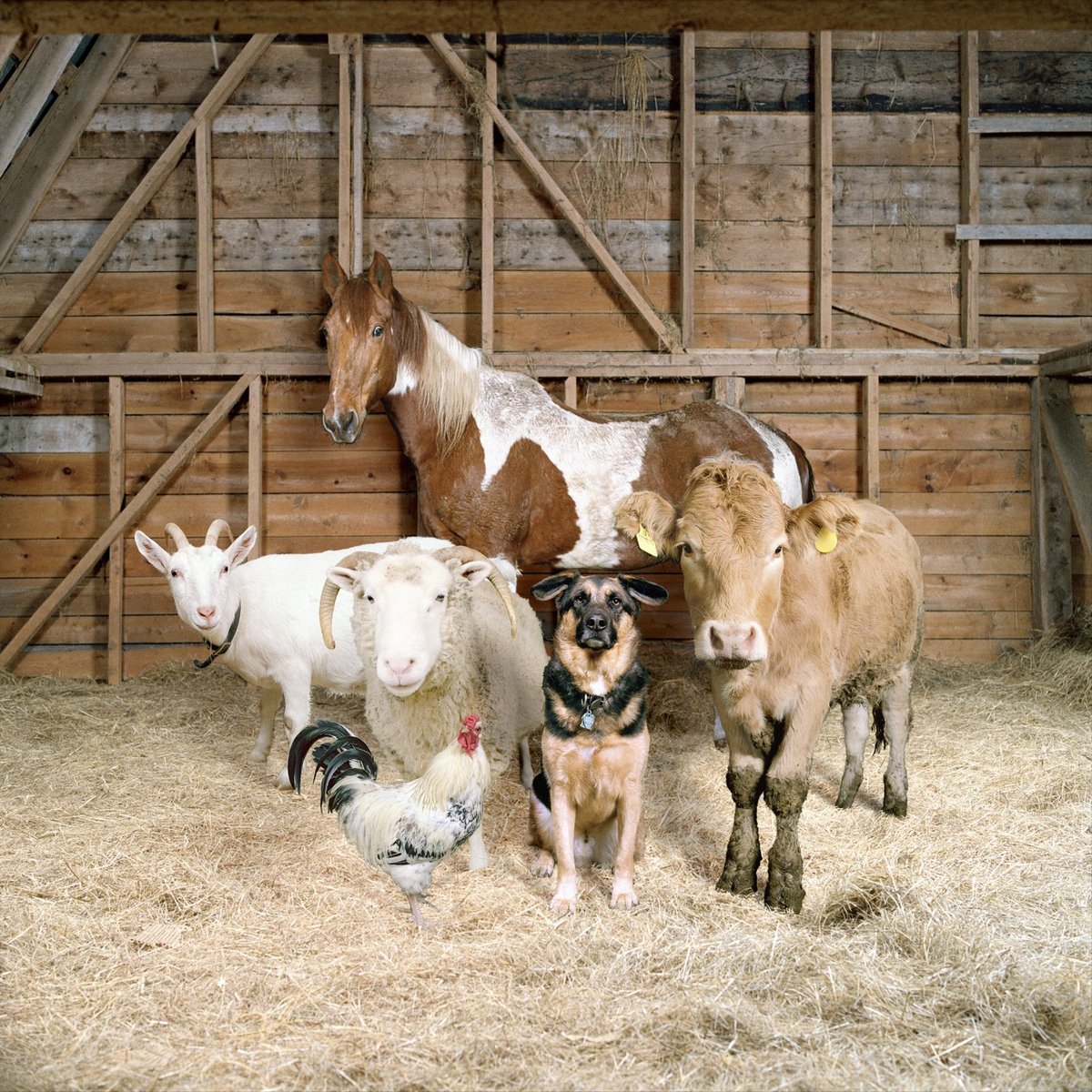
Rob MacInnis takes these great family photos of farm animals. I mean, gold medal to anyone who can actually get a chicken, dog, goat, sheep, cow, and horse to pose together like that. I also like his photo of this charming sheep.
You can check out more of his work on Instagram and his website. (via present & correct)
Crows are on the short list of animals that have domesticated humans. “We were the crow vending machine, I realized, and the birds had mastered the art of manipulating us for rewards.”
“A 600-Year-Old Blueprint for Weathering Climate Change”
This is a fascinating article by Kathleen DuVal about how climate change (including the Little Ice Age) affected social and political structures in North America in the 13th and 14th centuries.
But then the climate reversed itself. In response, Native North American societies developed a deep distrust of the centralization, hierarchy, and inequality of the previous era, which they blamed for the famines and disruptions that had hit cities hard. They turned away from omnipotent leaders and the cities they ruled, and built new, smaller-scale ways of living, probably based in part on how their distant ancestors lived.
While Europeans reacted to the Little Ice Age by centralizing and militarizing under hereditary absolute monarchs, Native Americans went in a decidedly different direction:
The cities that Native Americans left behind during the Little Ice Age-ruins such as those at Chaco Canyon and Cahokia-led European explorers and modern archaeologists alike to imagine societal collapse and the tragic loss of a golden age. But oral histories from the generations that followed the cities’ demise generally described what came later as better. Smaller communities allowed for more sustainable economies. Determined not to depend on one source of sustenance, people supplemented their farming with increased hunting, fishing, and gathering. They expanded existing networks of trade, carrying large amounts of goods all across the continent in dugout canoes and on trading roads; these routes provided a variety of products in good times and a safety net when drought or other disasters stressed supplies. They developed societies that encouraged balance and consensus, in part to mitigate the problems caused by their changing climate.
Being an adult in the 21st century is the continual discovery of things you never learned in school — how climate change has altered the course of history and changed our societies was not adequately represented in my history classes. (See, for example, how climate change played a role in Brexit.)
DuVal’s article is excerpted from her upcoming book, Native Nations: A Millennium in North America (Bookshop), which sounds really interesting:
A millennium ago, North American cities rivaled urban centers around the world in size. Then, following a period of climate change and instability, numerous smaller nations emerged, moving away from rather than toward urbanization. From this urban past, egalitarian government structures, diplomacy, and complex economies spread across North America. So, when Europeans showed up in the sixteenth century, they encountered societies they did not understand-those having developed differently from their own-and whose power they often underestimated.
The Discarded by Colin Hamilton sounds interesting…an imagined librarian pulls imagined books from the discard room at the library. “In an age of decreasing literacy, disposable content, and banned books, what do we preserve and what do we discard?”
Moira Donegan: “If the post-Dobbs era has shown us anything, it is that abortion is controversial only in theory. When faced with the material consequences of banning it, Americans find themselves unequivocally on freedom’s side.”
Eating Like a Salmon Is Better Than Eating Actual Salmon, Study Finds. “Eating lower on the food chain…can help humans get these critical vitamins, minerals, and fatty acids directly from the source.”
Paul Simon on The Late Show With Stephen Colbert
I missed this when it came out two weeks ago, but I’m glad to have found it this morning: Paul Simon unaccompanied, singing “Your Forgiveness” from his new album, Seven Psalms. (The 33-minute album is meant to be listened to all in one go.)
The docuseries Colbert mentions at the end — In Restless Dreams: The Music of Paul Simon, by Alex Gibney — came out on March 17 (trailer here). I haven’t seen it yet but very much want to.
Cutting and polishing a morganite stone into a 294 caret gem. It looks *amazing* when he’s done — skip to the 33:35 mark to see it sparkle in the outdoor light.
Blogging for this site has taught me that I’m more of a romantic than I realized: I loved these stories of people who found one another through missed connection posts. (With a nice undercurrent of creepiness.)
Upcoming new book from Steven Johnson: The Infernal Machine, “a new book about dynamite, anarchism, and the birth of the surveillance state”.
Why do we do what we know is bad for us? Here’s what ancient and modern philosophers (as well as economists) think about this conundrum. “This is a universal feature of being human.”
Drawing Media, an Interview With Jim Behrle
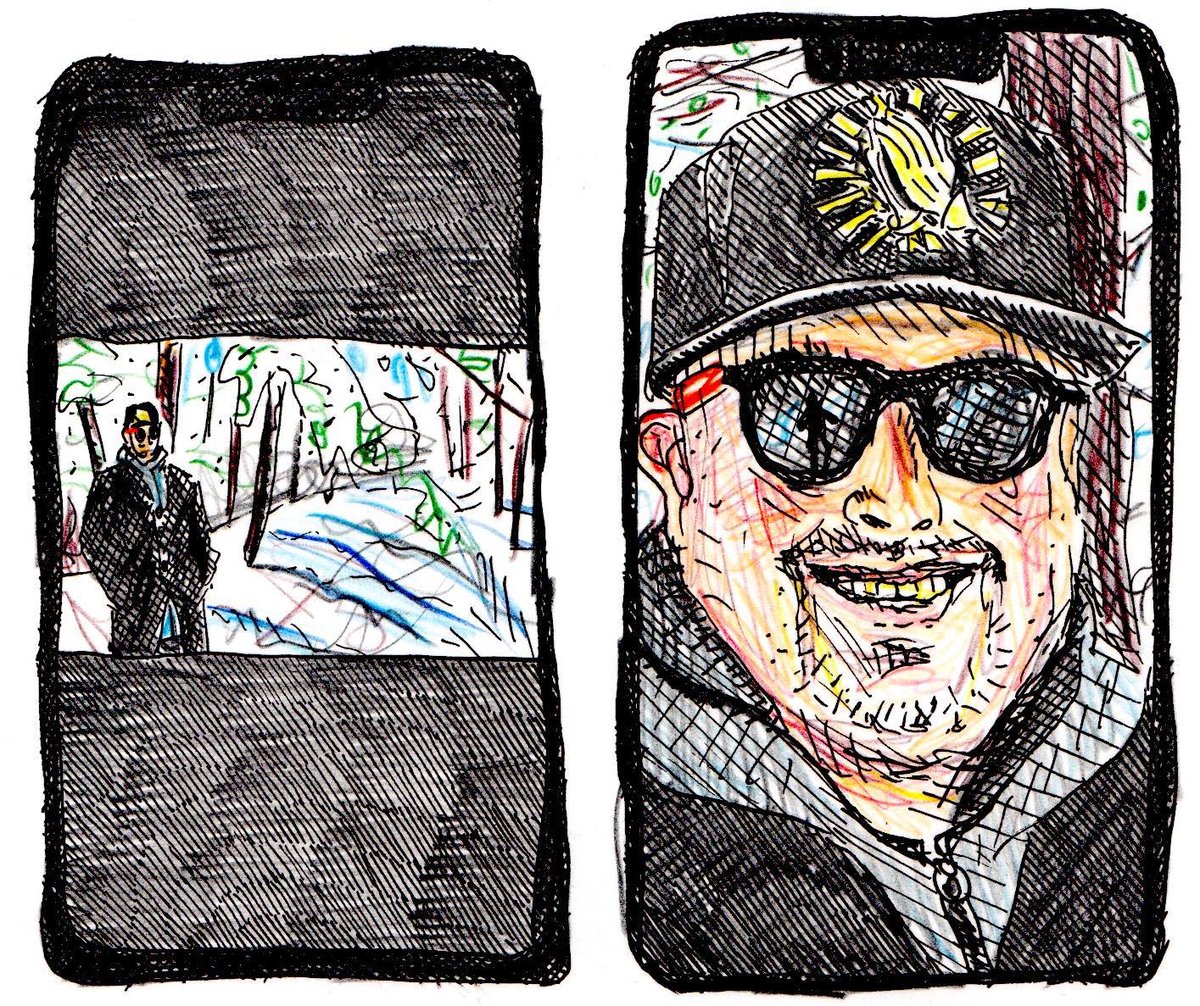
Edith here. For the second installment of my illustrated interview column, I talked with my friend, the poet Jim Behrle. He visited us recently, so I used a photo I took in person as reference for the portrait. Jim’s latest book of poems is called Hoetry, and you can catch him hosting Bad Animals on WFMU on Mondays 8-9pm. He’s also on Instagram.
Have you read, watched, or otherwise experienced anything good recently?
I listened to a YouTube video of a female choir in Minsk praying the Jesus Prayer, which I’ve been reading about in a book called The Way of a Pilgrim, written by an anonymous monk. The prayer is simple, although I have yet to memorize it: “Lord Jesus Christ, Son of God, have mercy on me, a sinner.” There are other, similar versions of it. I just kind of had these nuns praying in the background for like an hour. It was very peaceful.
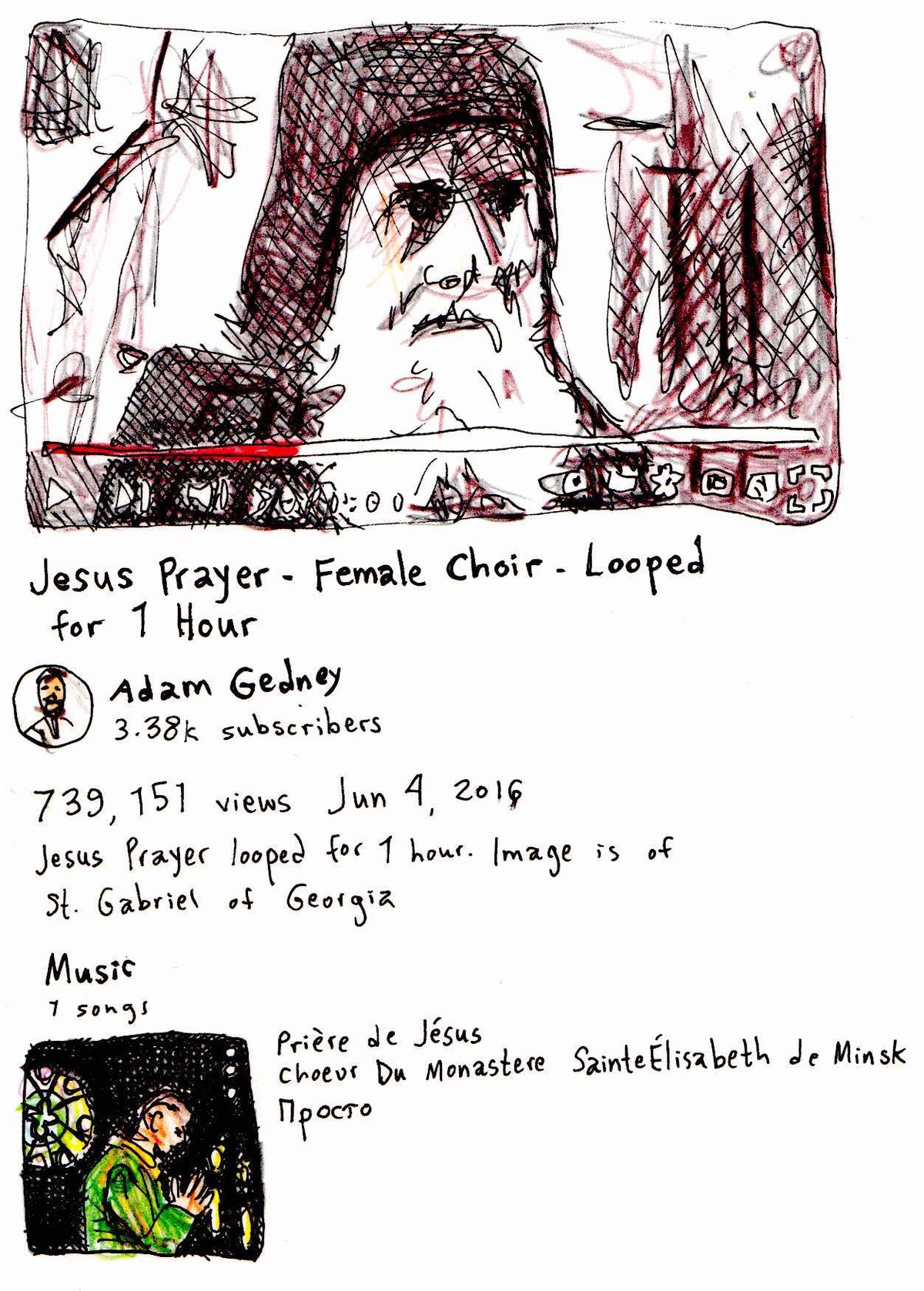
Prayer is so interesting, and I’ve always struggled with it. Like speaking in my mind coherently to an all-powerful force can seem a little redundant. God already knows everything about me. I also don’t like asking God for stuff all the time because doesn’t that make me a shitty friend? Or, if there is no God, is it silly to close one’s eyes and sit asking the vast emptiness to help me get a better job? Ultimately it may not matter one way or the other. The simple act of remaining still, perhaps kneeling, or having one’s eyes closed even for a few seconds might be its own reward. These nuns had a gentle, sing-songy mantra going on with the Jesus Prayer. I found it hypnotic, which I always like.
I saw Dune Two as well recently. It was good, although I was mostly interested in the worms and could watch a whole movie just about them.

Have you read or seen anything bad?
It wasn’t bad, necessarily, but I re-watched The Last Temptation of Christ, and I didn’t enjoy it as much as I thought I would. The depiction of Mary Magdalene as some sort of jilted woman who is fucking her way through the population of the Earth because Jesus won’t be her boyfriend or something was sort of weird this time around. Some pope mistook one Mary for another in the 5th century, and we’re still treating someone mentioned more in the Gospels than any of the other apostles as if she’s a love interest rather than a main character in her own right. But there were some really interesting shots of Jesus in the desert that I thought were pretty cool.
How’d you find out about either/both?
I’ve been slowly winding my way through some YouTube avenues of Christian mysticism videos and podcasts. And I like ambient sounds and background noise. And I love nuns. I don’t like nun horror movies and stuff, just like, nuns being nuns. There’s one Byzantine nun named Mother Natalia on a few podcasts I recommend.
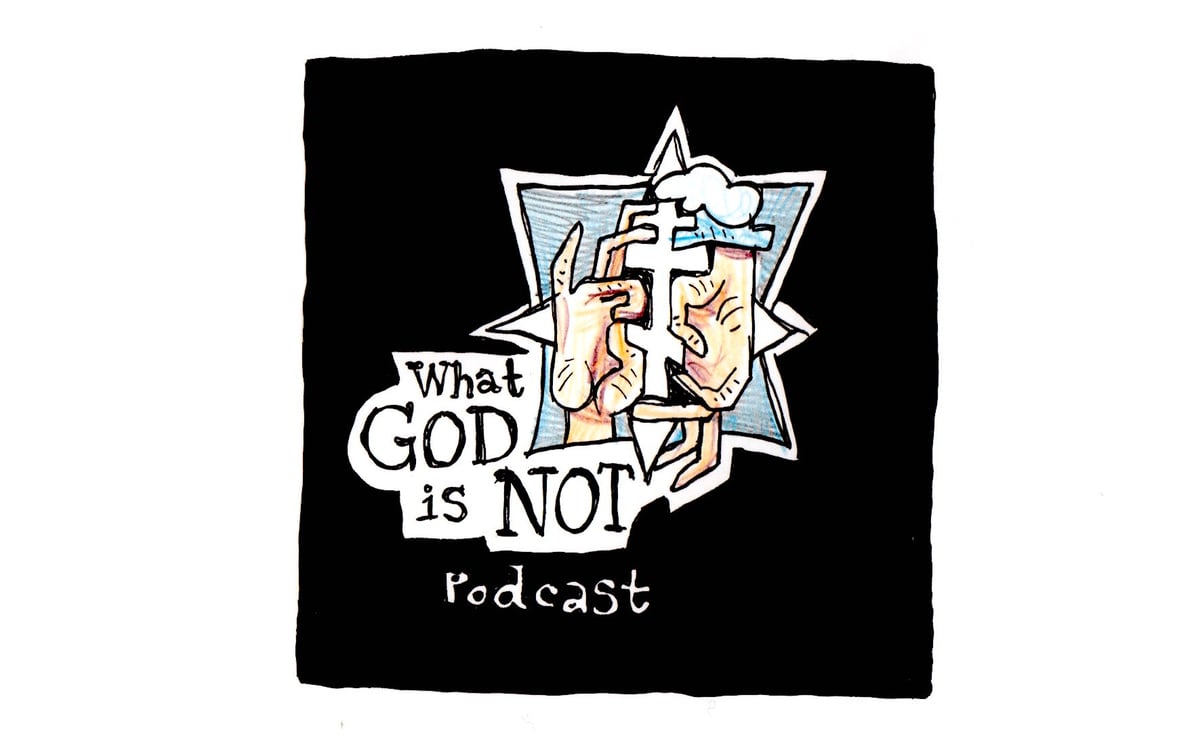
What’s something you’ve read or seen that changed your life?
I’ve been reading a book by Carl Jung called Answer to Job. In the Book of Job, in the Bible, God turns the life of one of his firmest believers upside down to win some pointless bet with the Devil. Jung’s assessment of God’s behavior and Job’s state of powerlessness is pretty eviscerating. I don’t know if it’s changed my life, but thinking about God not as a purely benign force in the universe is compelling.
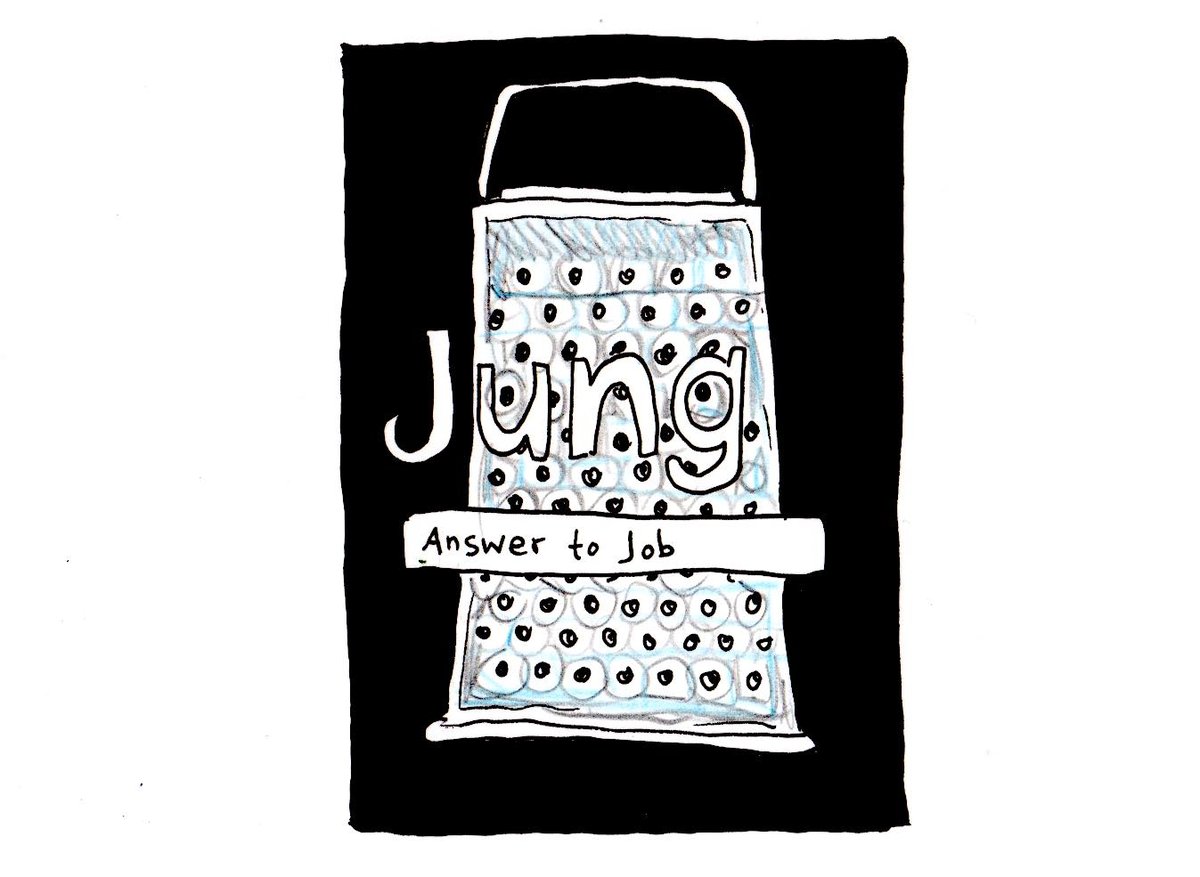
After God destroys the world with floods, God promises not to do it again with a rainbow. There is no rainbow at the end of The Book of Job. God doesn’t promise to not do to us what he did to Job, even if we do all the right things.

Do you subscribe to anything you don’t read?
Scientific American? I always forget to read it. But I read all the headlines eventually.
Read anything you don’t subscribe to?
I read most of the stories at mcstories.com every week. They’re erotic mind control stories. I am absolutely fascinated by them.

What’s something you’ve lied about reading or watching? Or felt tempted to lie about?
I always joke that I’ve read the first chapter of Crime and Punishment a million times, but it’s more like the first 10 pages about 10 times. I’ve worked in bookstores all my life, and I’ve read the back or inside cover of every book I ever shelved. Sometimes that’s enough of the book for me. I also have hundreds of books strewn about in some state of me “reading” them.
Does anything make you laugh online?
I usually only laugh inside if no one is around, and I’m usually alone when I’m experiencing the internet. If other people are around and laughing, I usually laugh out loud.

Are there any cultural moments you currently think about unusually often? Like are you haunted by a moment from a TV show, or anything like that?
I thought about the first scene from the Black Lodge on Twin Peaks for a long time. Now I’m haunted by what could have happened if Big Apple by David Milch hadn’t been canceled. Not only is David Milch my favorite TV writer, he’s the only one that was doing it correctly at all. I re-watched NYPD Blue a million times, over and over. His verbal universe is so immersive.
What were you really into when you were 12?
That was when I first got interested in comic books, I think. I ended up being very interested in them for a while. I would take whatever money I made from paper routes and mowing lawns to the mall and select a few different mostly Marvel Comics for 75 cents apiece. I didn’t really know many of the characters except maybe Spider-man, which I didn’t buy very often even though I like him (I think I don’t like watching him get beat up or struggle with being broke possibly). I also thought Mary Jane was all wrong for him. But I often think that when I see couples. Honestly, who knows what couples want from each other? I liked the Marvel mutant books, like early X-Factor, Chris Claremont X-Men, and New Mutants. But my favorite for some reason was Alpha Flight, which was this weird dysfunctional Canadian supergroup.
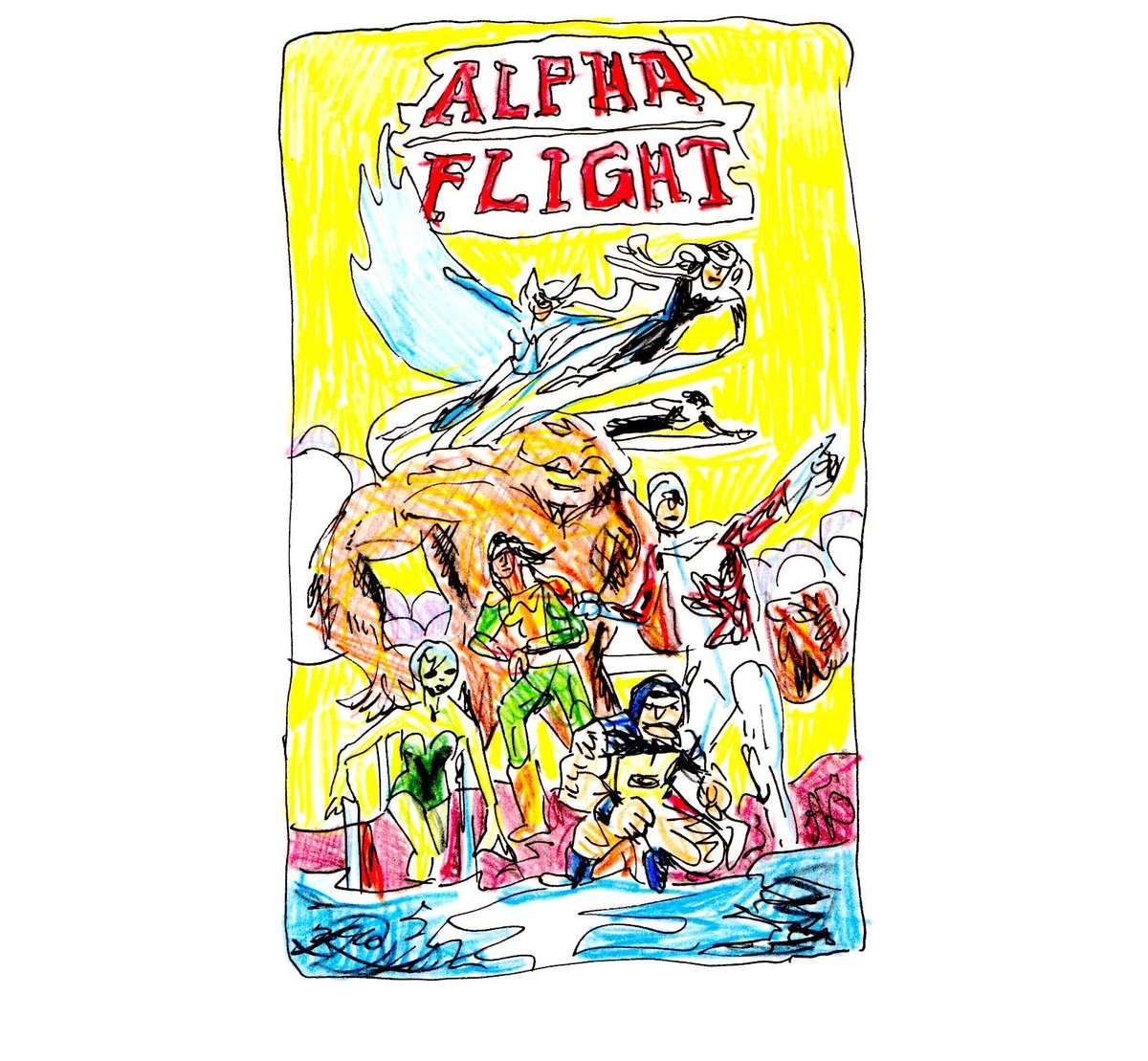
Is there a book/movie/whatever that you’d like to experience again for the first time?
I wonder if I would like to see Krzysztof Kieślowski’s Color Trilogy again. Or maybe I only loved that at the time. The first movie that blew my mind was Star Wars, which I saw on the big screen when I was very young, and I thought all movies were just going to be like that all the time. I’m not sure that holds up exactly, either, on re-watching.
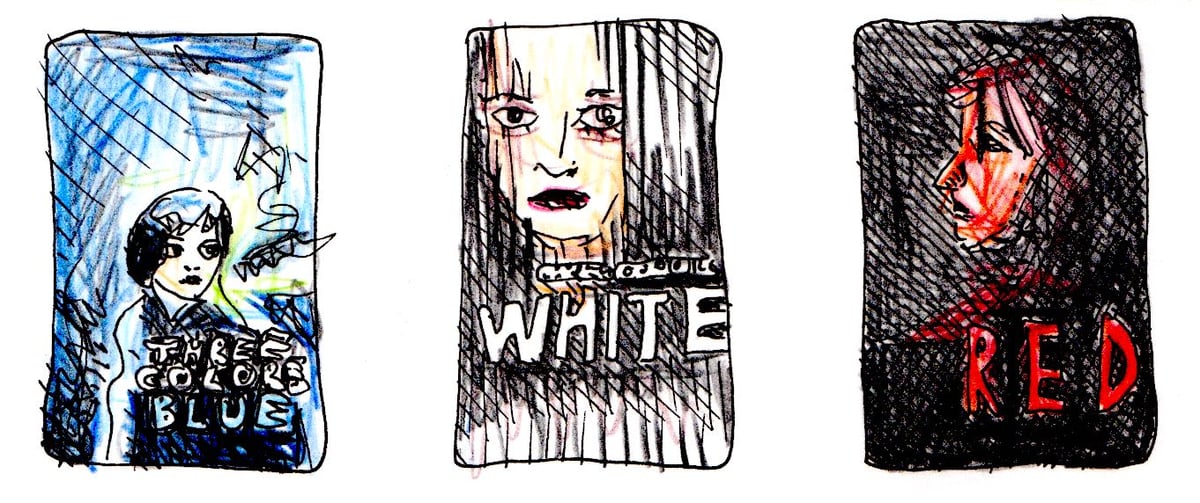
Please tell me something silly that you love.
Cassettes? They’re kind of silly. But their analog imperfections amuse me and I love having them strewed caseless around my spaces.
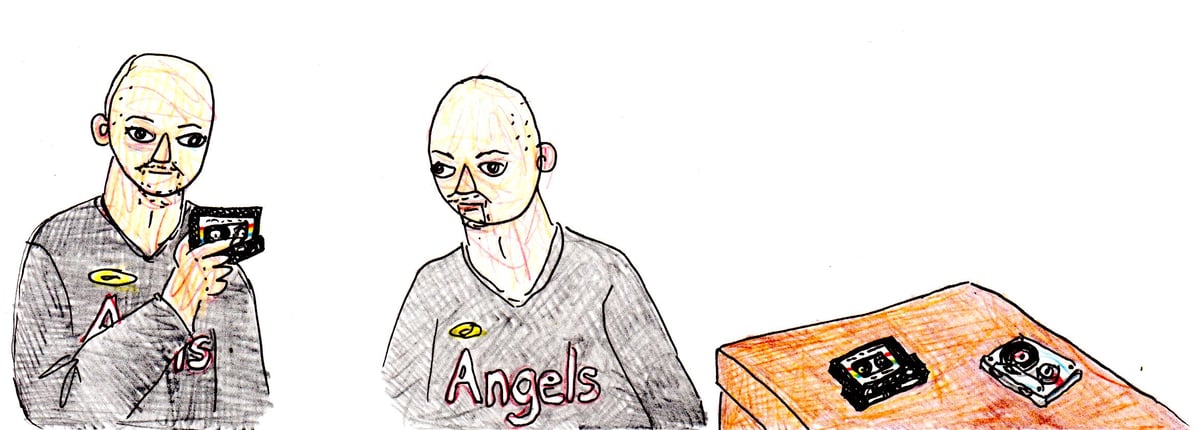
Have you ever written a poem to or for God?
I did write a short one that I have memorized from long ago. “God is the / man in the Coke / machine who won’t / accept my wrinkled dollar.” The line breaks may have been different. This might have been written around the time that I had my sacrament of confession rejected by a priest because I refused to promise God I would never, like, masturbate ever again. I’m glad I did not promise that, and I ended up going to confession again a few months ago, after a 33-year break.
Previously: An Interview With Jason Kottke
A list of sports teams named after technology, including the Detroit Pistons, the Houston Rockets, the San Antonio Spurs, and the Brooklyn Nets. Additions welcome.
The NY Times’ coverage of trans people and issues has been awful. Two-thirds of stories about anti-trans legislation failed to quote trans people and “another 18% of such articles included anti-trans misinformation with no fact-checking”.
A Graph of Solar Eclipse Coolness: Totality or GTFO
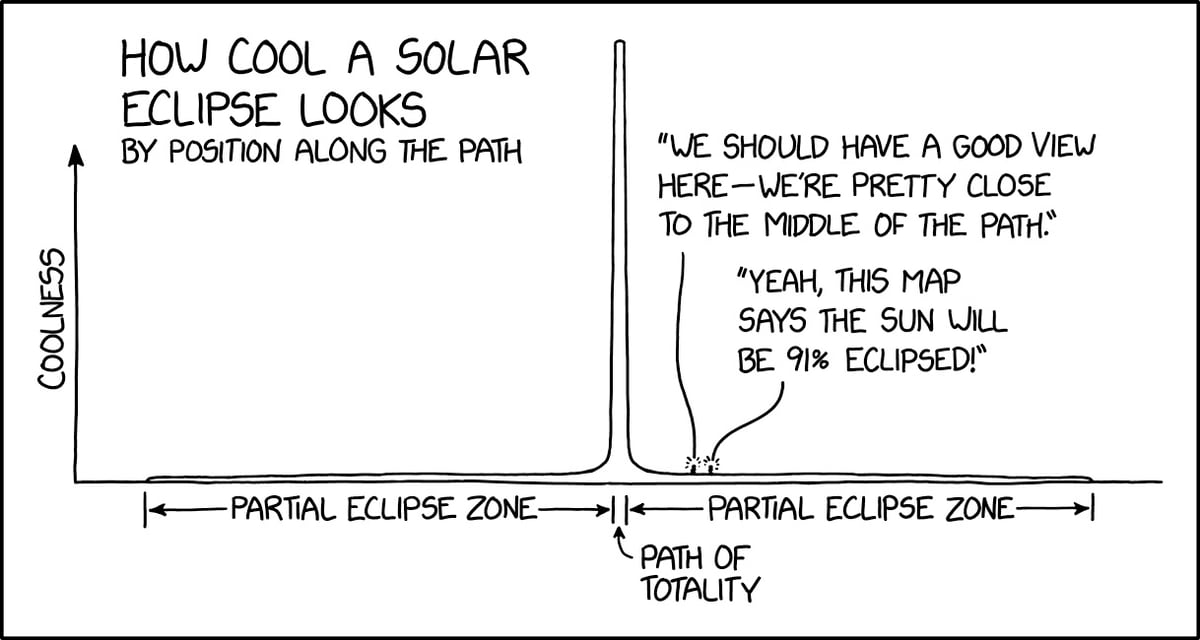
As usual, XKCD is spot on with this graph of solar eclipse coolness as a function of distance from the path of totality. The image’s alt text reads:
A partial eclipse is like a cool sunset. A total eclipse is like someone broke the sky.
See also the 2017 version. After witnessing the 2017 total solar eclipse, I wrote:
We saw the Baily’s beads and the diamond ring effect. And then…sorry, words are insufficient here. When the Moon finally slipped completely in front of the Sun and the sky went dark, I don’t even know how to describe it. The world stopped and time with it. During totality, Mouser took the photo at the top of the page. I’d seen photos like that before but had assumed that the beautifully wispy corona had been enhanced with filters in Photoshop. But no…that is actually what it looks like in the sky when viewing it with the naked eye (albeit smaller). Hands down, it was the most incredible natural event I’ve ever seen.
I’m not sure exactly what I expected, but this wasn’t it. I’d seen photos of coronas around suns, but this wasn’t that. And I’d expected that those photos, like many astronomical pictures, are long exposure, other wavelengths, and otherwise capturing things the naked eye can’t see. I thought there might be a glow of light in a circle, or nothing, or, I don’t know. What I did not expect was an unholy horror sucking the life and light and warmth out of the universe with long reaching arms, that what I’d seen in pictures was not an exaggeration but a failure to capture the extent of this thing that human eyes, and not cameras, are uniquely suited to absorb the horror of.
I had seen a partial eclipse in 1970. A partial eclipse is very interesting. It bears almost no relation to a total eclipse. Seeing a partial eclipse bears the same relation to seeing a total eclipse as kissing a man does to marrying him, or as flying in an airplane does to falling out of an airplane. Although the one experience precedes the other, it in no way prepares you for it.
I am so looking forward to Monday and crossing my fingers for clear skies — the path of totality goes right over my house.
The final interview of Brigitte Höss, the daughter of Rudolf Höss, the commandant of Auschwitz (and subject of The Zone of Interest). And here’s a previous interview from 2013.
🎵 There’s only wi-fi when it rains… 🎵 “The rain held up for about an hour, and so did the internet connection.” Love a good tech debugging story — they always remind me of The Case of the 500-Mile Email.
The Evolution of Mozart’s Music (From 5 to 35 Years Old)
Wolfgang Amadeus Mozart’s first surviving musical composition was created at age five and in this video visualization, you can hear and see how his music evolved from that early piece to those created in his 20s and 30s. Not knowing a whole lot about music or of Mozart in particular, I was shocked at how incredible his compositions were at ages five, six, and seven. Sheesh.
See also Hear the Pieces Mozart Composed When He Was Only Five Years Old. (via open culture)
Swirling Magnetic Fields Visible in New Black Hole Images

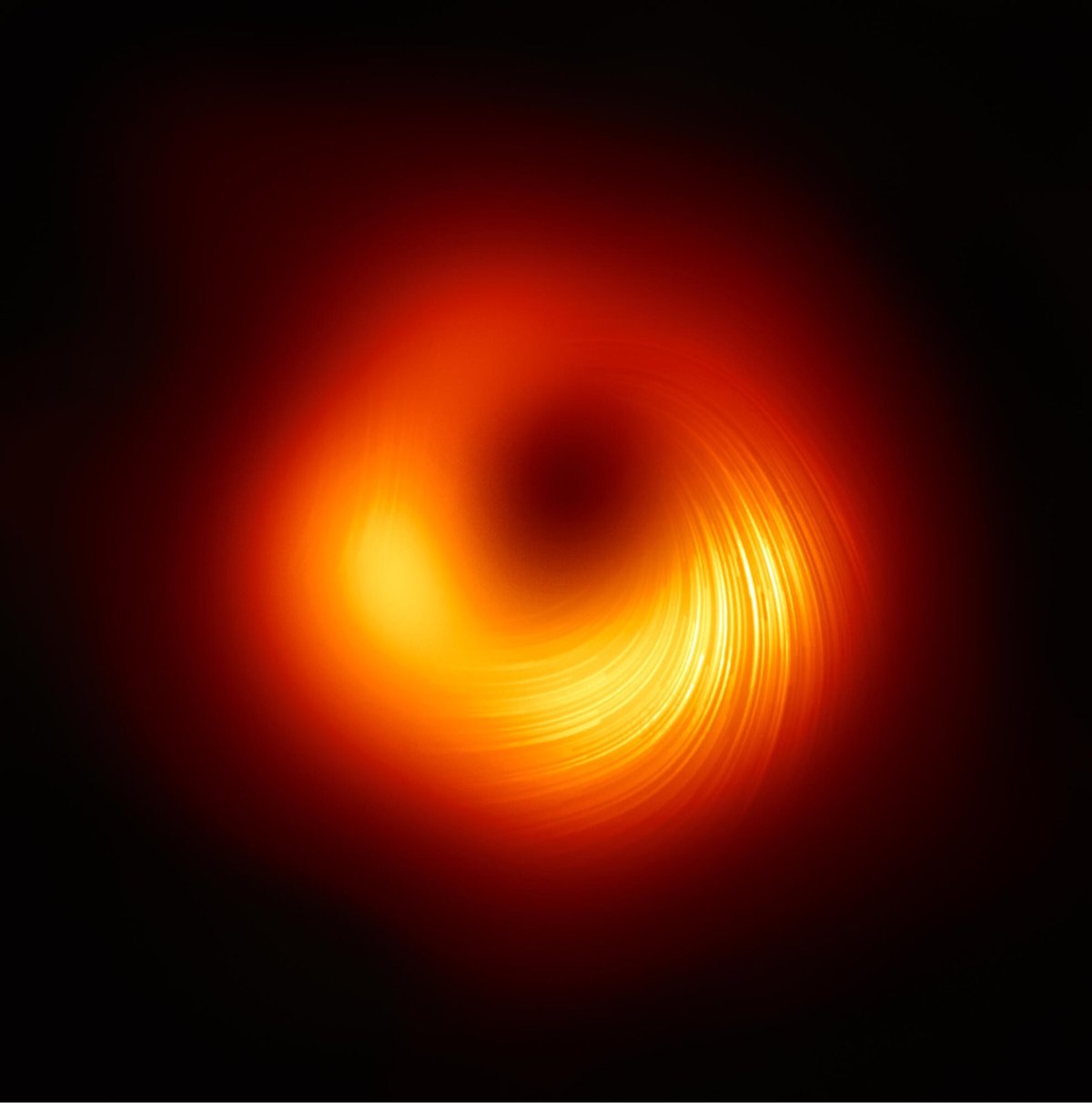
It’s been about five years since scientists captured the first blurry image of a black hole. Using what they learned from that experience, they’ve teased out some more detailed images of the black holes at the centers of the Milky Way galaxy (top) and the M87 galaxy (bottom). The process of collecting the data for these images is interesting:
The only way to “see” a black hole is to image the shadow created by light as it bends in response to the object’s powerful gravitational field. As Ars Science Editor John Timmer reported in 2019, the EHT isn’t a telescope in the traditional sense. Instead, it’s a collection of telescopes scattered around the globe. The EHT is created by interferometry, which uses light in the microwave regime of the electromagnetic spectrum captured at different locations. These recorded images are combined and processed to build an image with a resolution similar to that of a telescope the size of the most distant locations. Interferometry has been used at facilities like ALMA (the Atacama Large Millimeter/submillimeter Array) in northern Chile, where telescopes can be spread across 16 km of desert.
In theory, there’s no upper limit on the size of the array, but to determine which photons originated simultaneously at the source, you need very precise location and timing information on each of the sites. And you still have to gather sufficient photons to see anything at all. So atomic clocks were installed at many of the locations, and exact GPS measurements were built up over time. For the EHT, the large collecting area of ALMA-combined with choosing a wavelength in which supermassive black holes are very bright-ensured sufficient photons.
The images of the two black holes look similar, which was somewhat unexpected:
While this idea may initially sound somewhat mundane, it is anything but. The result is surprising because Sgr A*’s mass is about 4.3 million times that of the Sun, while M87*’s is about 6.5 billion times that of the Sun. Despite the significant difference in mass between the two supermassive black holes, the fact that their magnetic fields behave similarly and are both well-organized is an incredible discovery.
An ode to women who walk through cities in films. “She will be ordinary, immersed in the practical aspects of her own life and my heart will skip a beat at the sight of her, in possession of her own life, in the city, alone.”
Crash Course Lecture: The Deadliest Infectious Disease of All Time
In this Crash Course video, author and “TB-hater” John Green takes a deep dive into tuberculosis.
This is the story of the deadliest infectious disease of all time. It’s been with us for 3 million years, since before humans were homo sapiens. We have evidence of it in the mummies of ancient Egypt, and it’s mentioned in the Hebrew Bible.
We’ve made extraordinary medical advances. Vaccines, antibiotics, and clean water have saved millions of lives. And yet despite that, in 2022, this disease killed more people than malaria, typhoid, cholera, homicide, and war…combined.
It has gone by many names. In ancient China, it was known as huaifu, meaning “destroyed palace.” In ancient Hebrew, “schachepheth,” meaning wasting away. The 19th-century term: “consumption,” for the way it seemed to consume the body. Today, we call it tuberculosis.
I actually love this idea: host a PowerPoint Night “where all your friends present on their jobs so you can finally understand what the heck everyone does all day”.
Substack is speedrunning the enshittification curve. “This latest intervention is indicative of their efforts to transition to a social media hub where they can sell ad space.” We can all see where this is going…now is a great time to get off.
Tyler Cowen Interviewing Marilynne Robinson
COWEN: What is your most unusual successful work habit?
ROBINSON: I think it’s becoming used to the fact that it takes me a long time to get to the place where I can work on something — that all this frustration [laughs] and depression that precedes my writing anything is part of the process of writing.
As someone who’s interested in finding God, I liked letting this religion-themed conversation wash over me. I also liked the idea that creative projects just have to take as long as they take and be as hard as they are. Robinson’s new book is about Genesis — she calls the Bible “the most complex document on the planet” — but in the interview they touch on several non-religious topics, too (like the above). Meanwhile I’m enjoying reading the negative reviews of her book on Amazon, which is probably bad (of me).
I missed that Benjamin Labatut (When We Cease to Understand the World, 👍👍) came out with a new novel last fall, The Maniac. The book centers on John von Neumann and the fuzzy, unstable, tech-centric world (atomics, AI) he and his colleagues created.
Dog Poo Golf. A Wii Sports Golf-style browser game (with the music!) where you fling dog poop bags into a garbage can.
Milky Way Embroidery
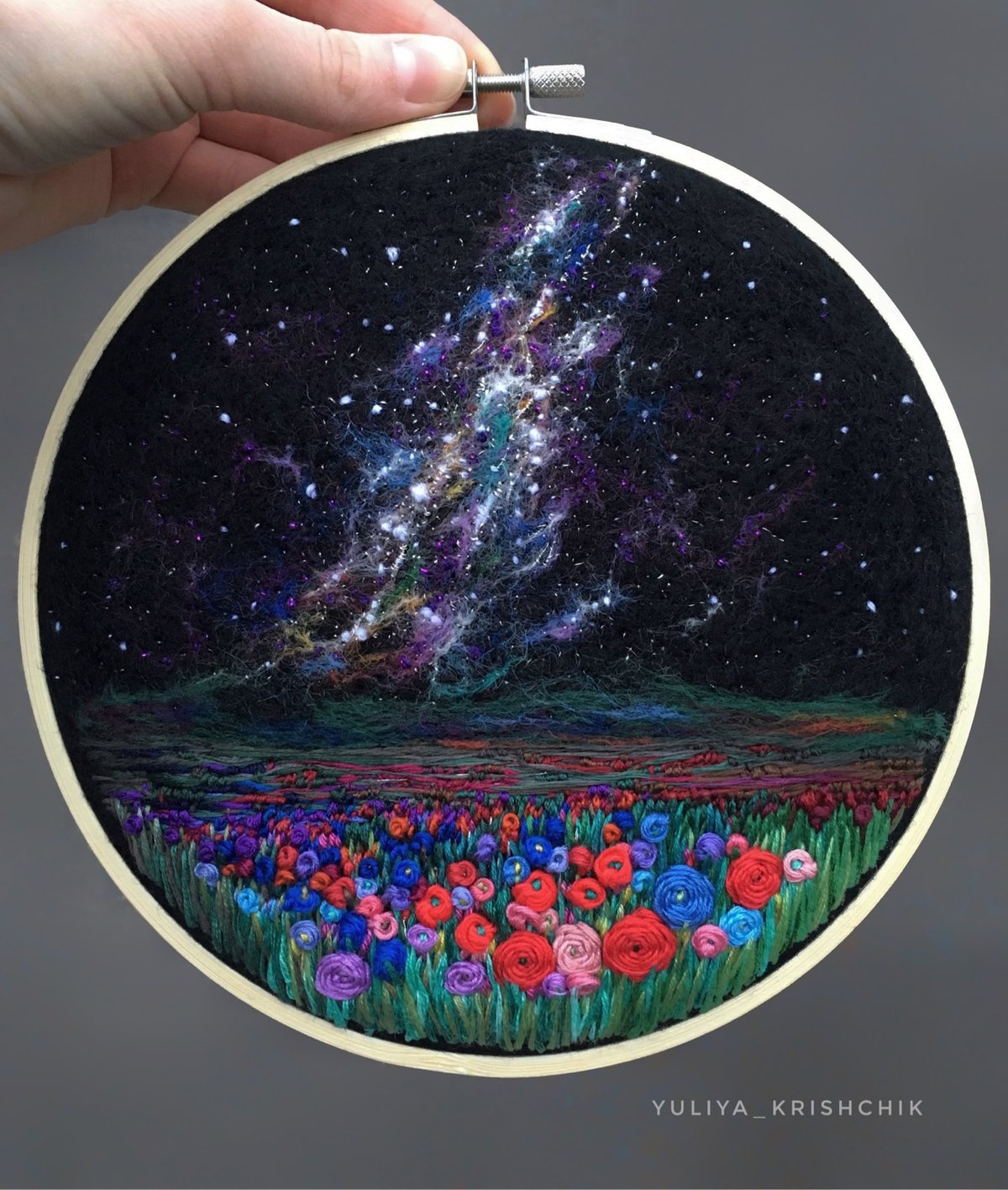
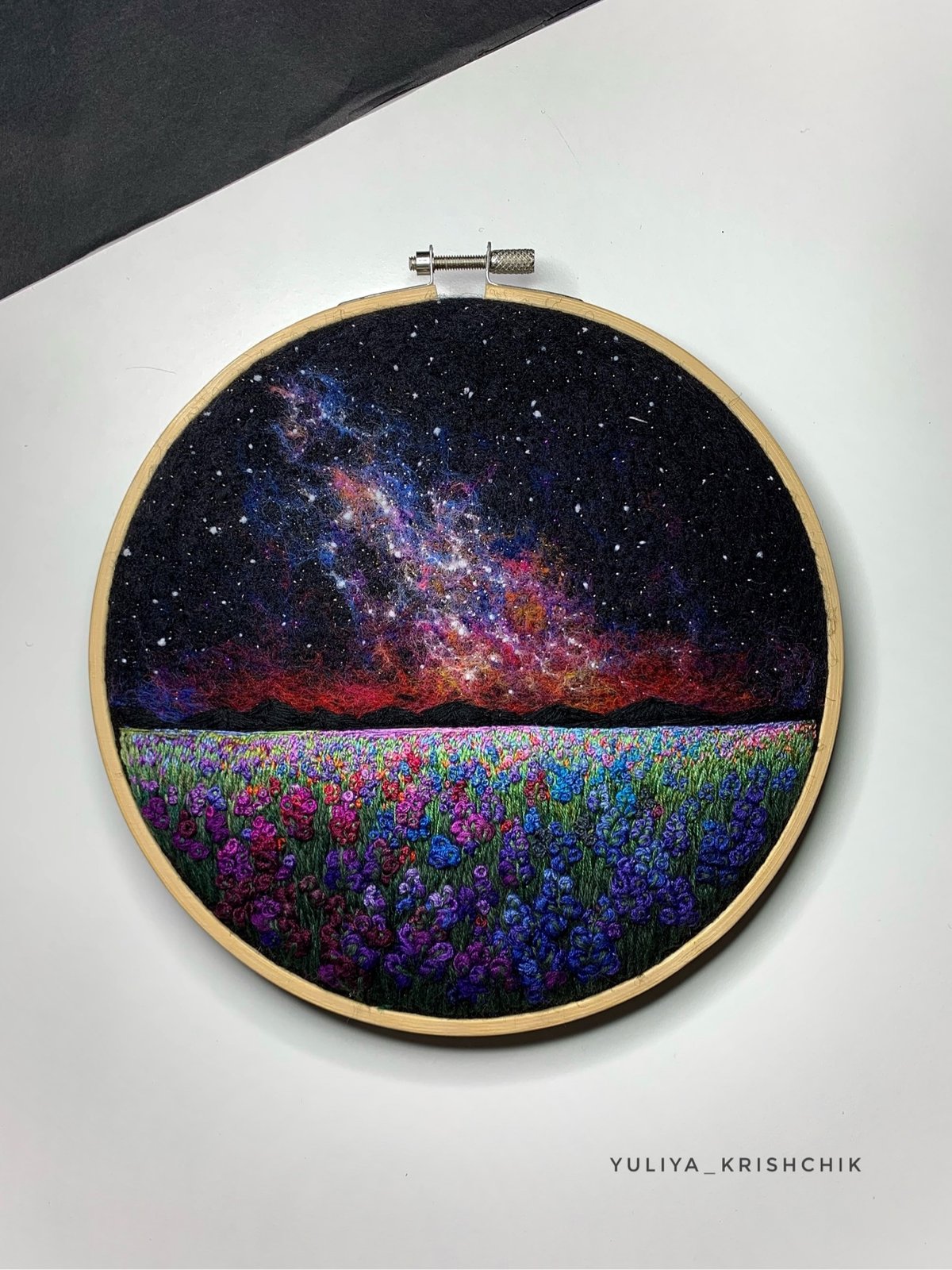
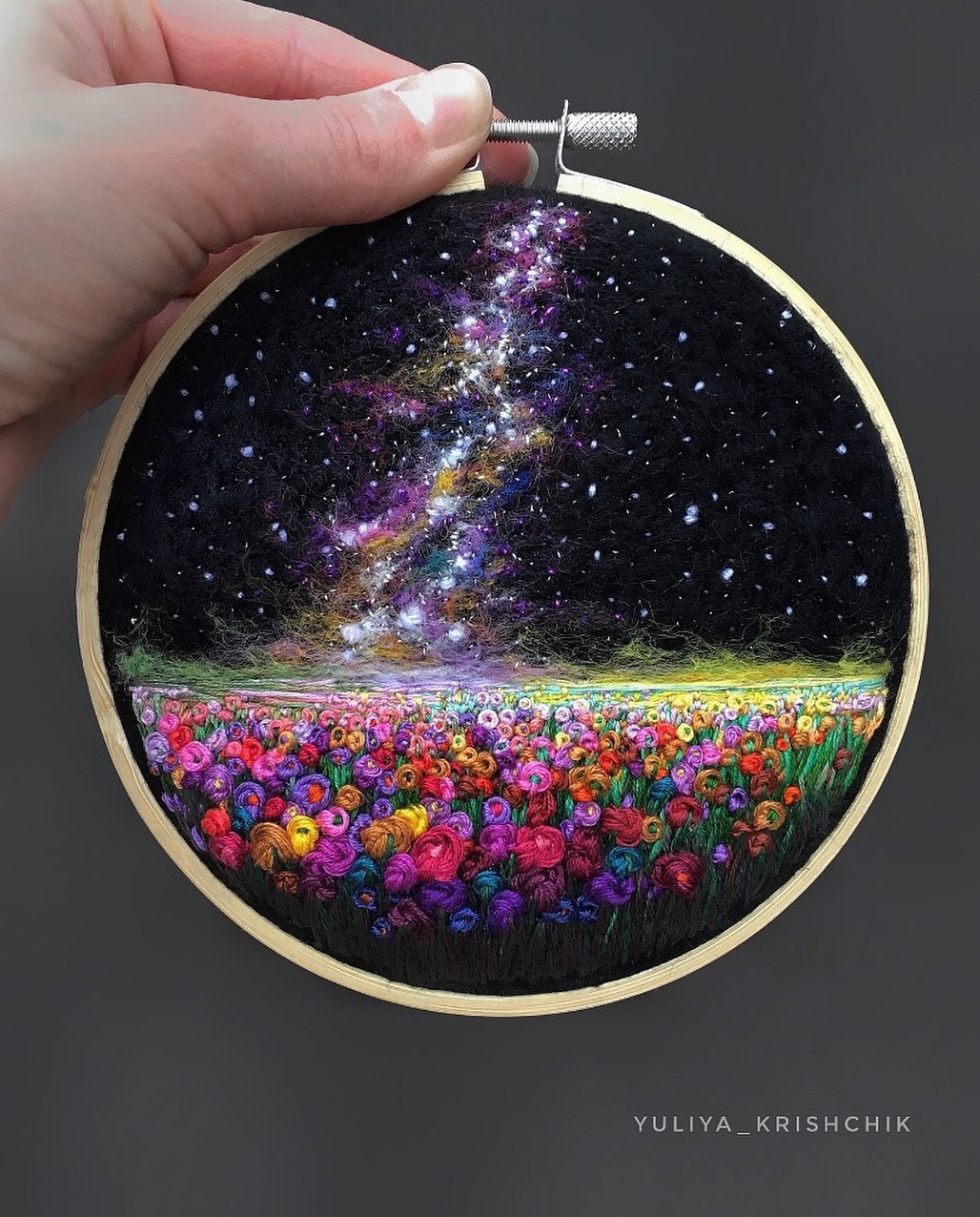
I love Yuliya Krishchik’s space-themed embroidery pieces, especially the ones featuring Milky Way-like star fields — she calls them “surreal space landscapes”. If you watch one of Krishchik’s videos, you can see that her pieces are just a bit 3D…a cool effect.
You can find more of her work on Instagram and her blog or buy original pieces in her store (they go quickly though).
I’ve been reading about this xz Utils exploit and it sounds absolutely nuts. “It came from a main maintainer and was introduced slowly over years. Everything is gpg signed.”
People Hate the Idea of Car-Free Cities — Until They Live in One. The car-free schemes end up being so popular and work so well that “once cities make the decision to reduce or remove cars, they rarely go back”.




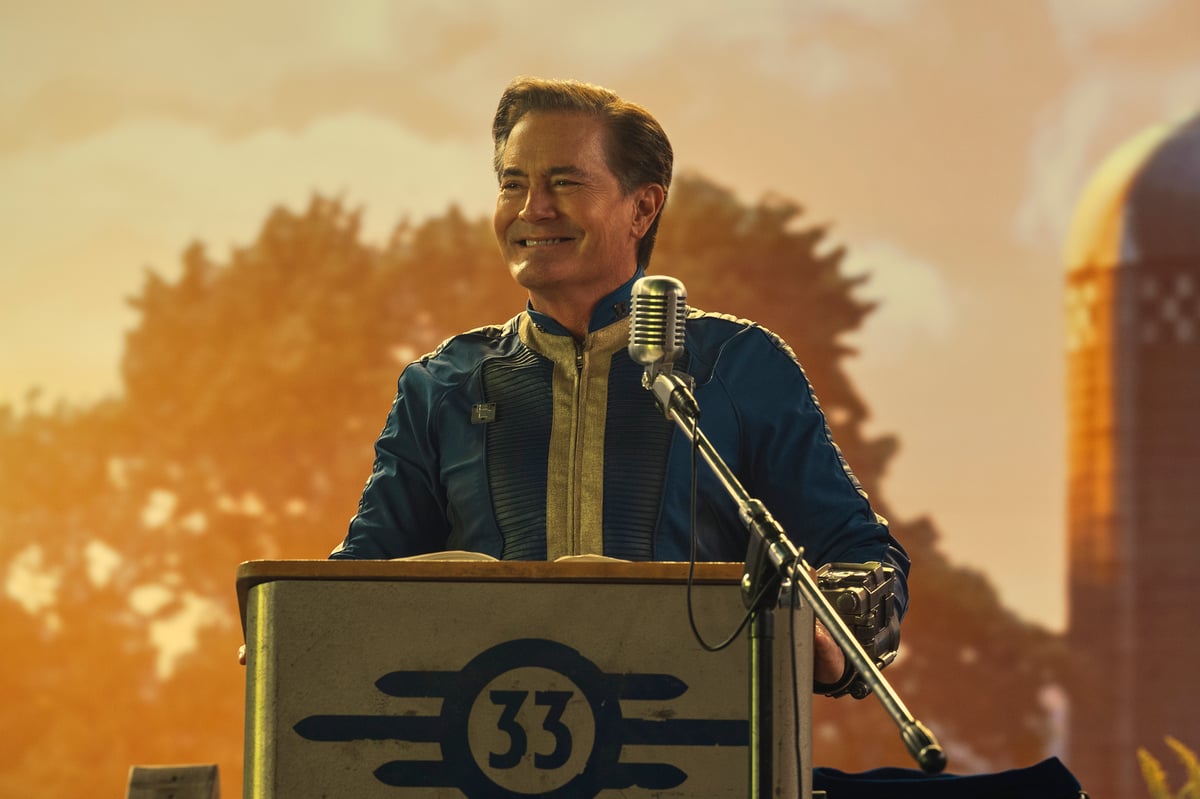



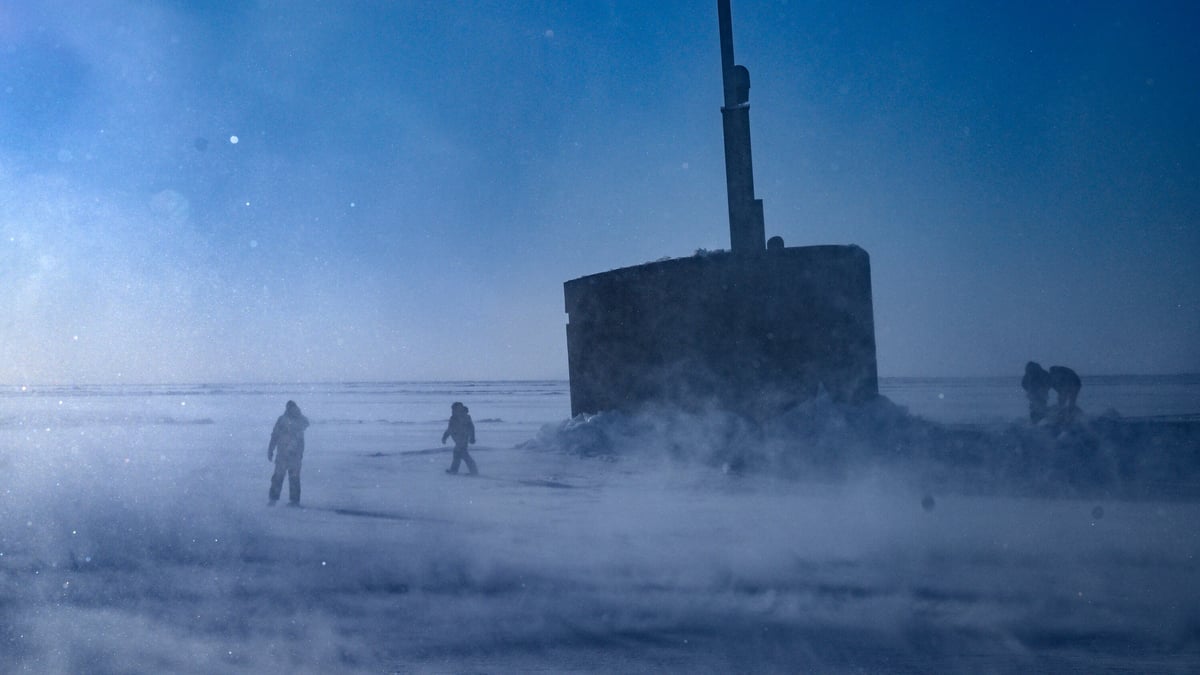
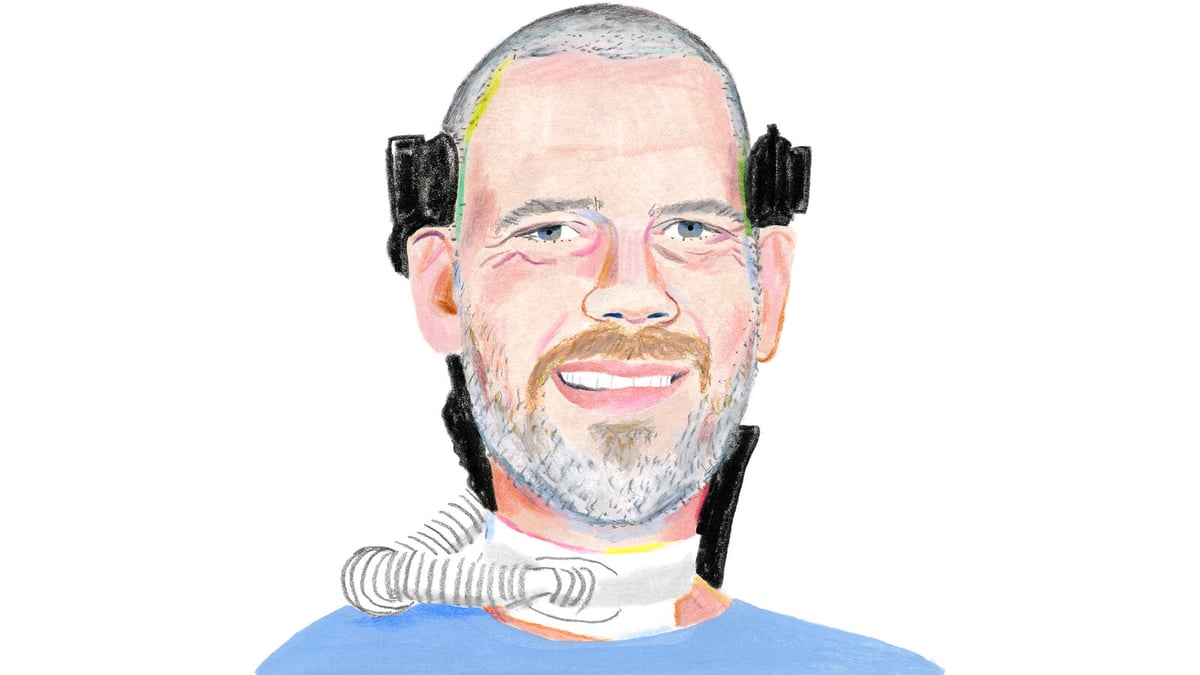







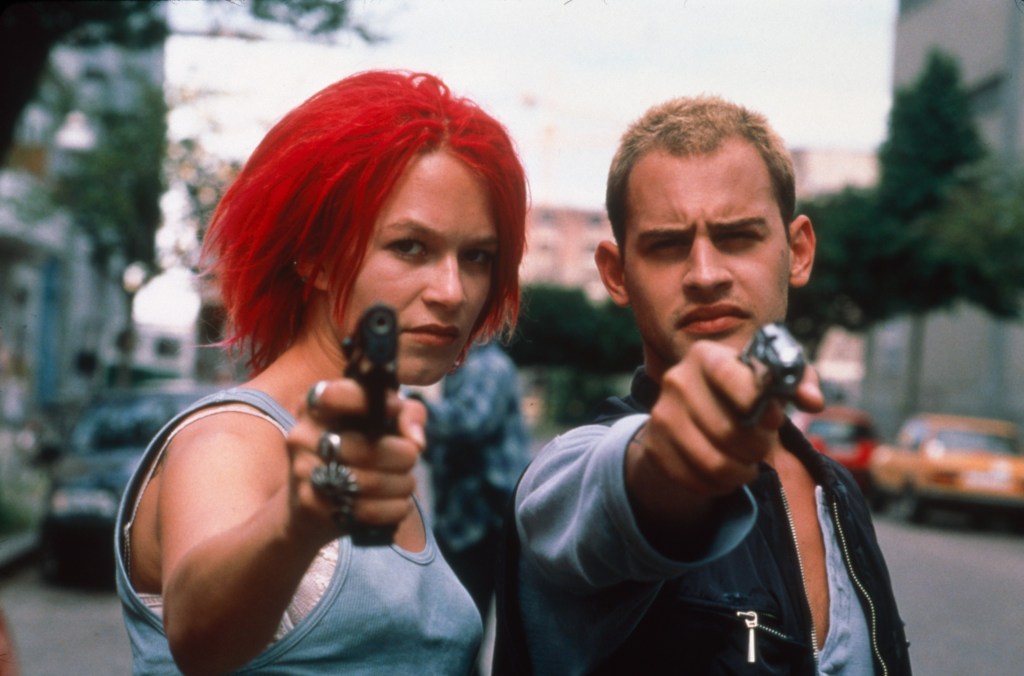
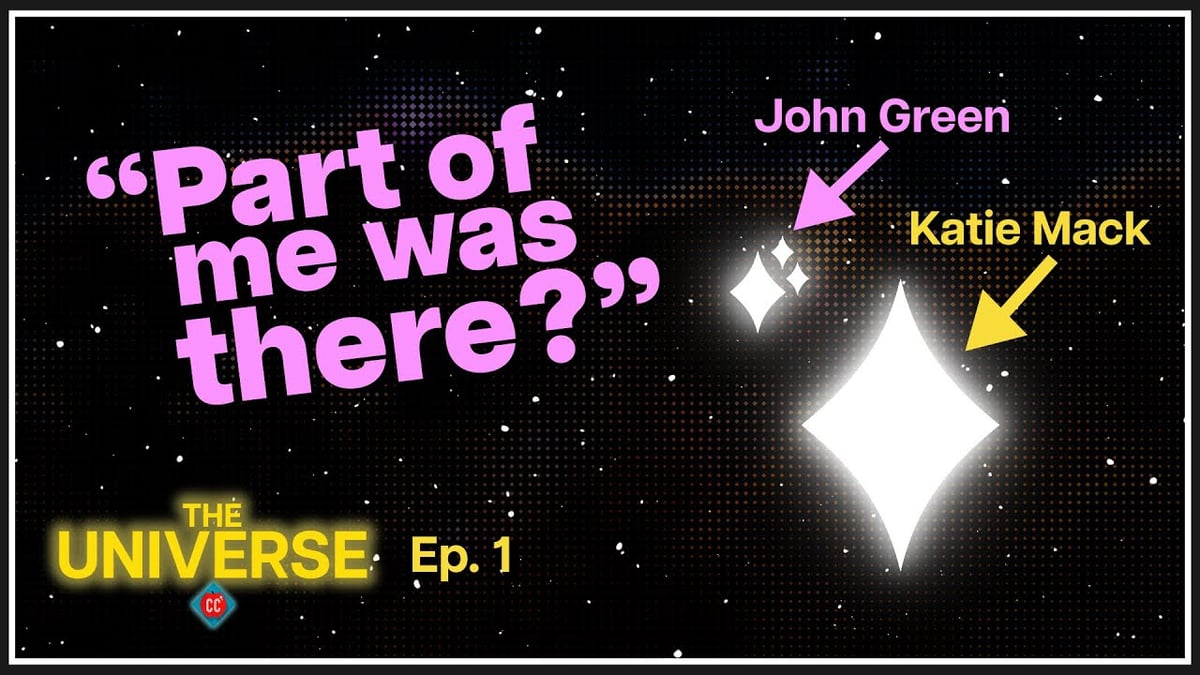

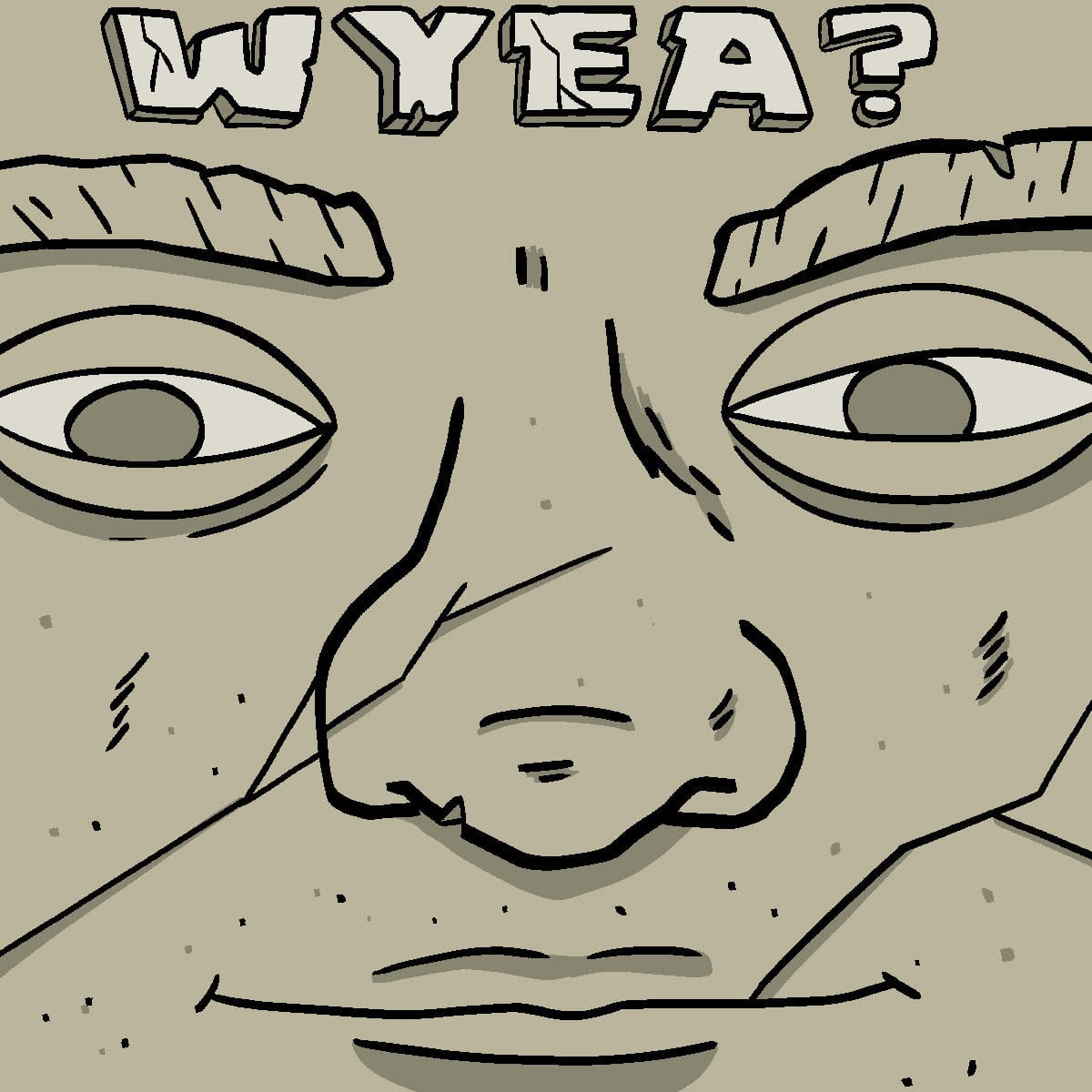

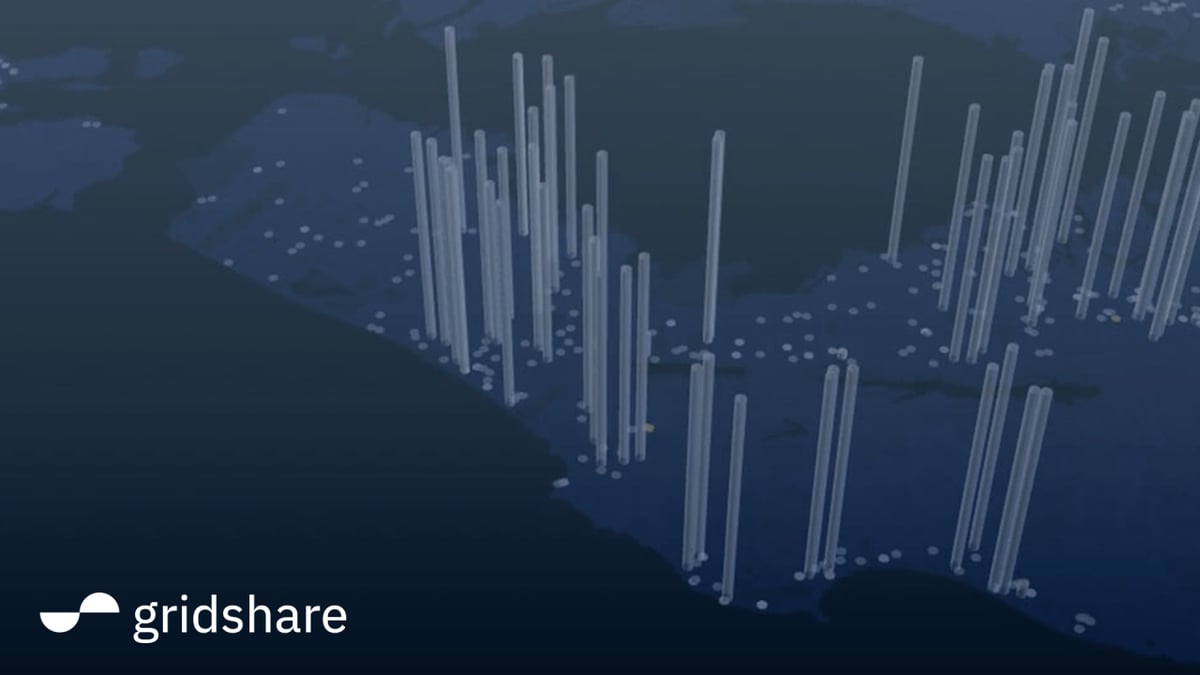







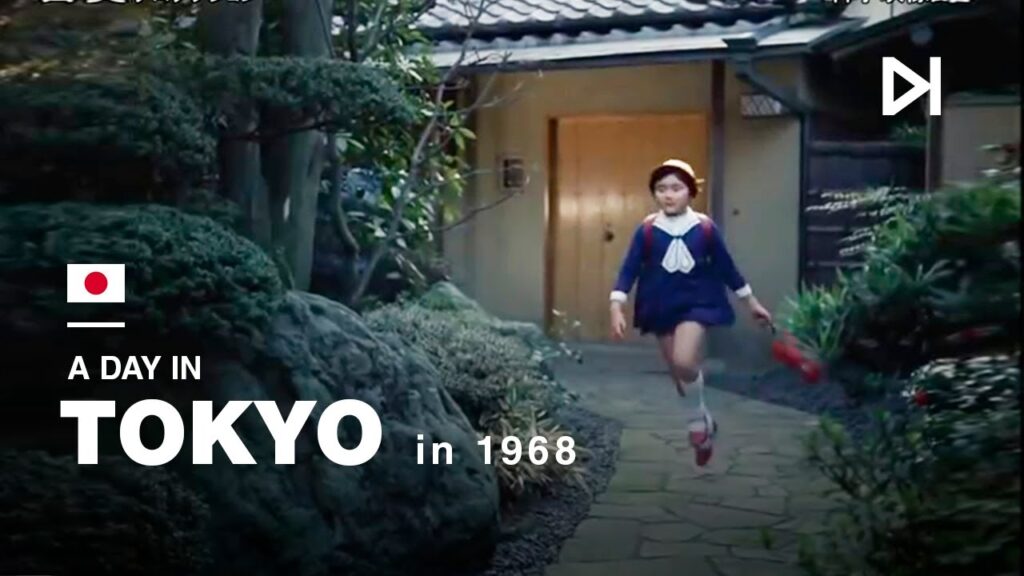
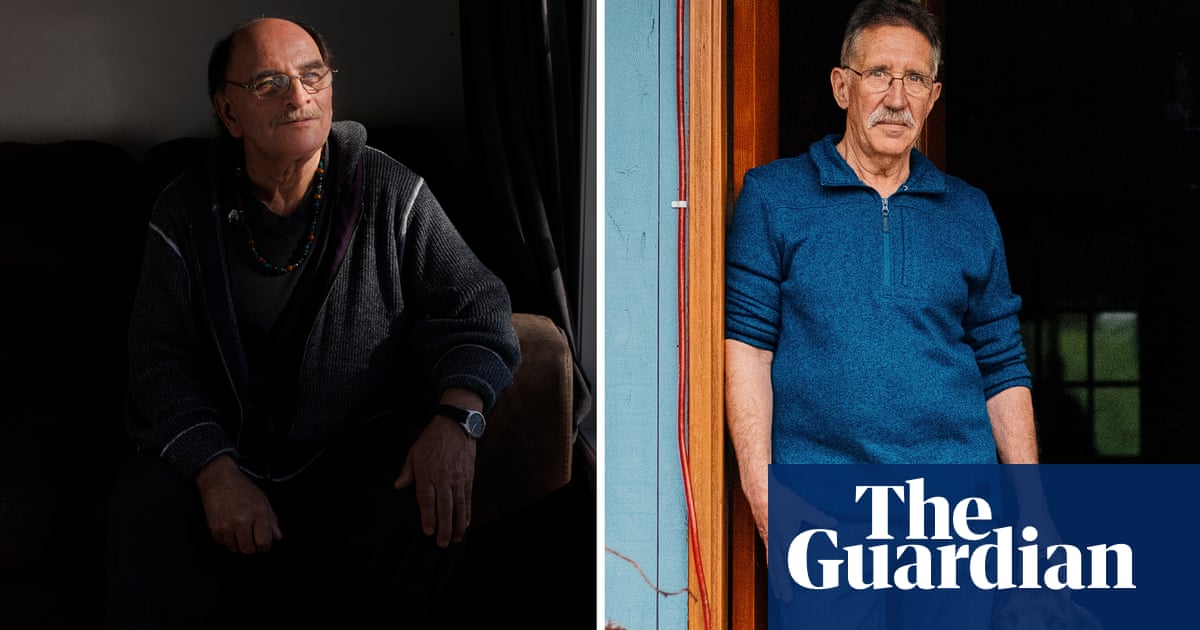







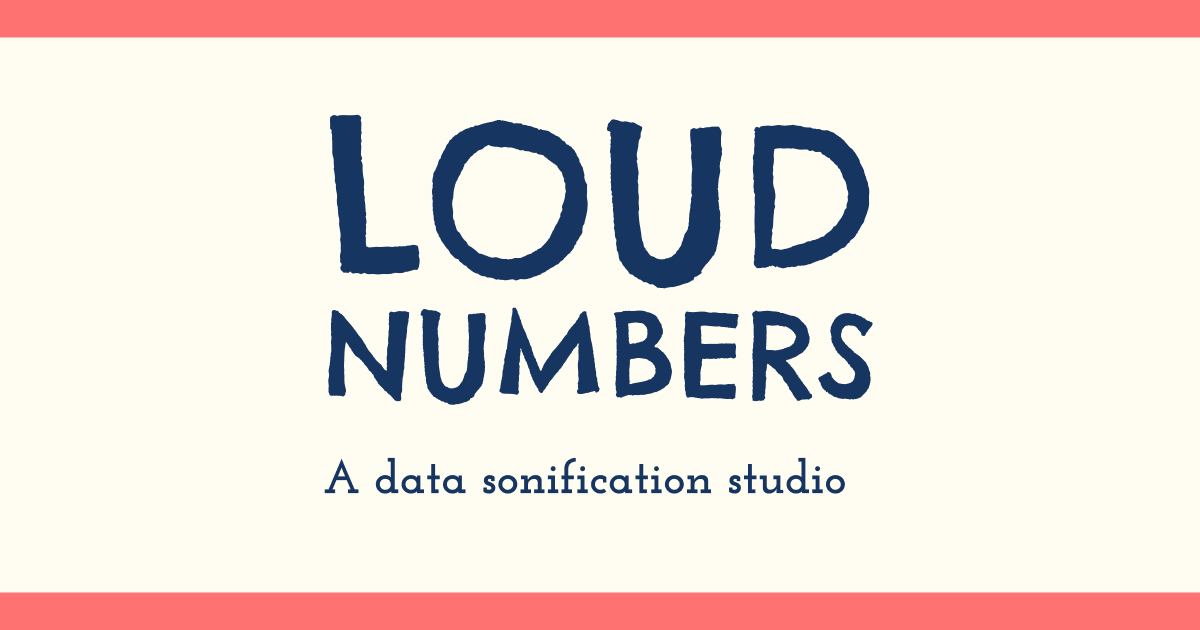
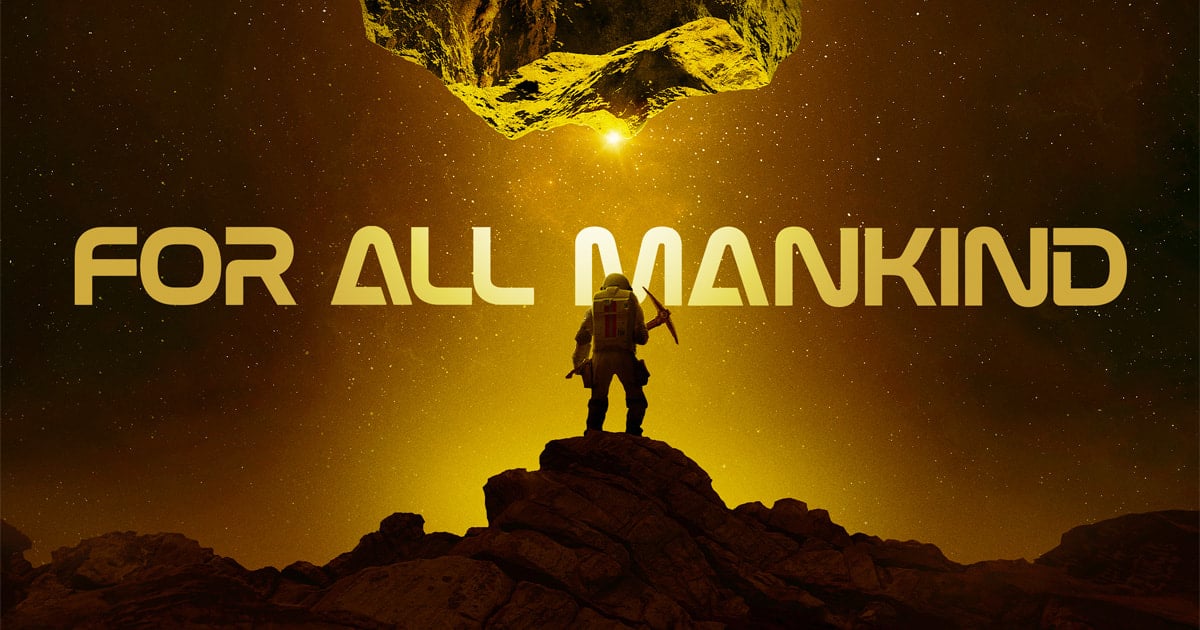



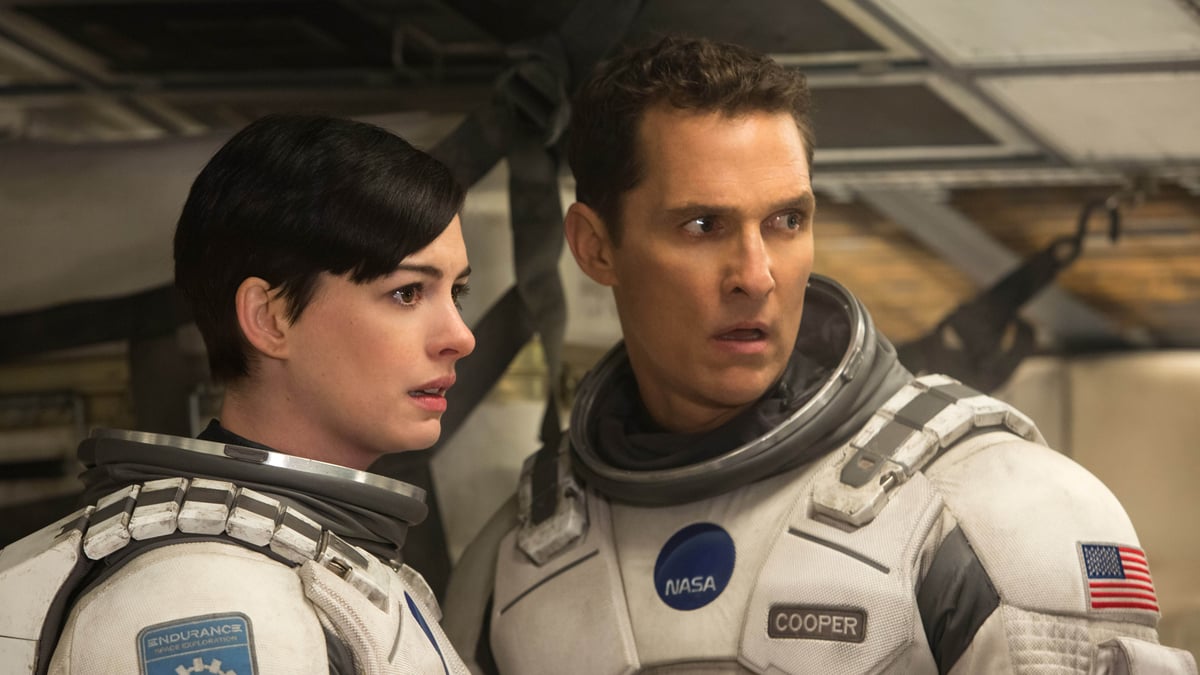
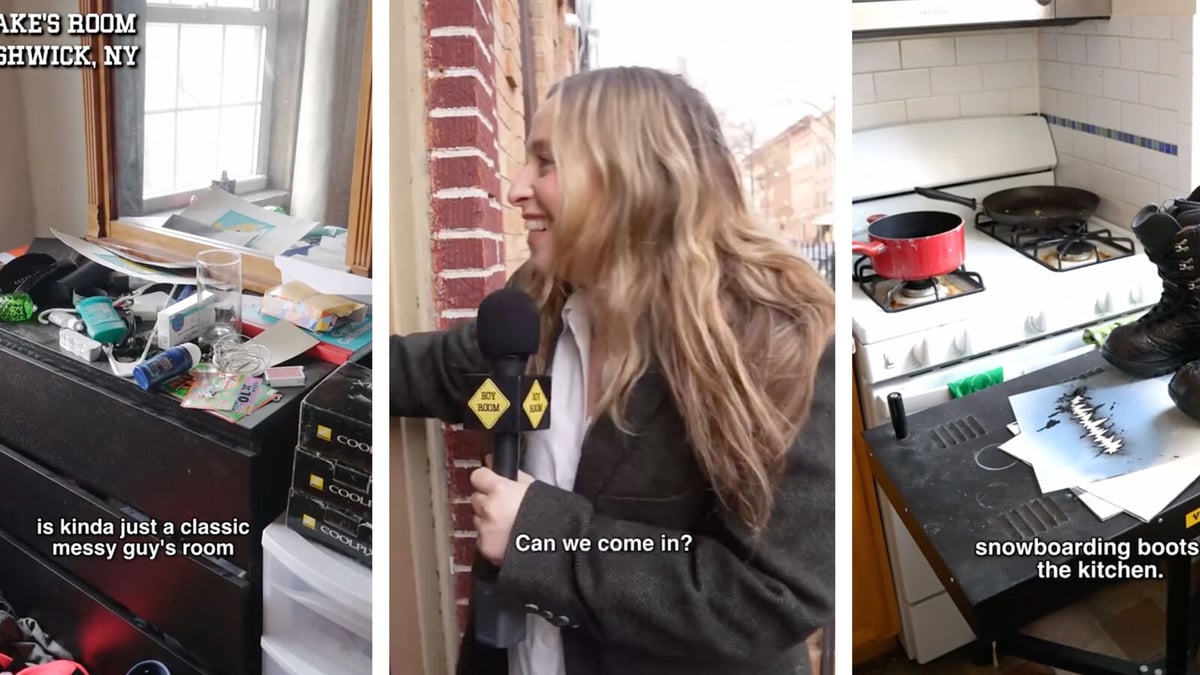
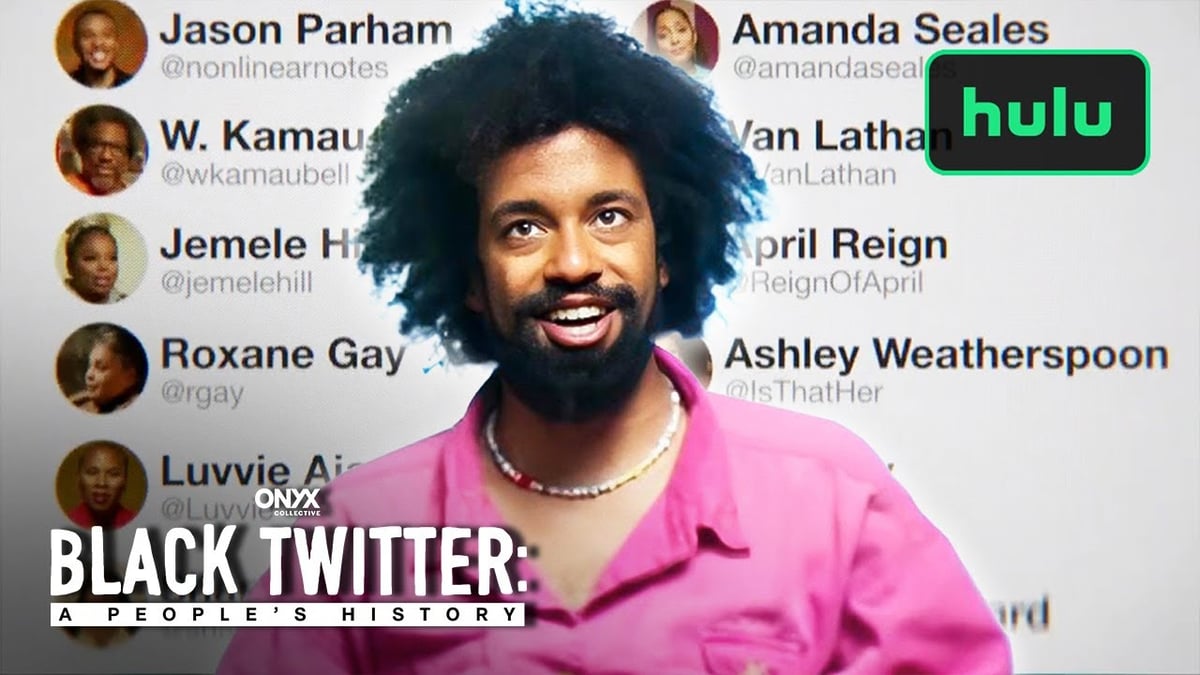
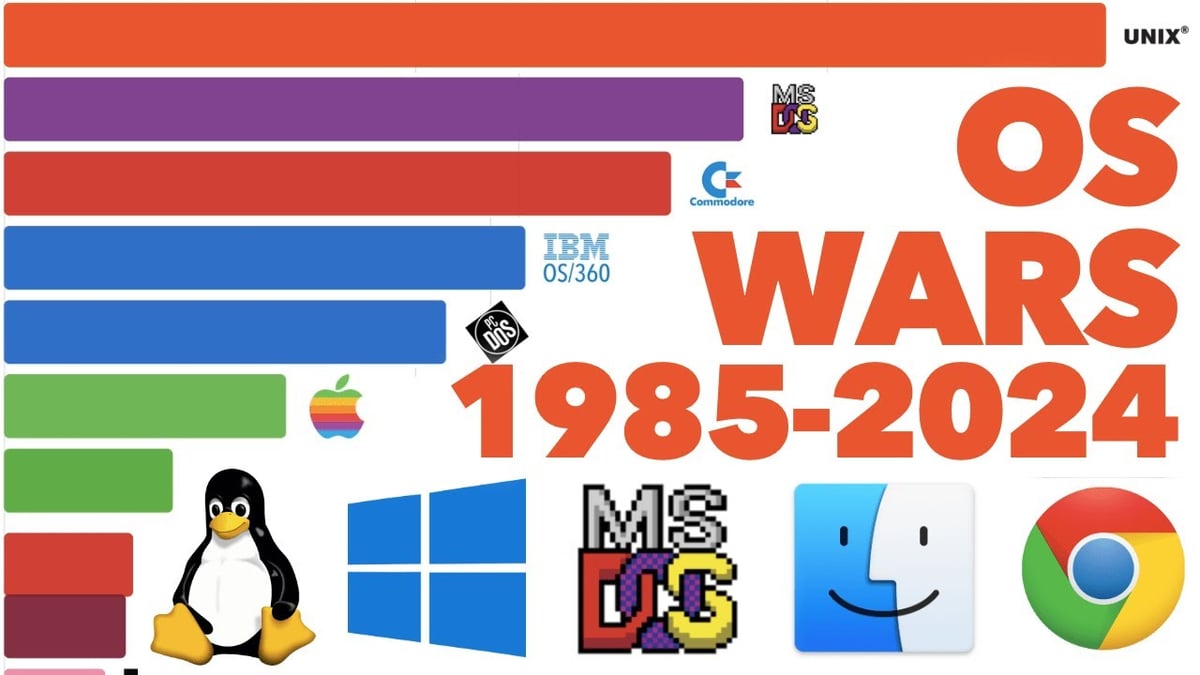





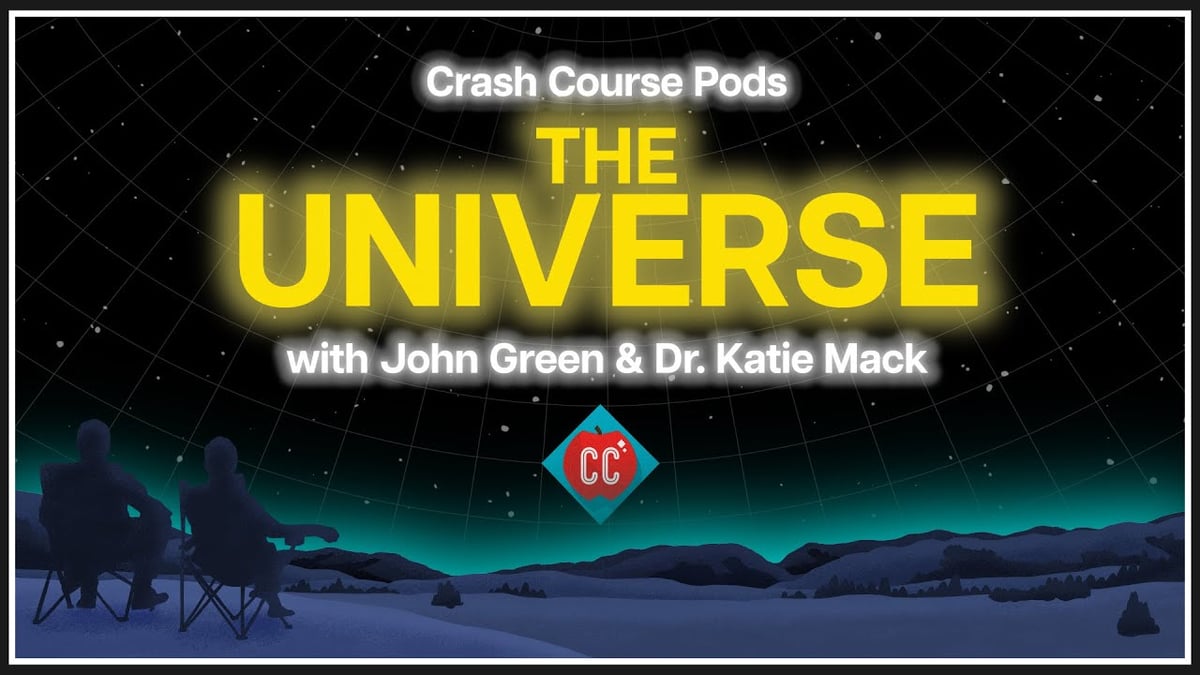
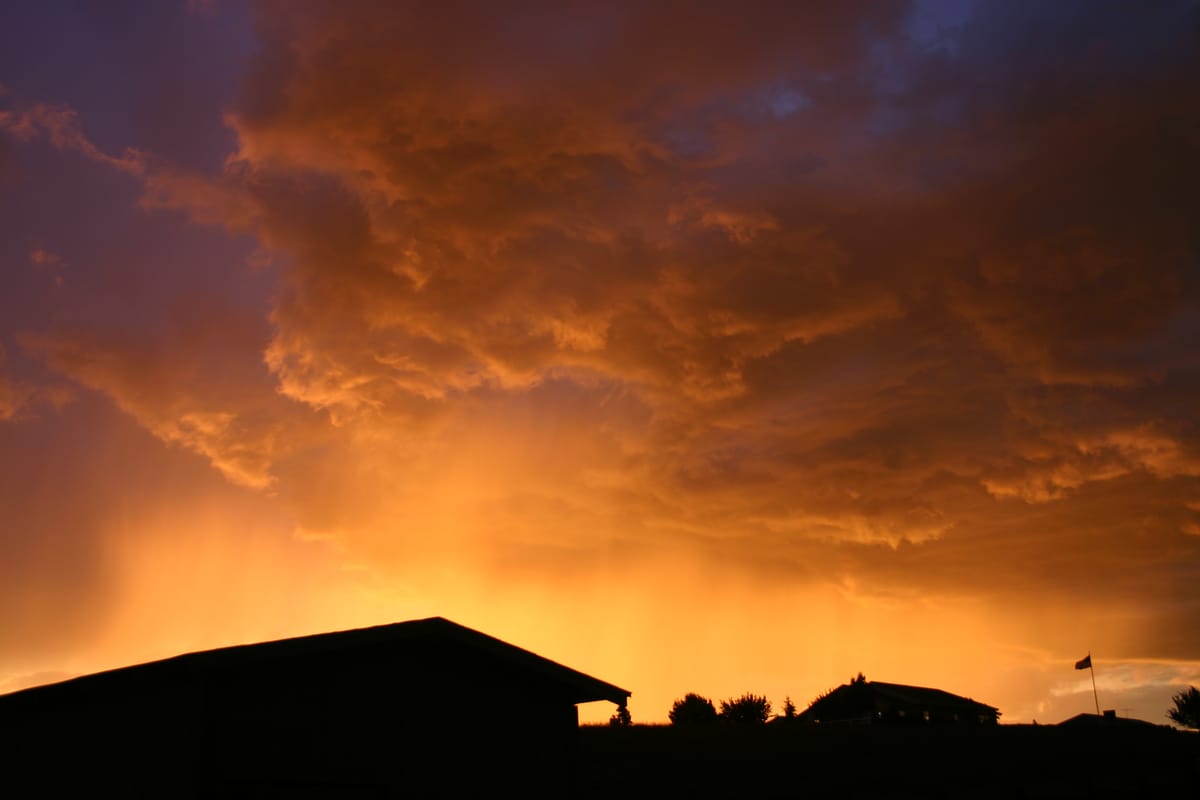
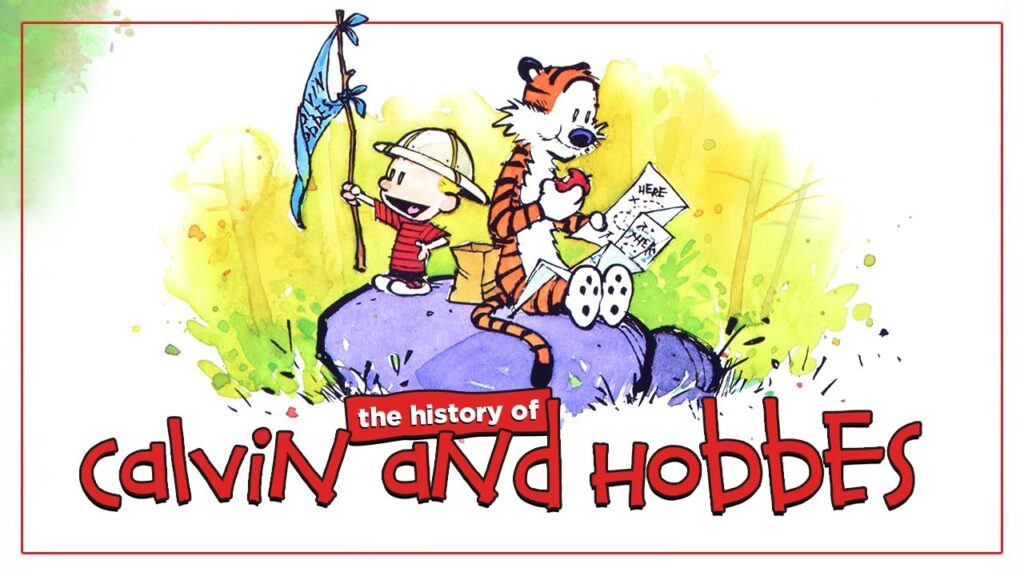

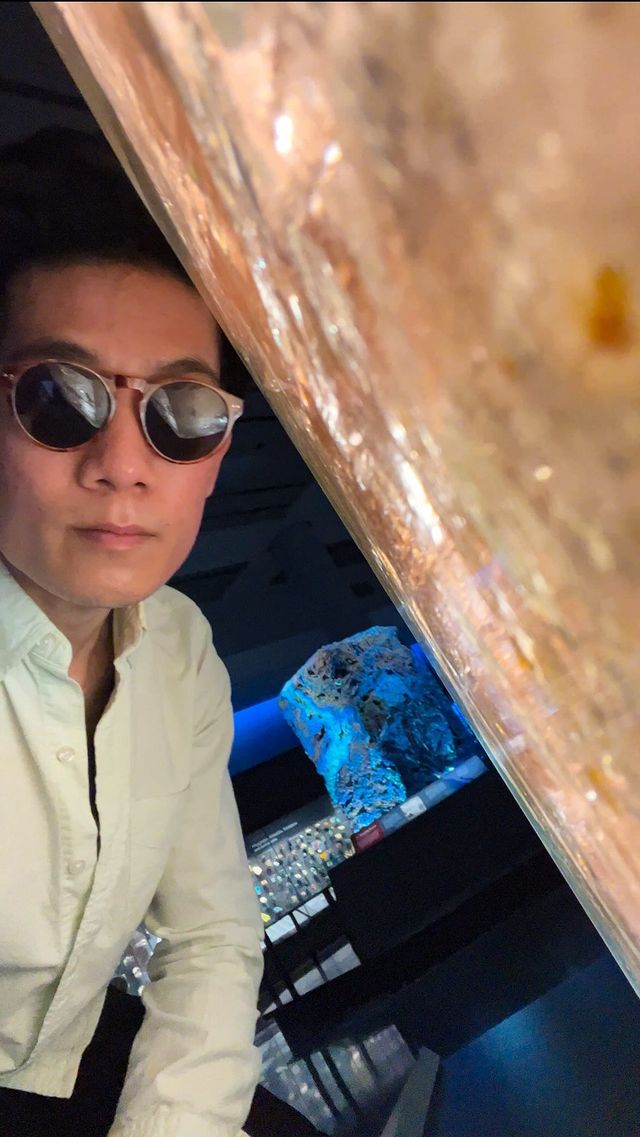




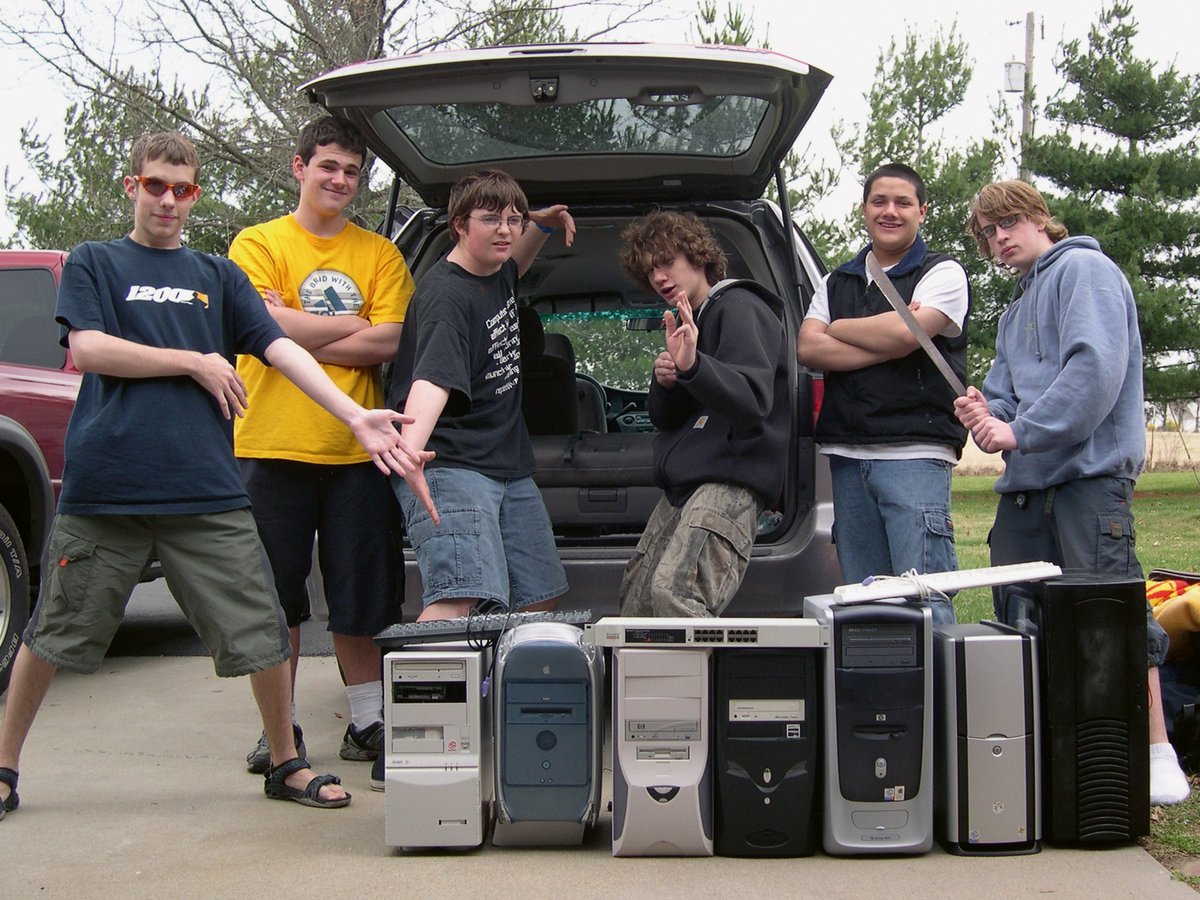

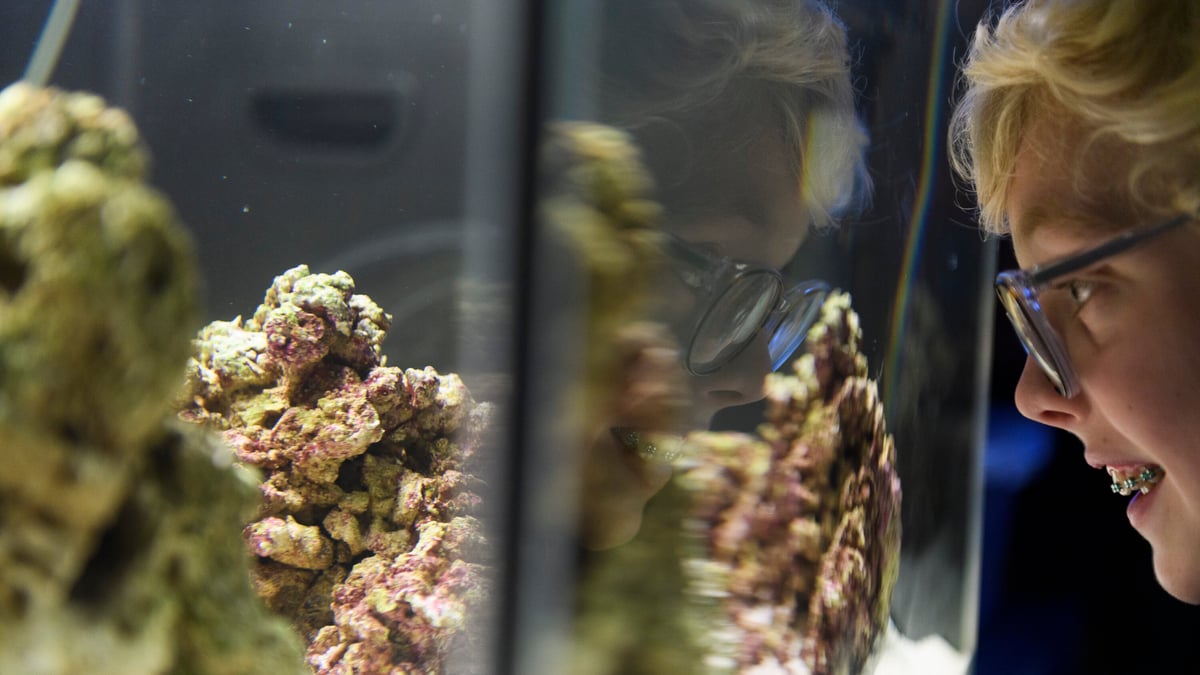
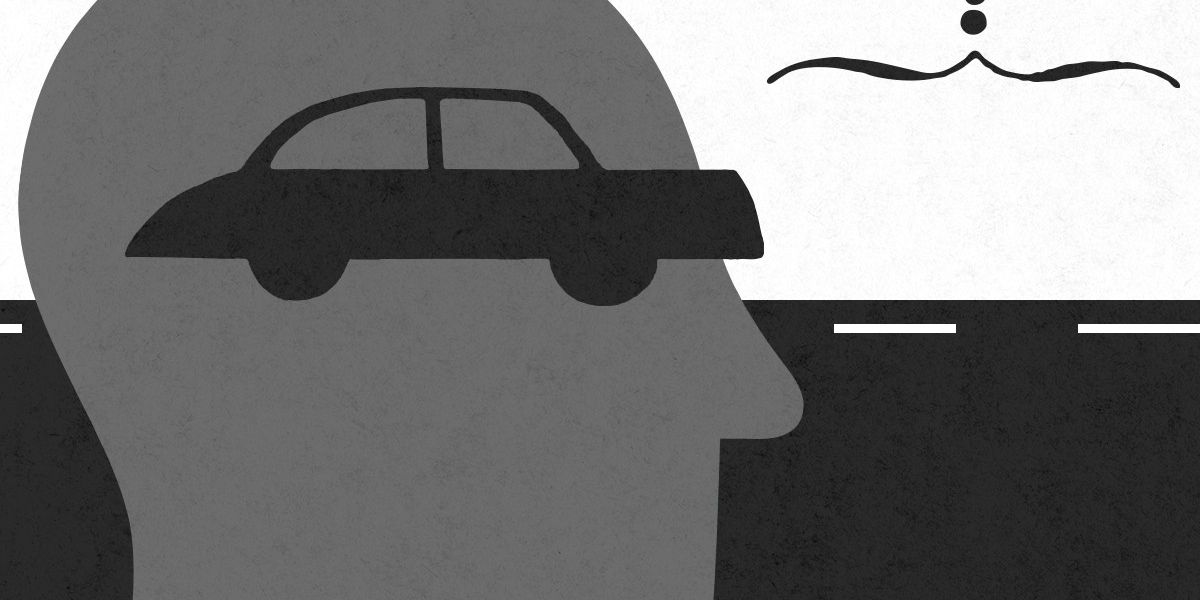
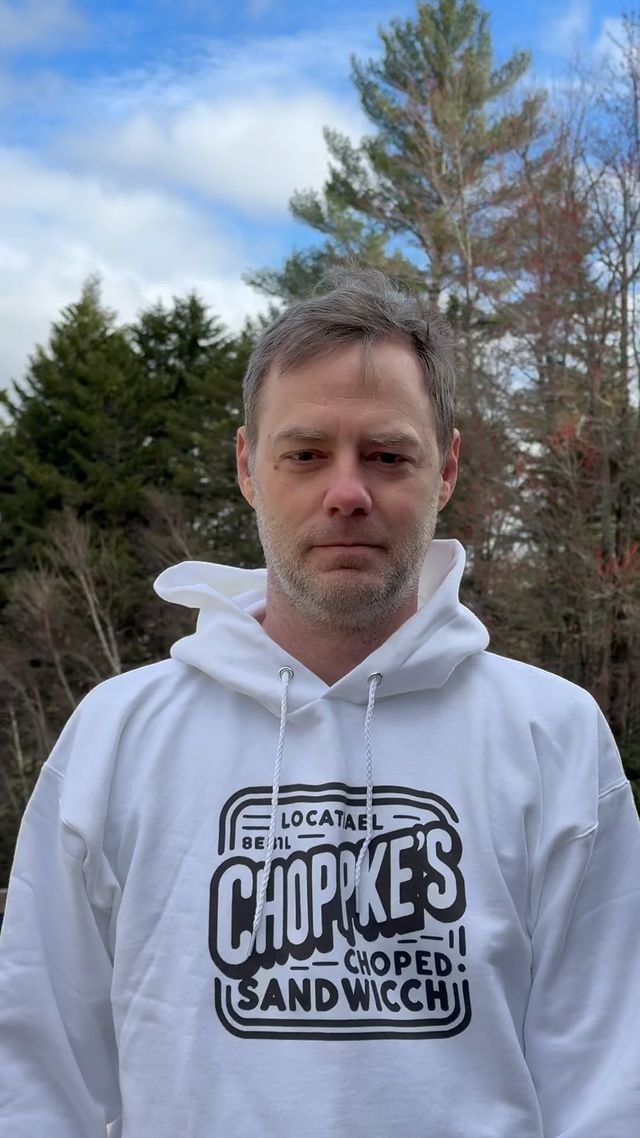




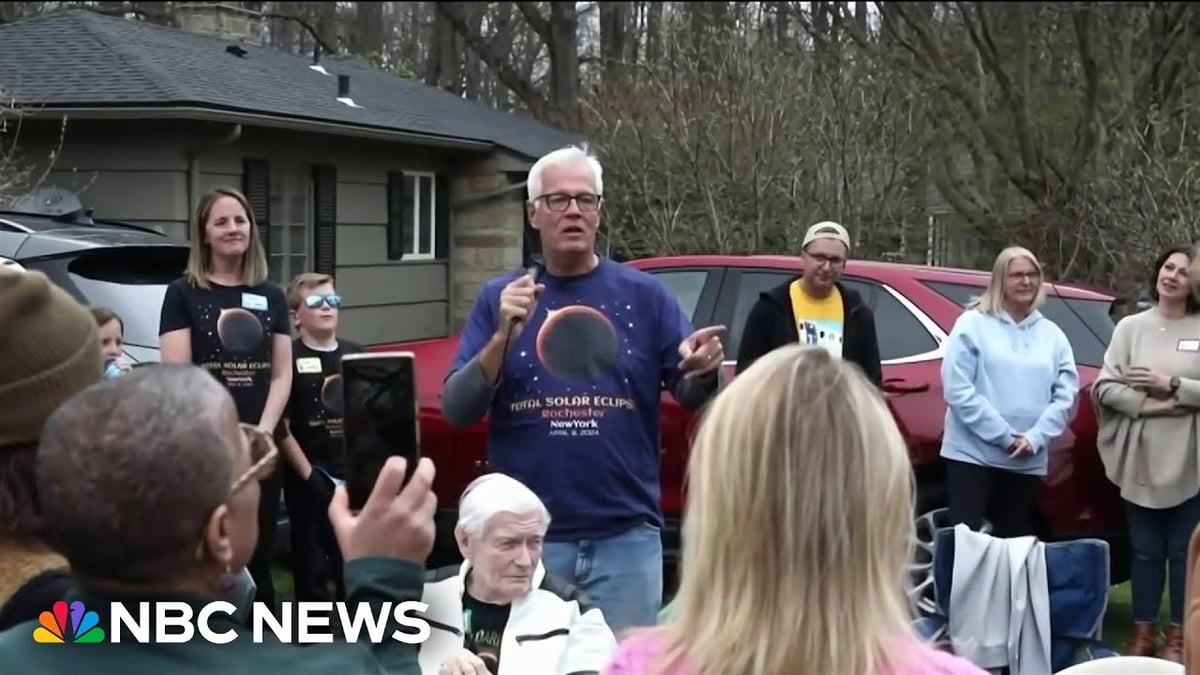

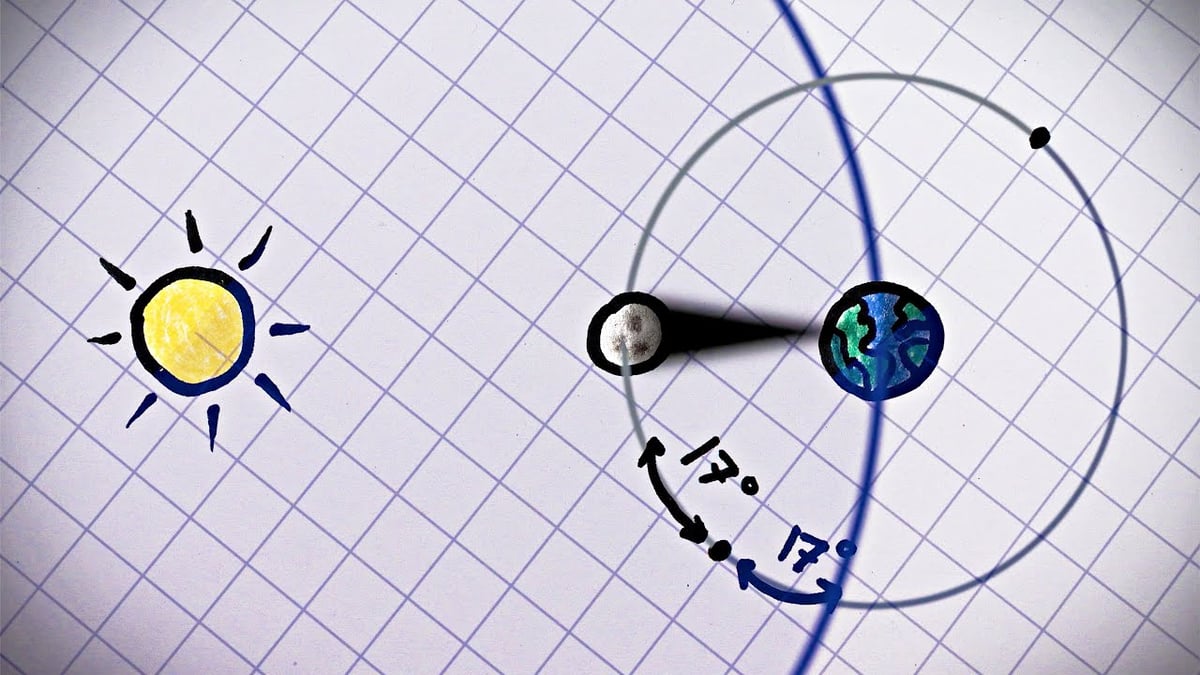


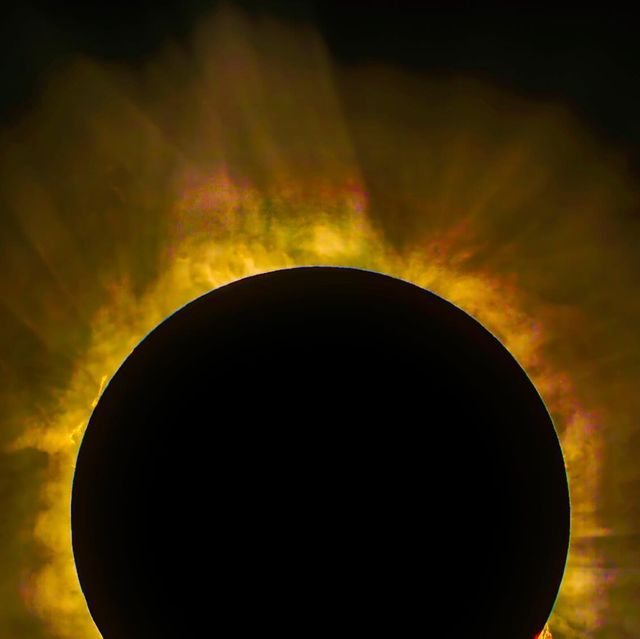

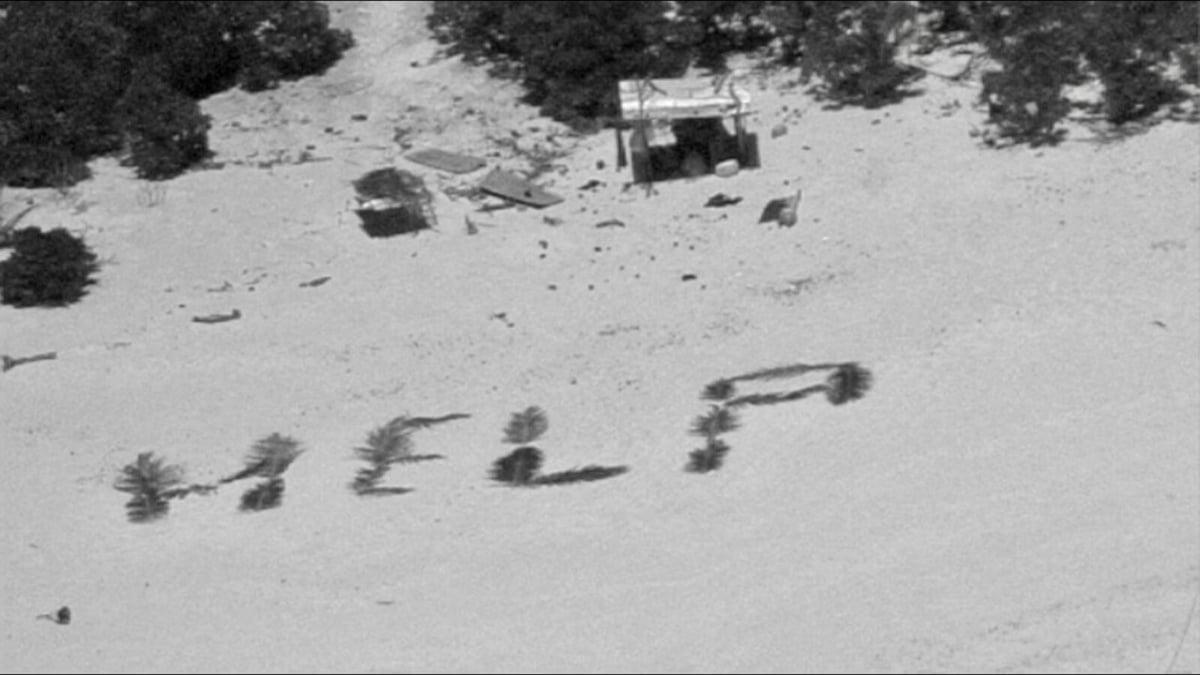

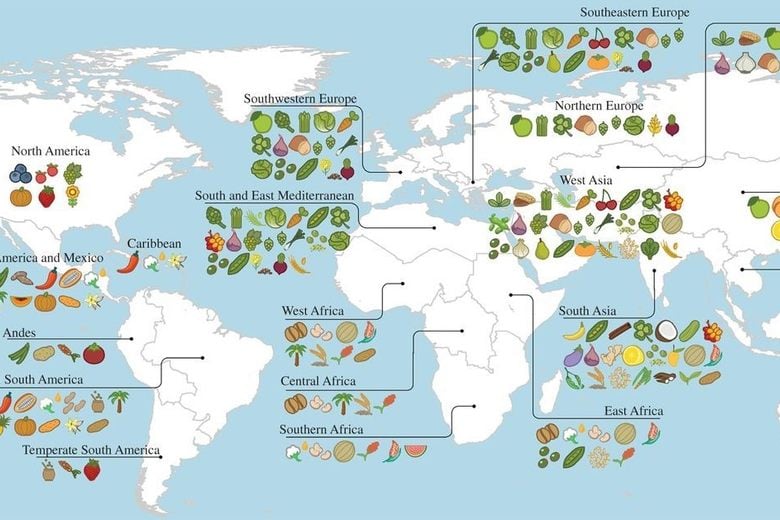
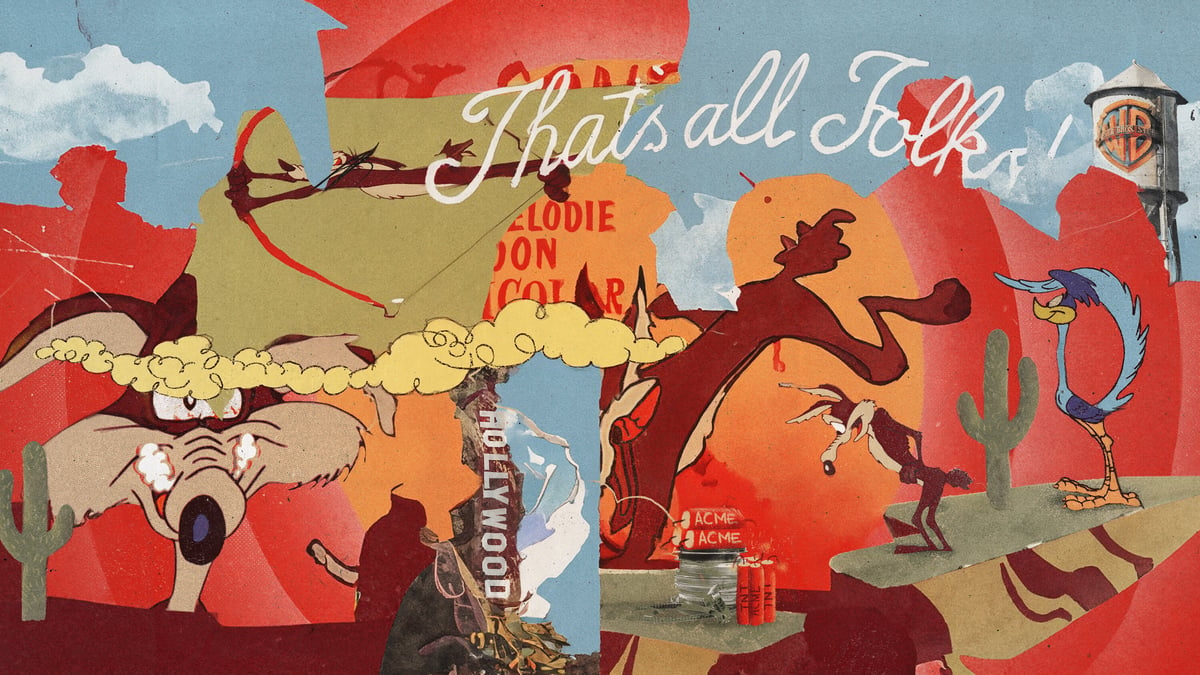
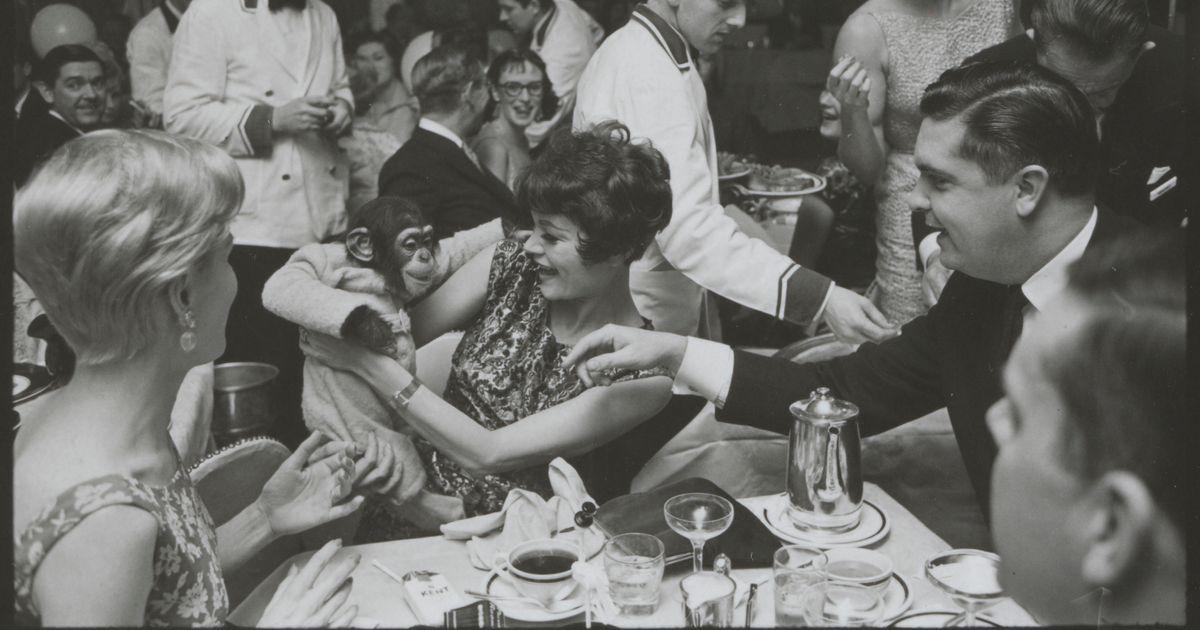







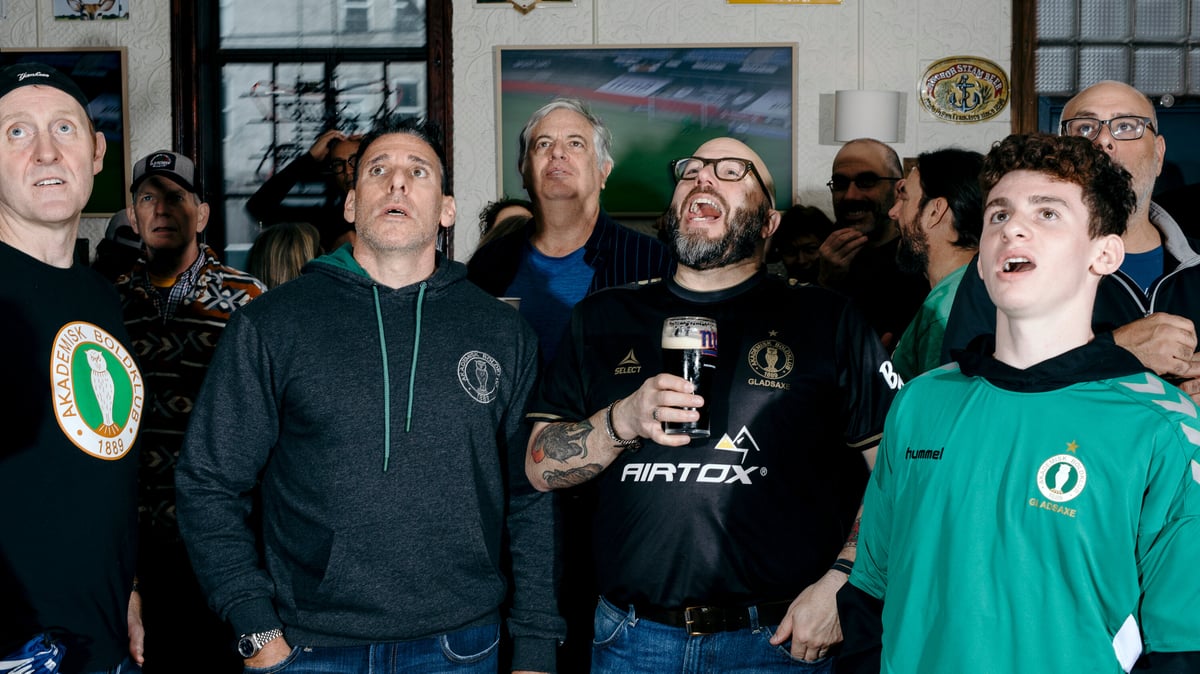




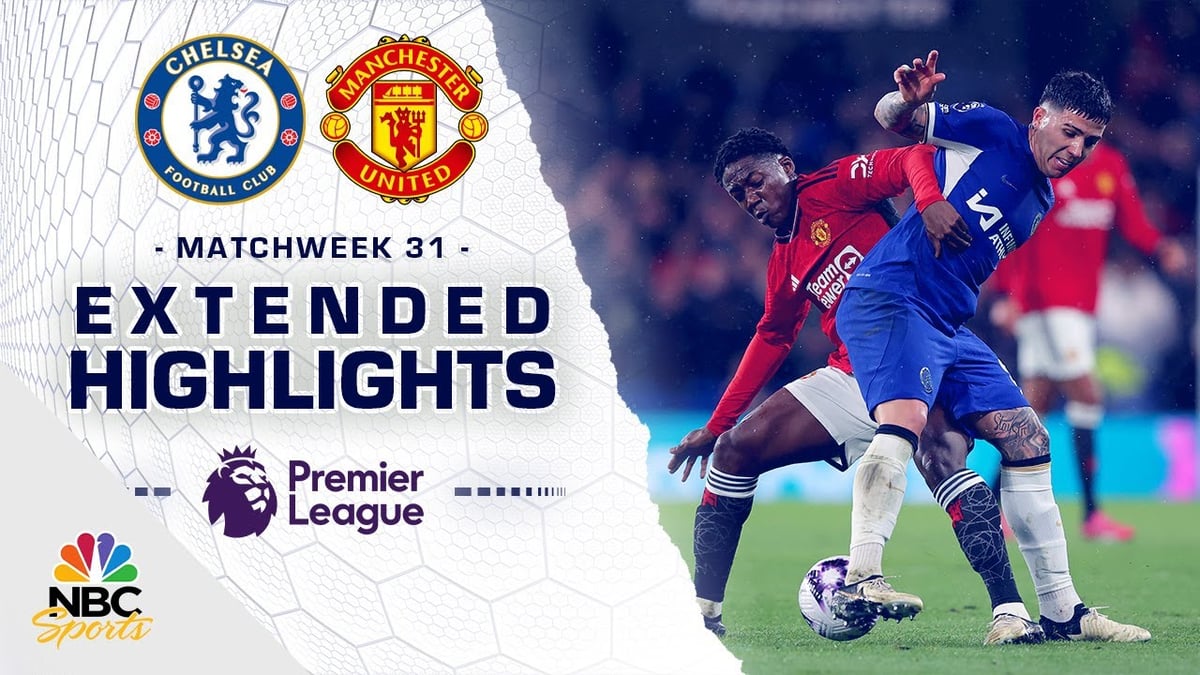


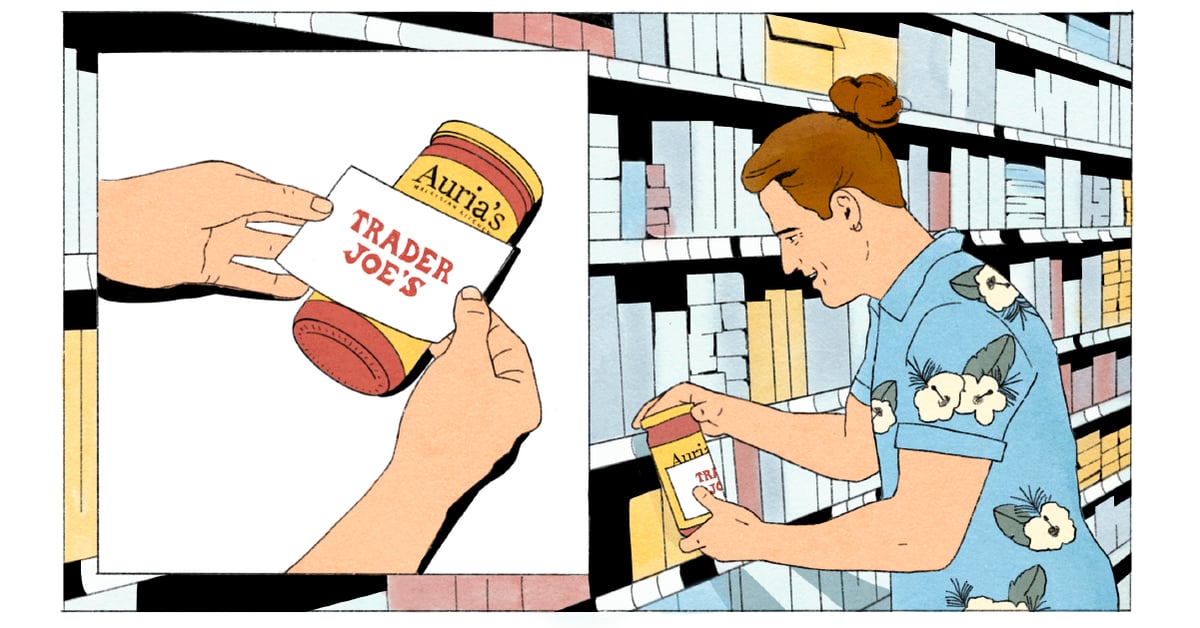

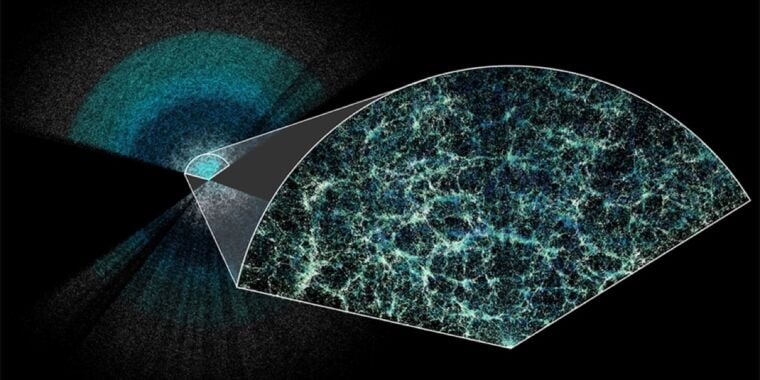

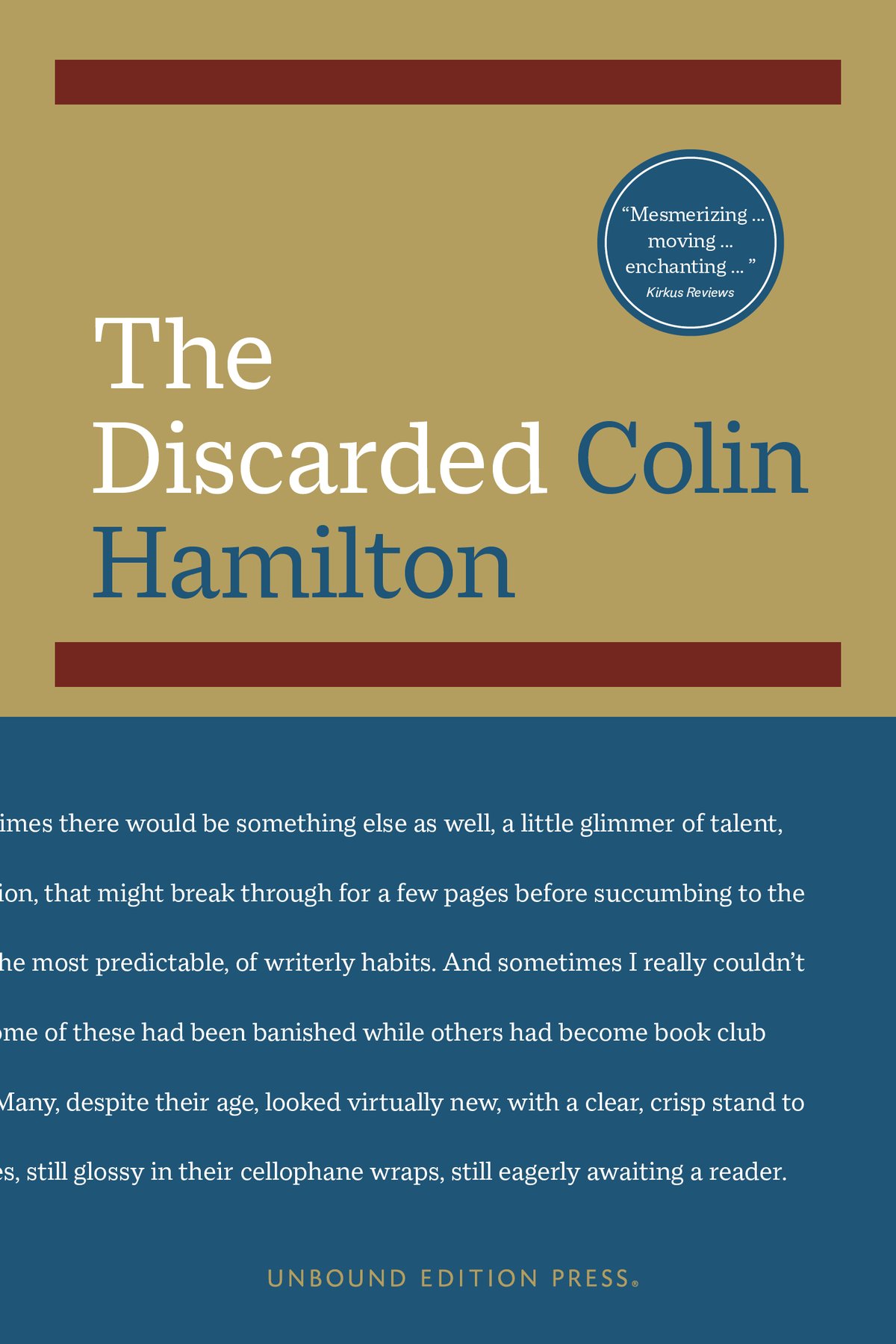


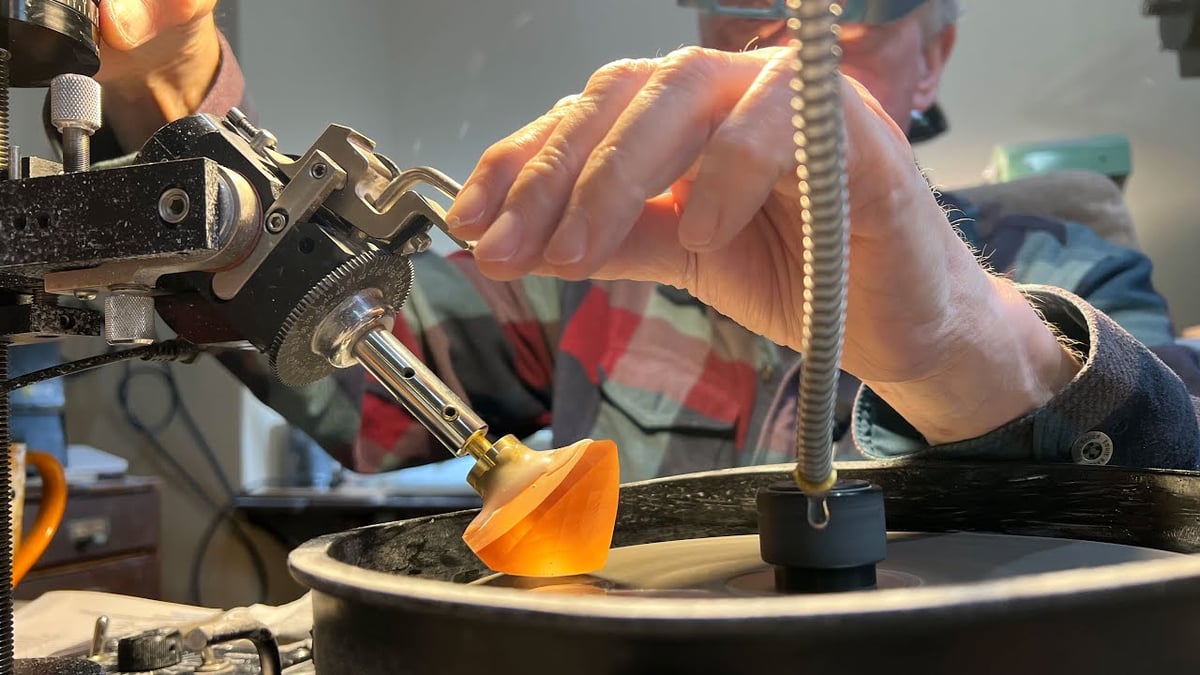
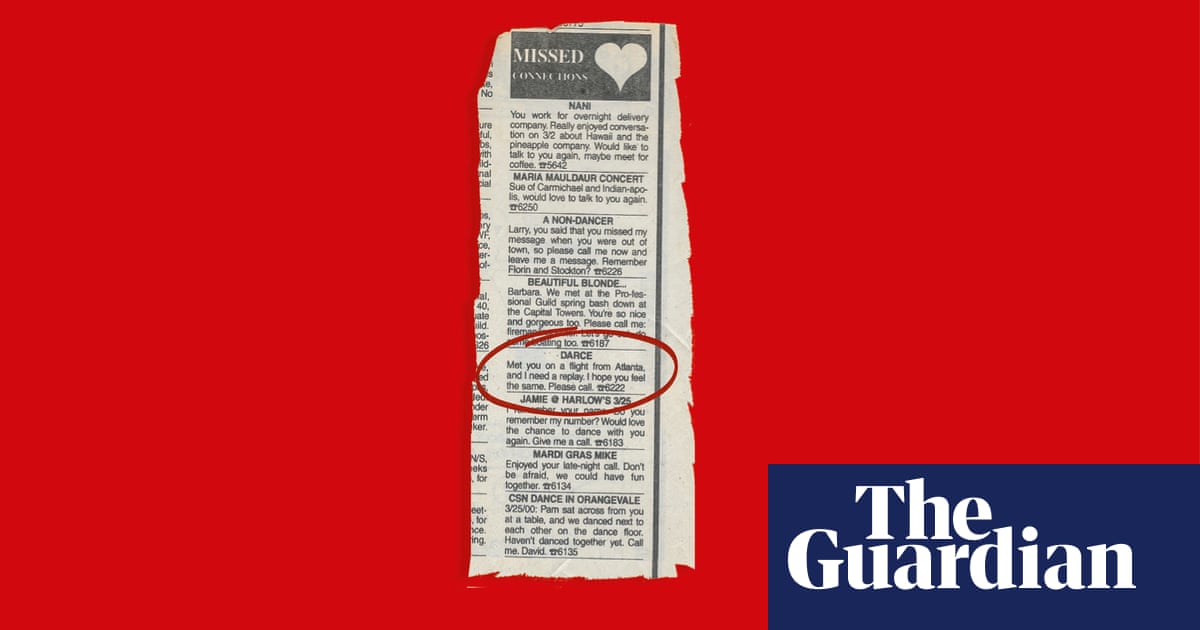
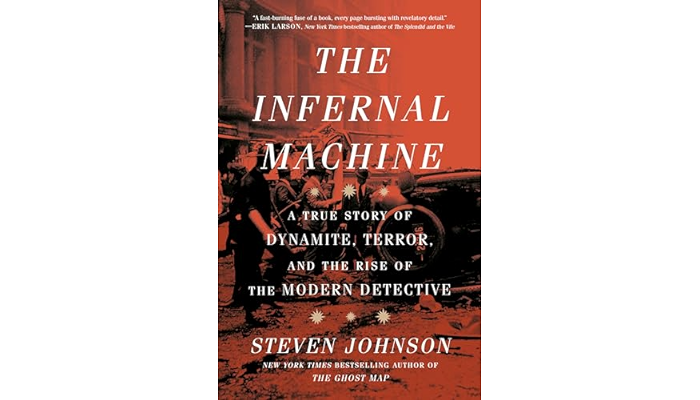


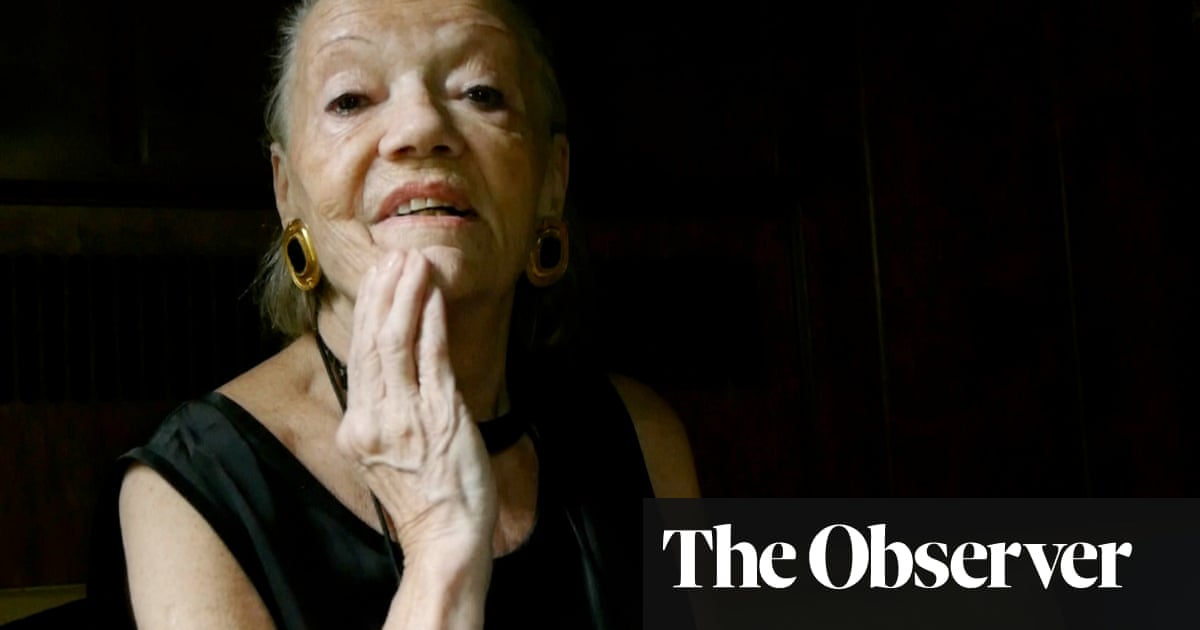

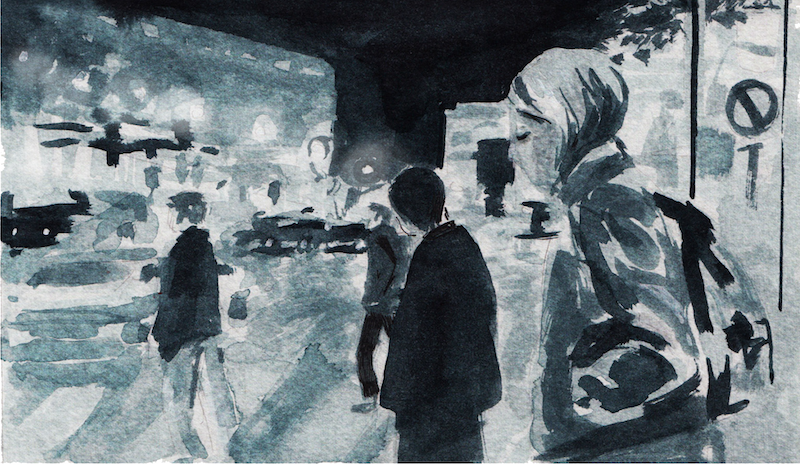
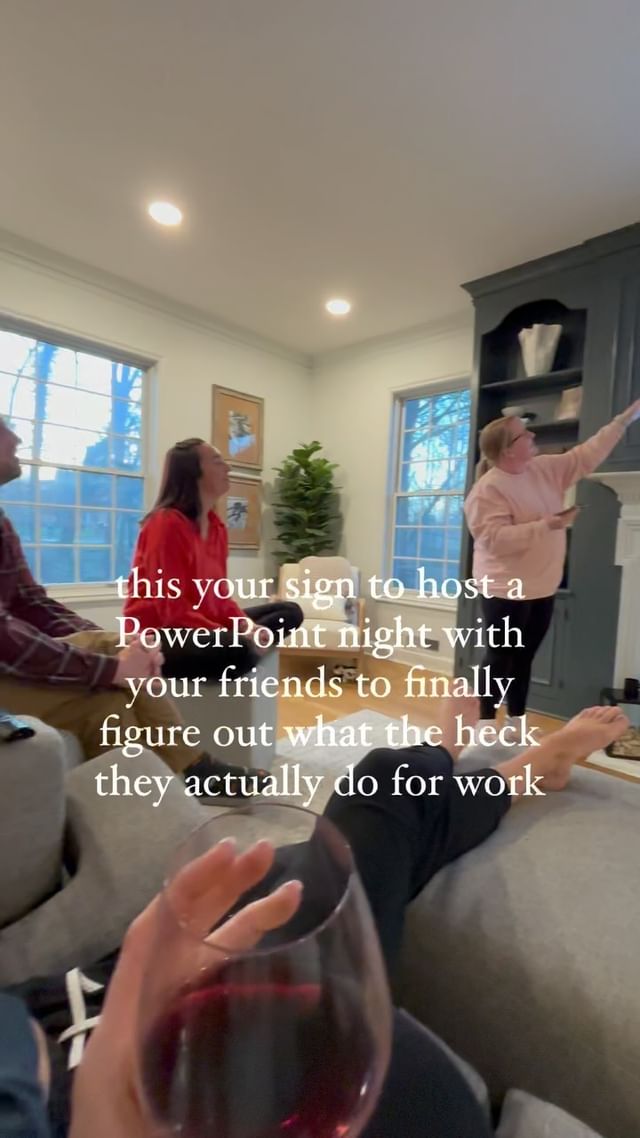
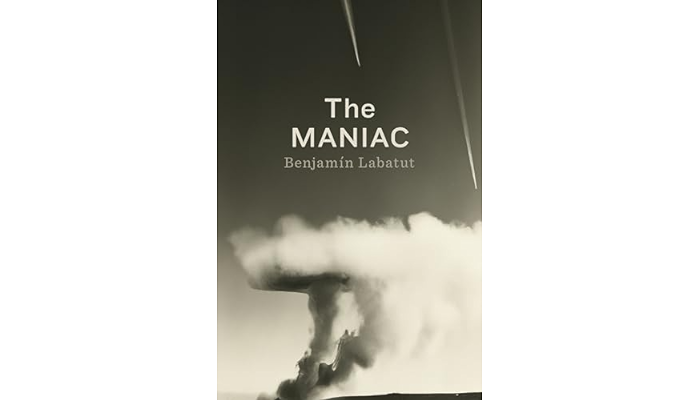



Stay Connected